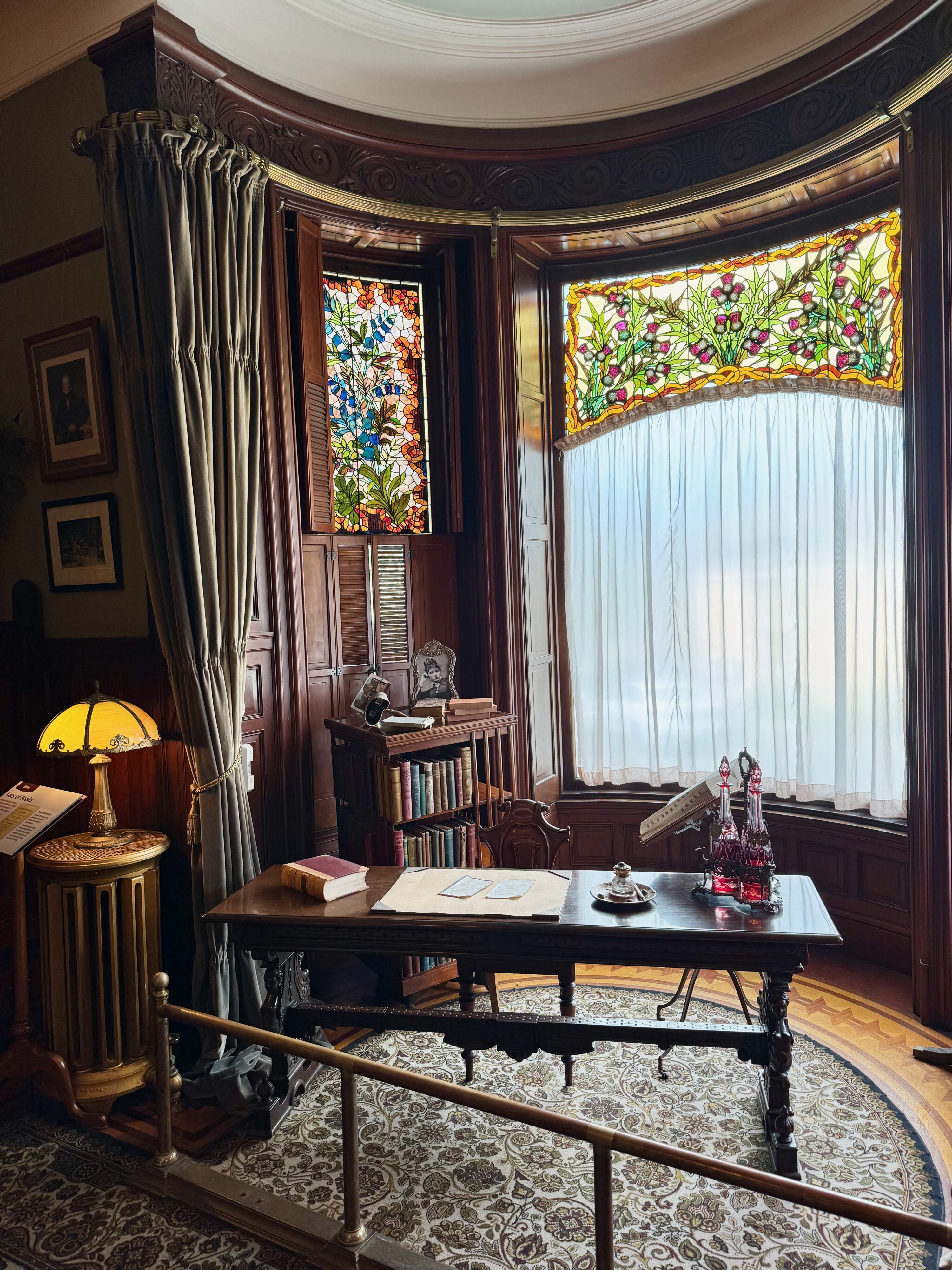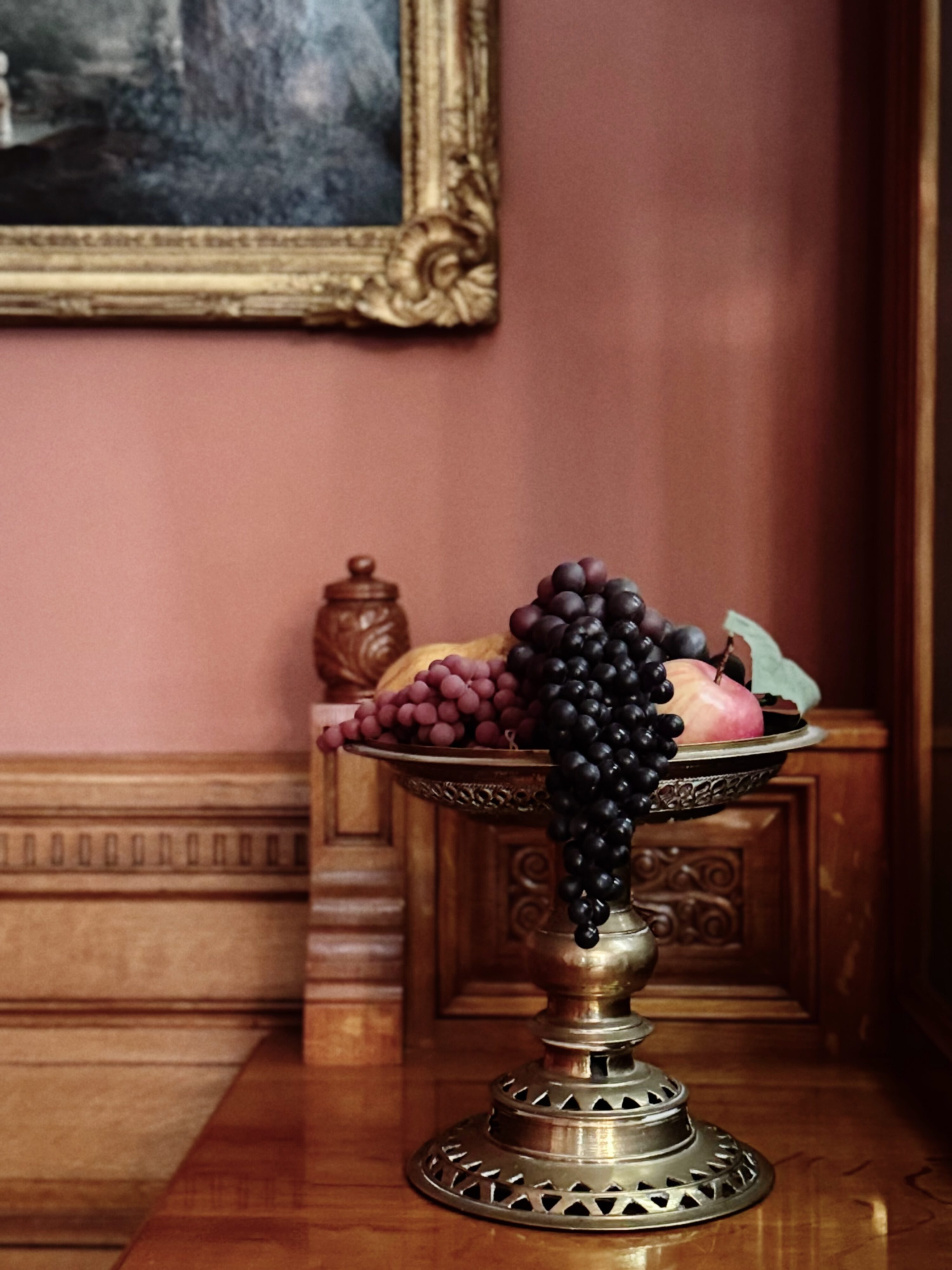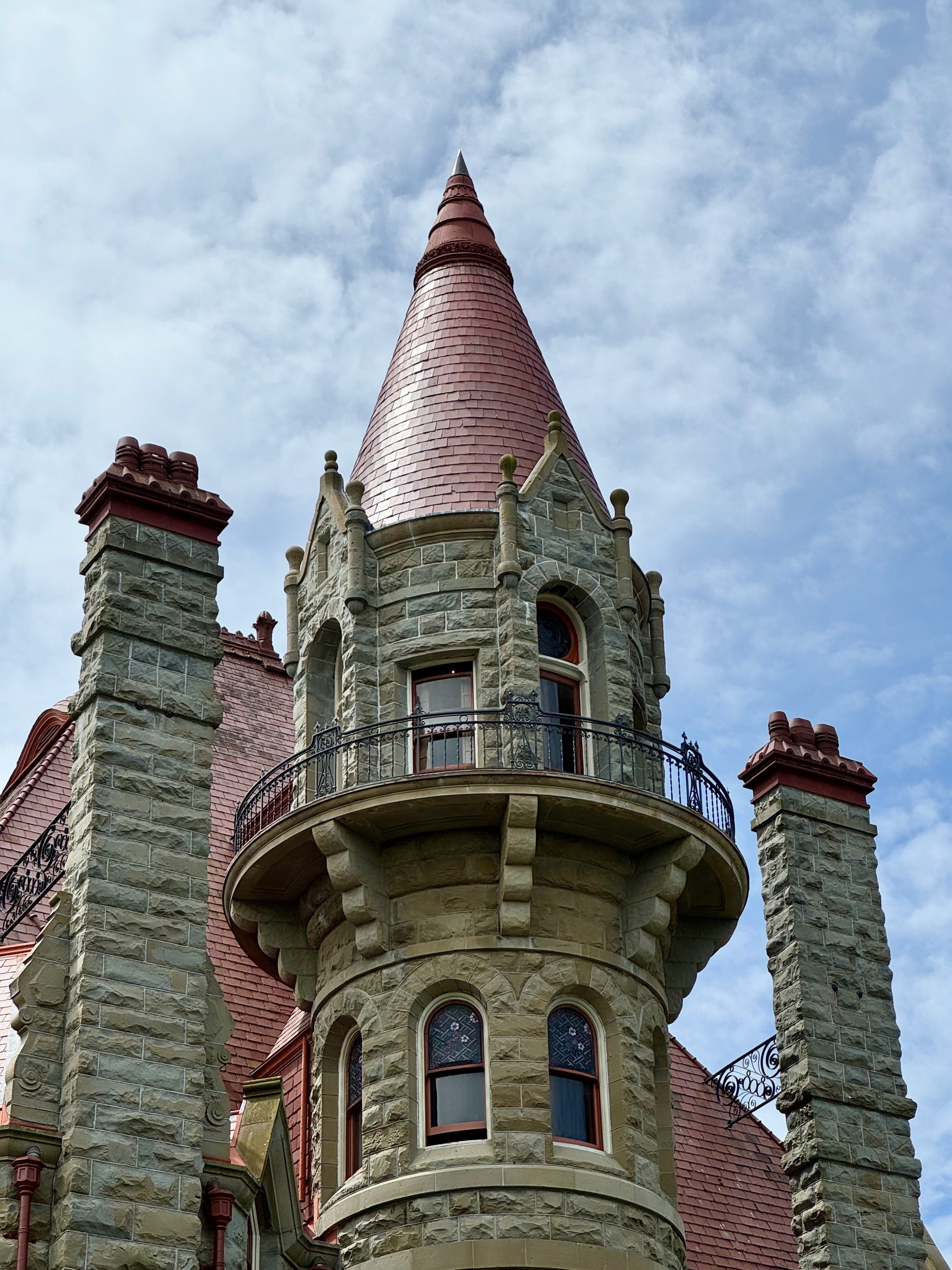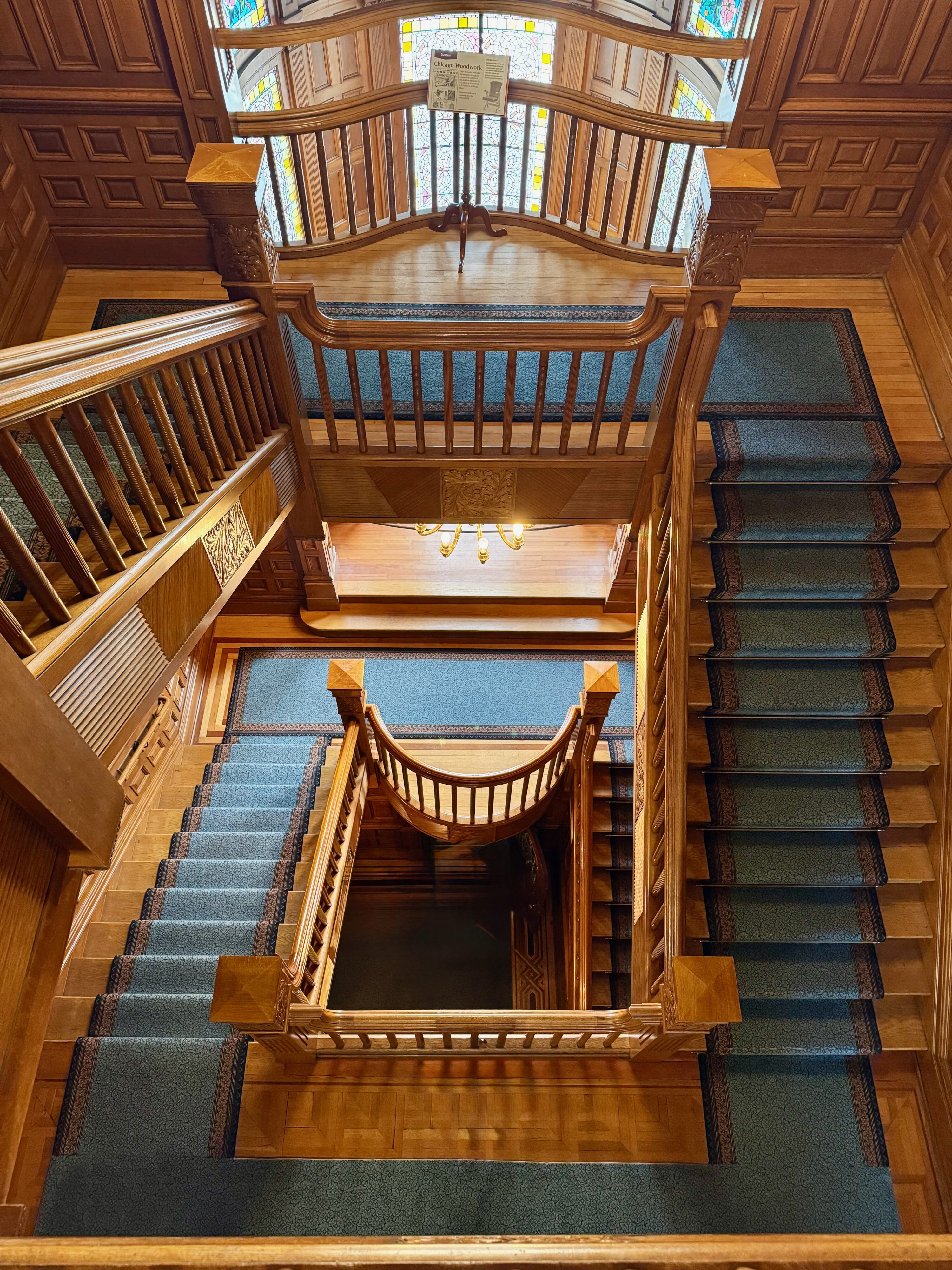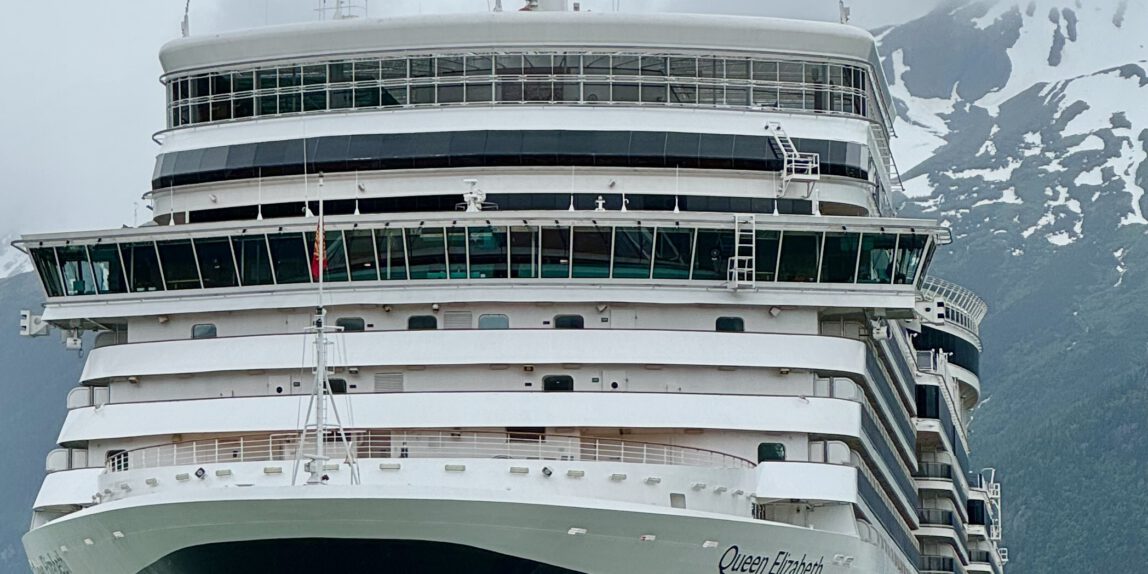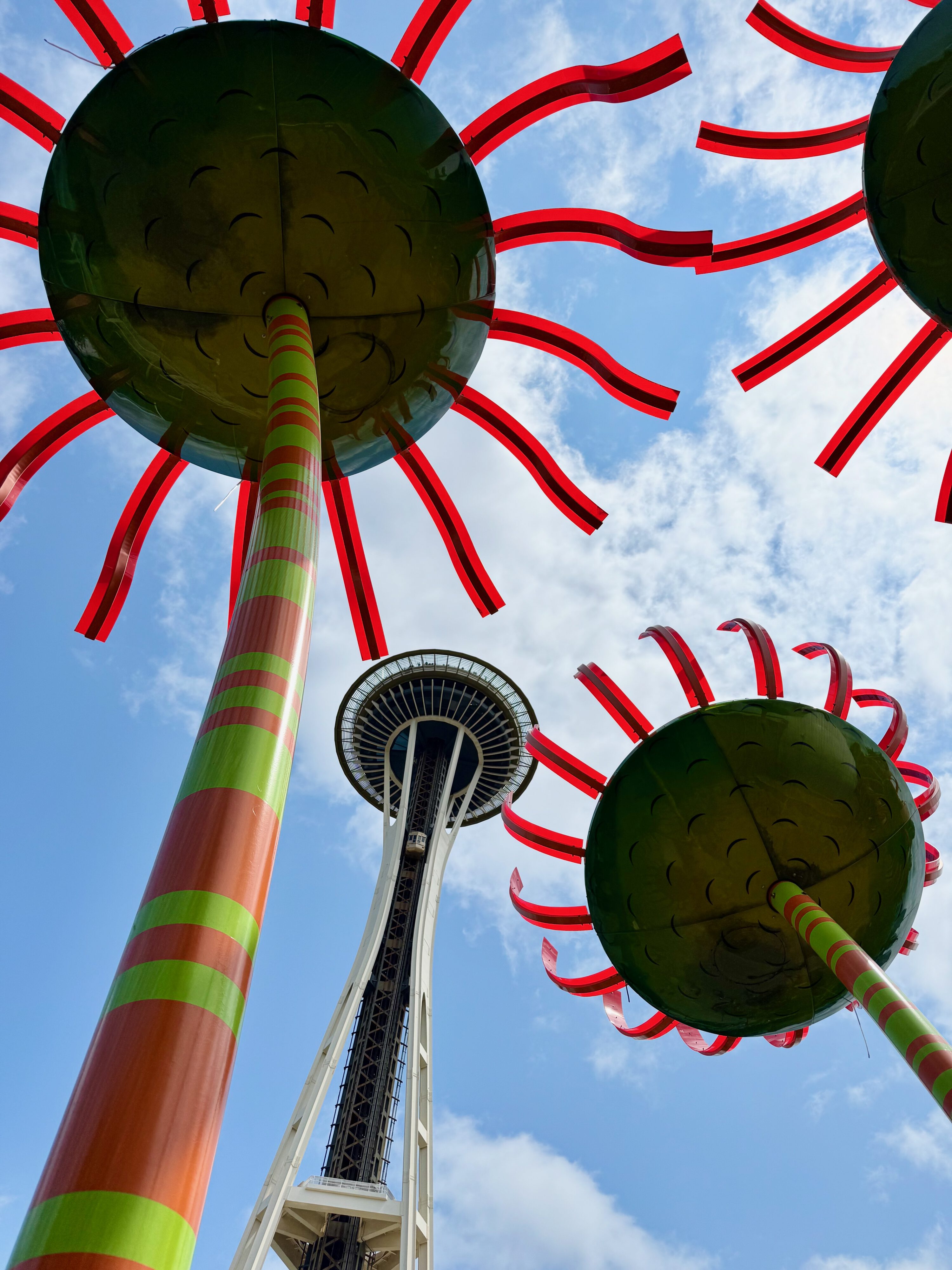
zur deutschen Version wechseln…
Before Embarkation: Seattle
Space Needle: The Space Needle is one of the most iconic landmarks in the United States and a symbol of Seattle, Washington.
The Space Needle’s “flying saucer” top and slender legs reflect the 1960s fascination with space and the future. It was designed to withstand earthquakes up to 9.0 magnitude and strong winds, showcasing engineering innovation.
Built for the 1962 World’s Fair themed “The Age of Space”, the Space Needle captured the excitement of the Space Race era. It symbolized modernity and progress during the Cold War era, resonating deeply with American culture at the time.
The observation deck provides 360-degree views of Seattle and the surrounding natural beauty—mountains, water, and cityscape.
The recent $100 million renovation added The Loupe, the world’s first and only rotating glass floor.
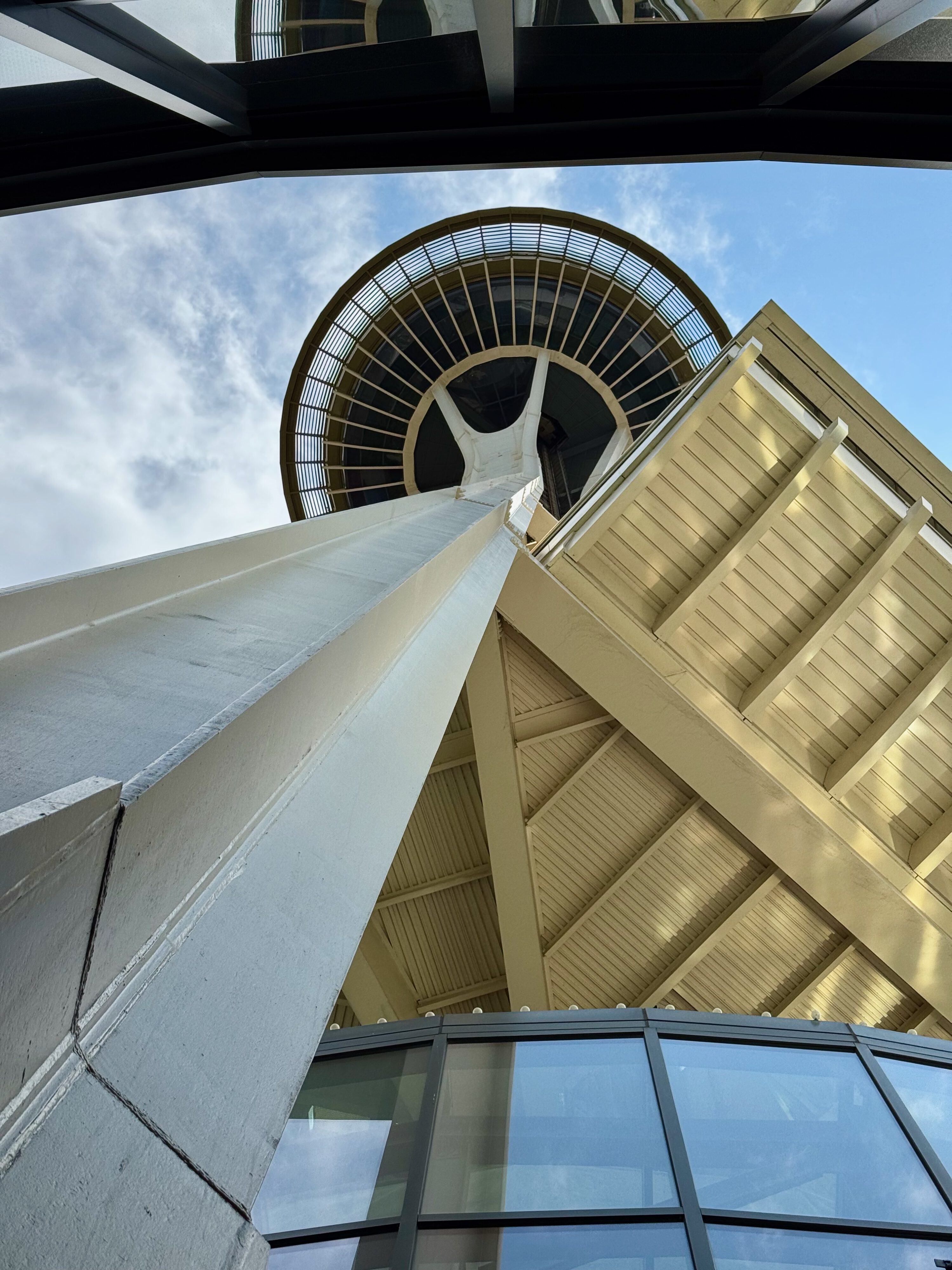
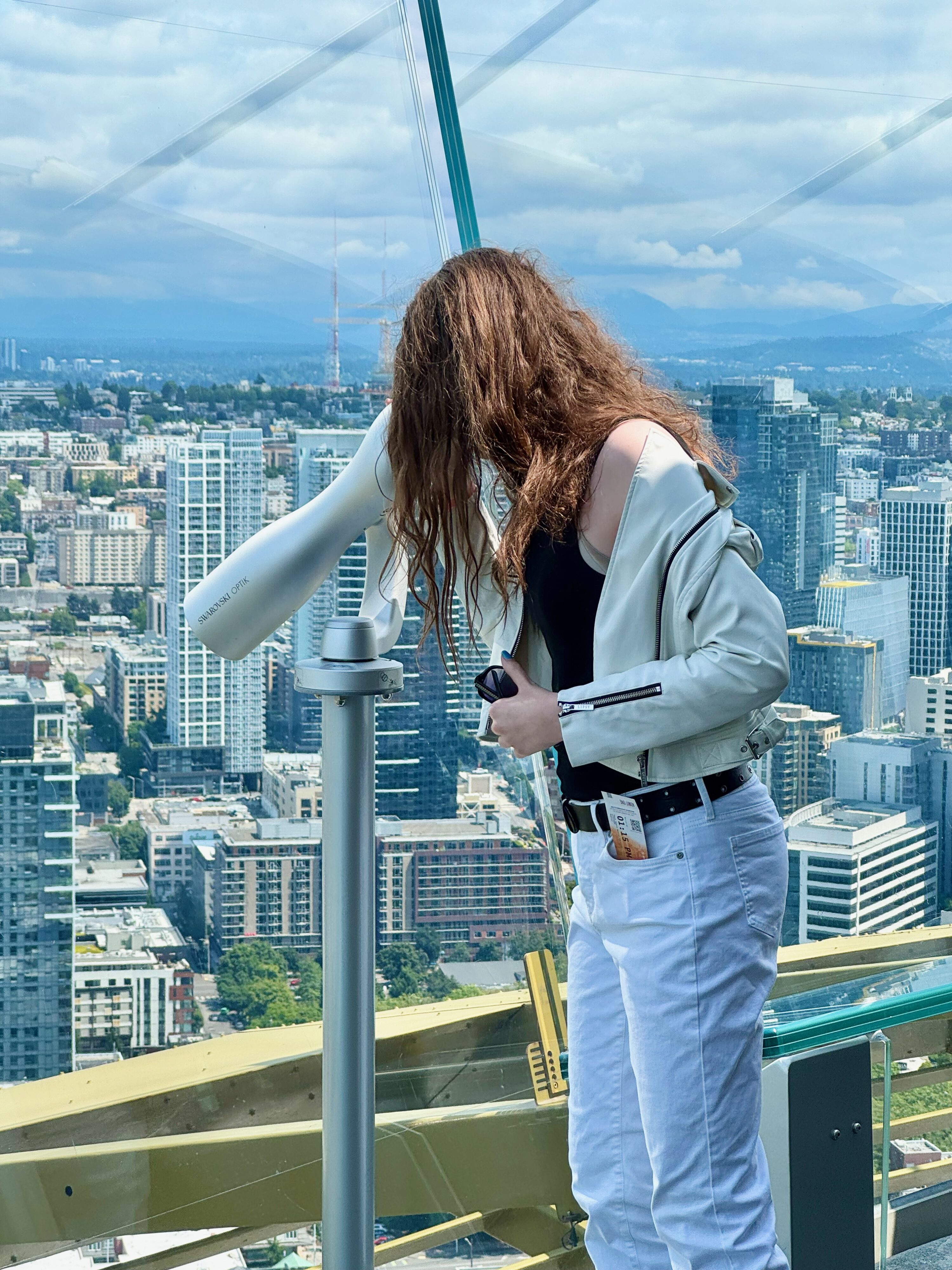
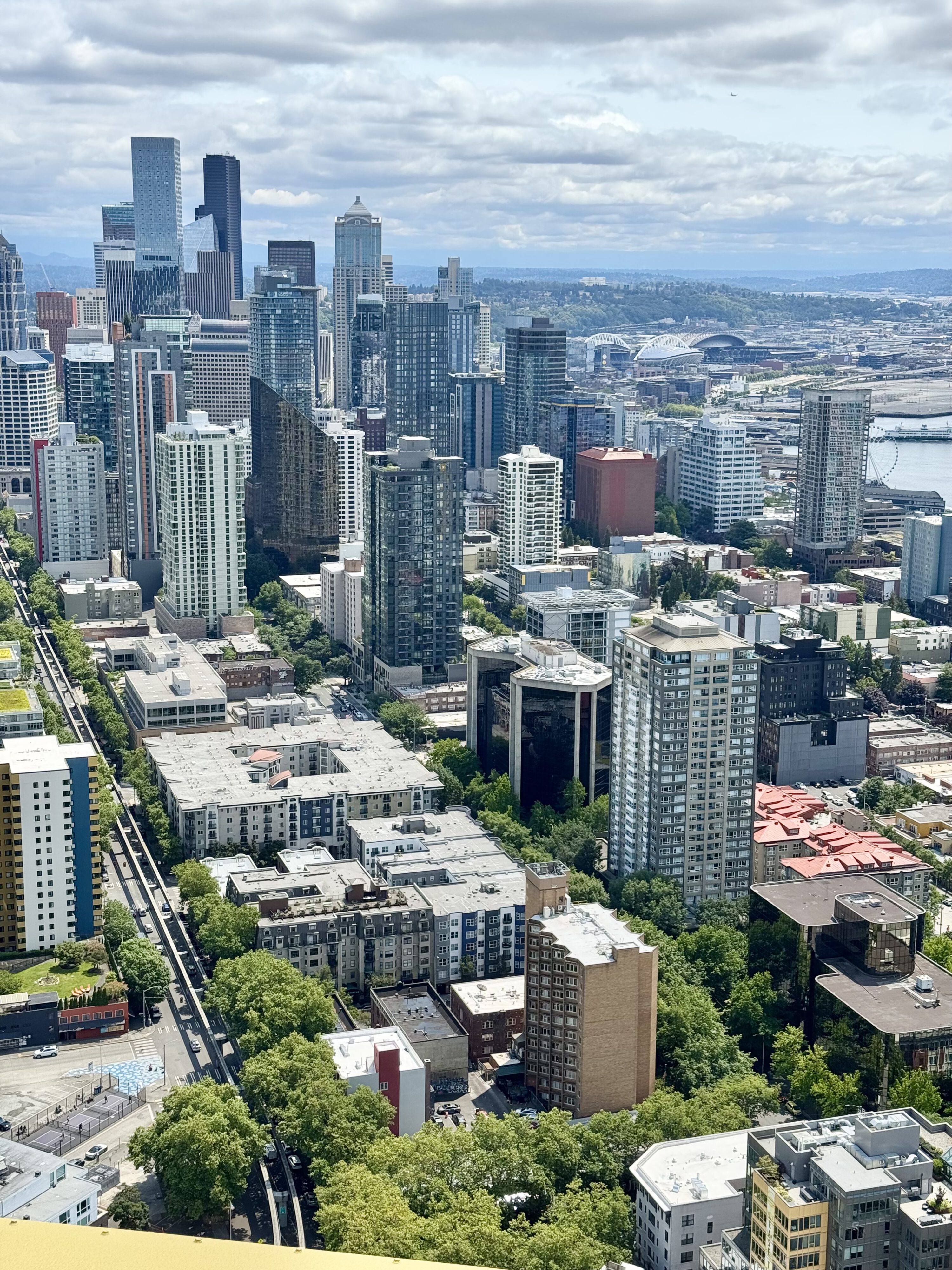
The Museum of Pop Culture (MoPOP) in Seattle, formerly known as the Experience Music Project (EMP), is a vibrant, immersive museum dedicated to celebrating and exploring contemporary popular culture—from music and movies to video games, sci-fi, and more.
Quick Facts:
Opened: 2000
Founder: Paul Allen (co-founder of Microsoft)
Location: Next to the Space Needle in Seattle Center
Architect: Frank Gehry (known for his unconventional, fluid architecture)
Original Name: Experience Music Project (EMP)
The building itself is a work of art—designed by Frank Gehry, it features a wildly curved, colorful exterior made of stainless steel and aluminum. People either love it or hate it, but they definitely remember it.
MoPOP dives deep into music, film, video games, science fiction, fantasy, horror, and other elements of pop culture.
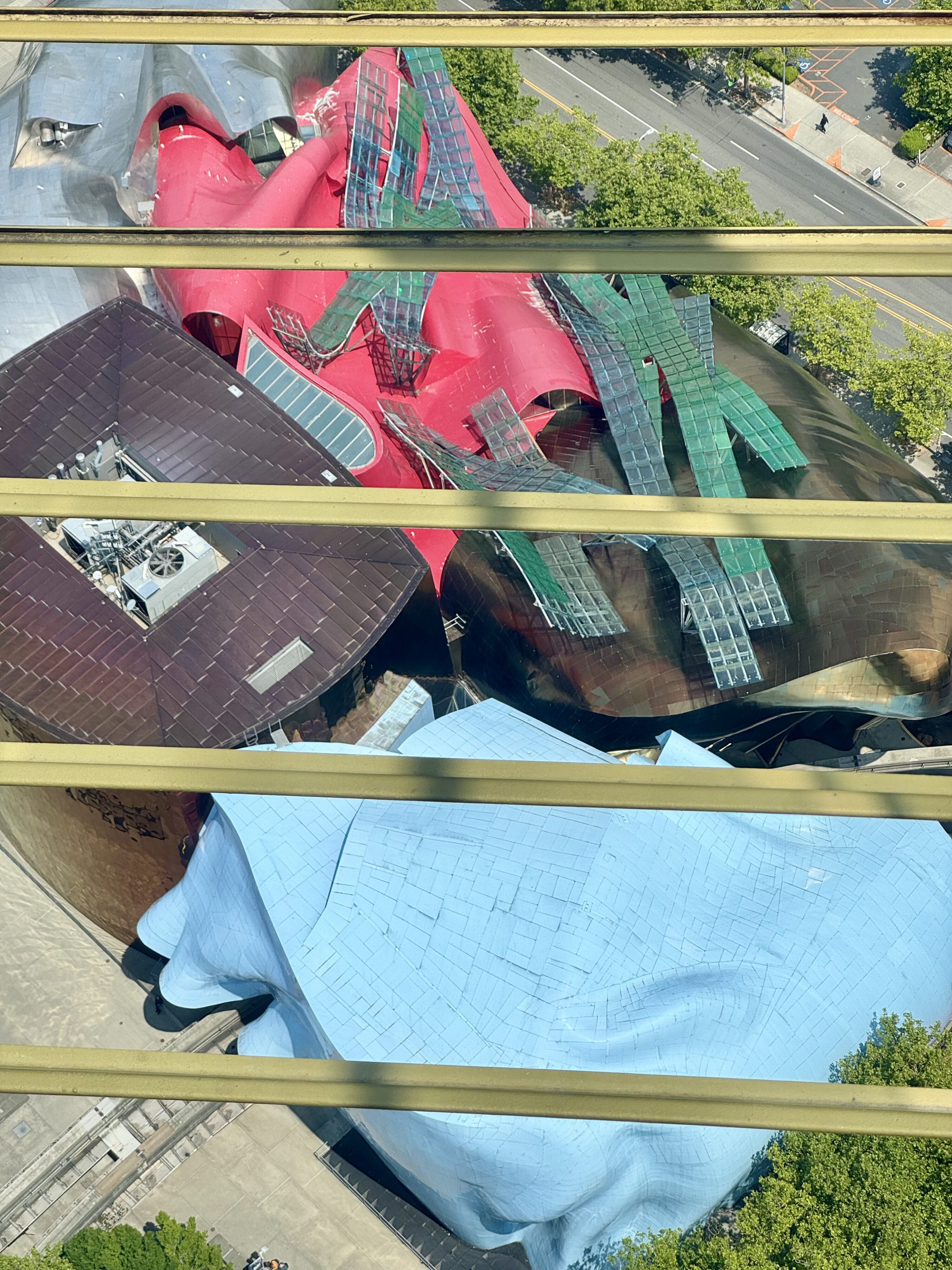
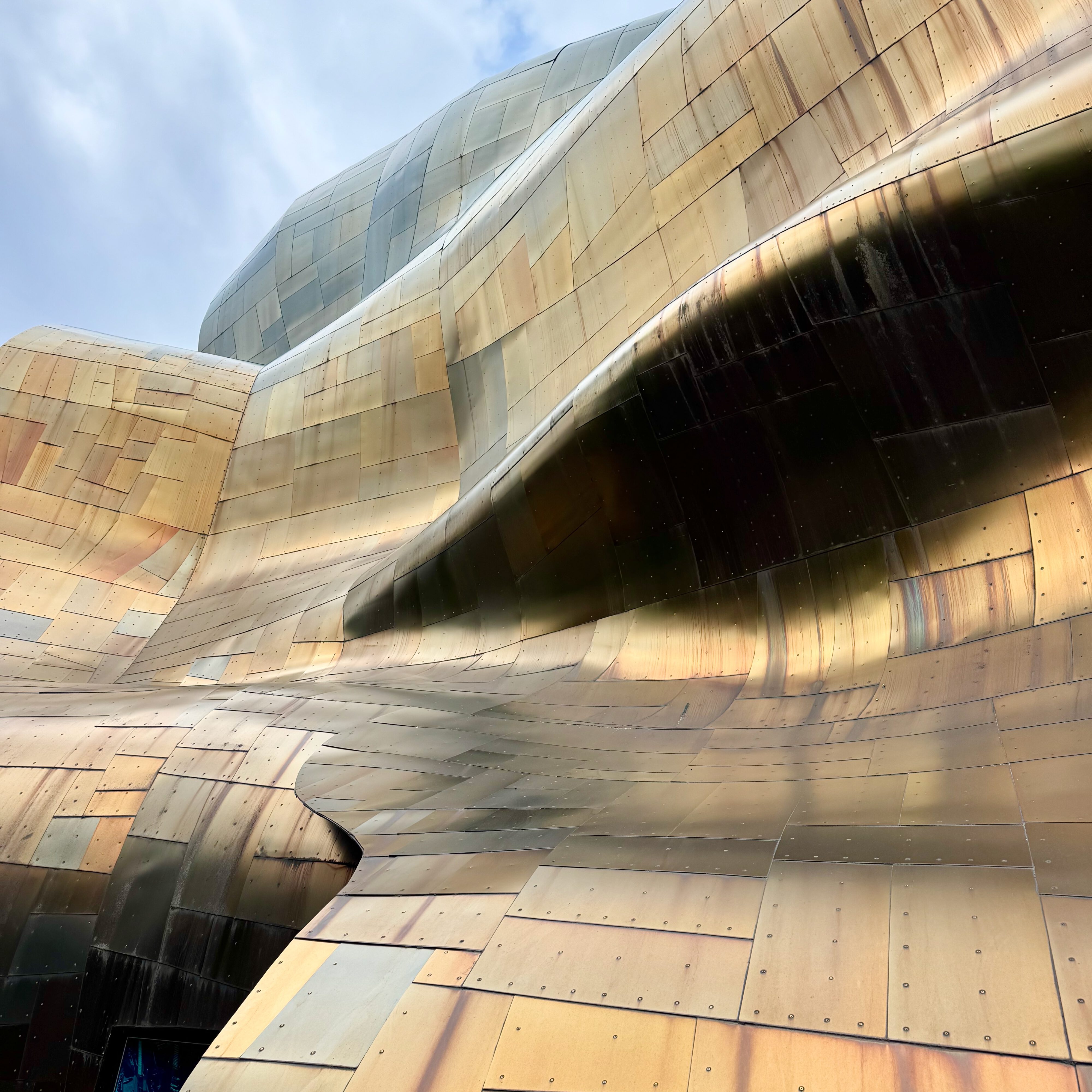
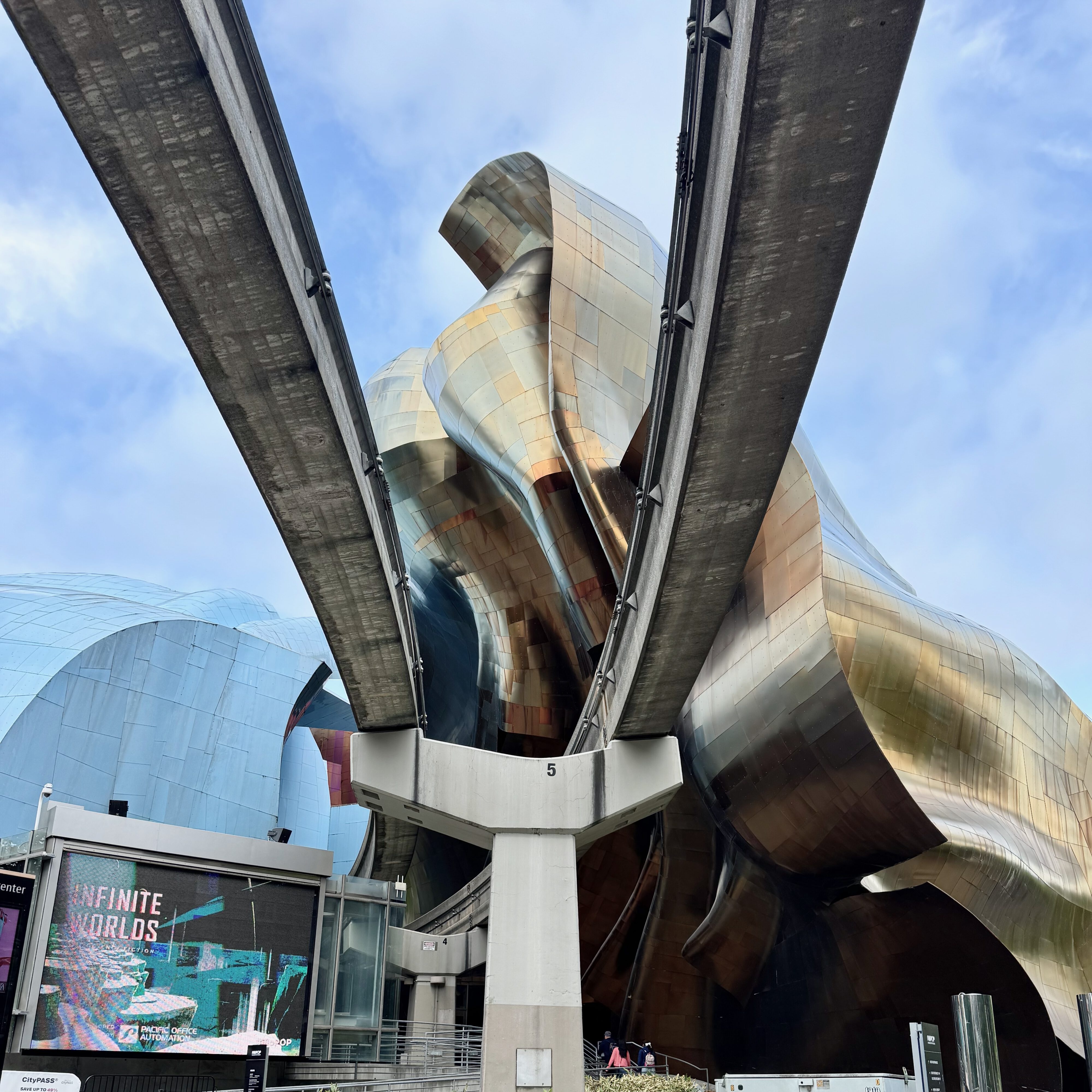
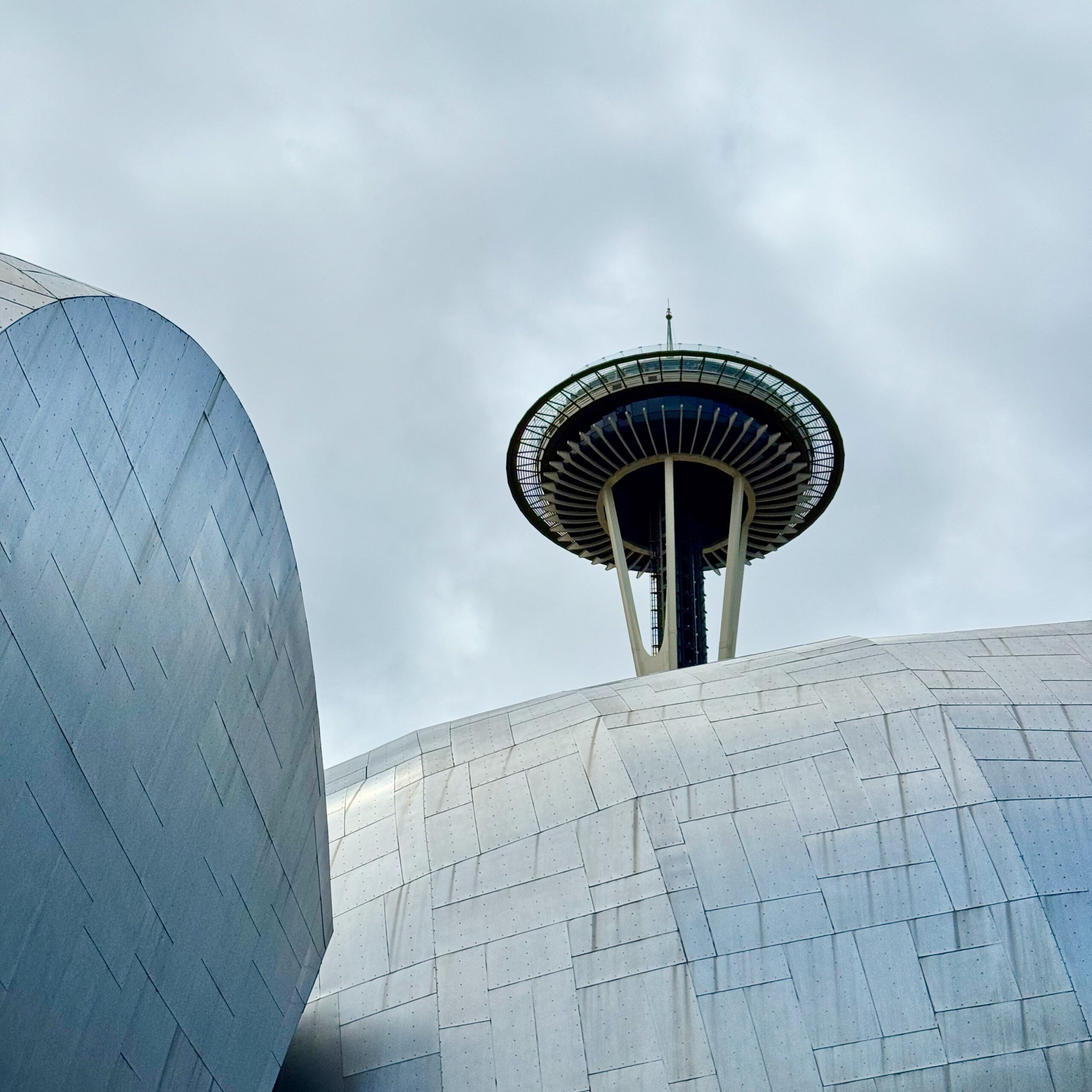
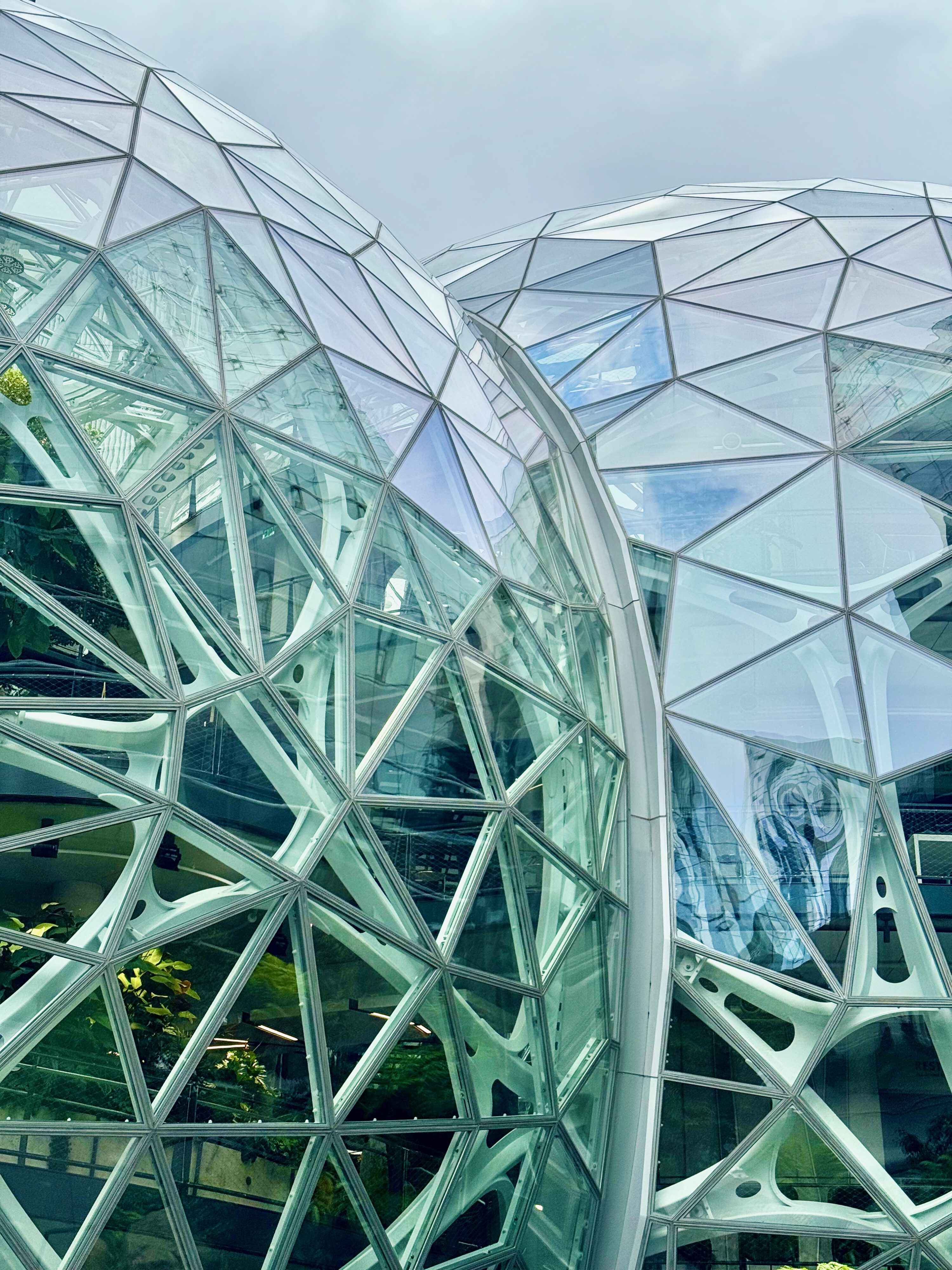
The Amazon Spheres and the surrounding Amazon campus in downtown Seattle represent a striking blend of futuristic architecture, urban planning, and tech-driven innovation. They’re not just offices—they’re a statement about how work, nature, and city life can coexist.
The Amazon Spheres are an architectural and engineering marvel that blend nature, science, and design in a way few office spaces ever attempt. Designed by NBBJ (a Seattle-based architecture firm), the Spheres are both a high-tech greenhouse and a workplace — redefining what an urban tech campus can look like.
What’s inside the Speres? Over 40,000 plants from more than 50 countries. A mini rainforest ecosystem with high humidity and custom lighting. “Bird’s nest” meeting spaces, treehouse-like rooms, and walkways. Not a public co-working space, but open to public tours on select days (via Amazon HQ Tours or Understory exhibit).
The Amazon campus around the Spheres spans more than 40 buildings and includes:
Day 1 Tower (Main HQ tower), Doppler Building (Named after the internal code name for Amazon Echo: Includes a large cafeteria, open workspaces, and bike facilities), Rufus 2.0 (Named after a beloved Amazon office dog), Block 21, Block 20, re:Invent, Nitro, Houdini, etc. (Amazon often names its buildings after products, projects, or internal codenames).
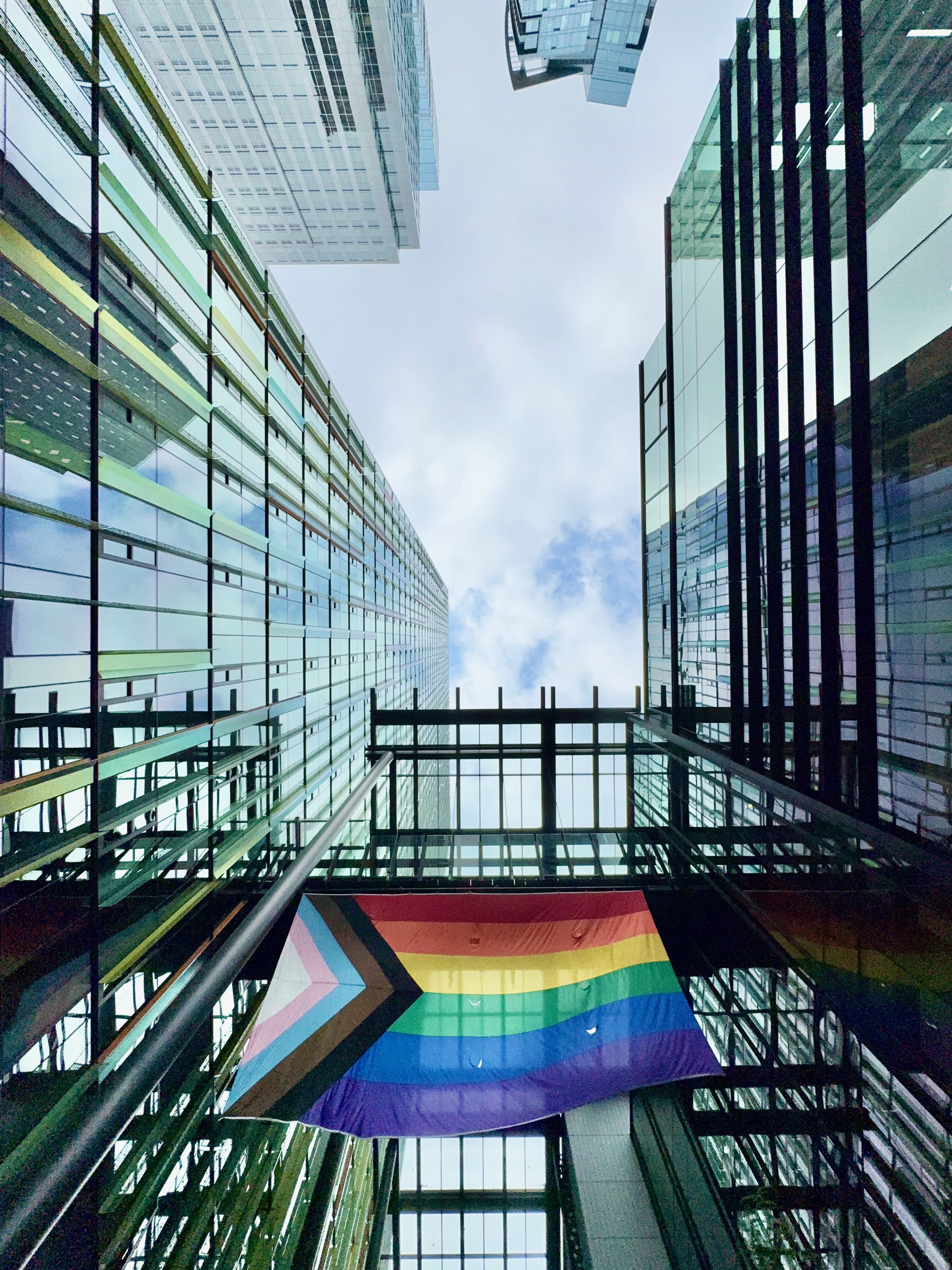
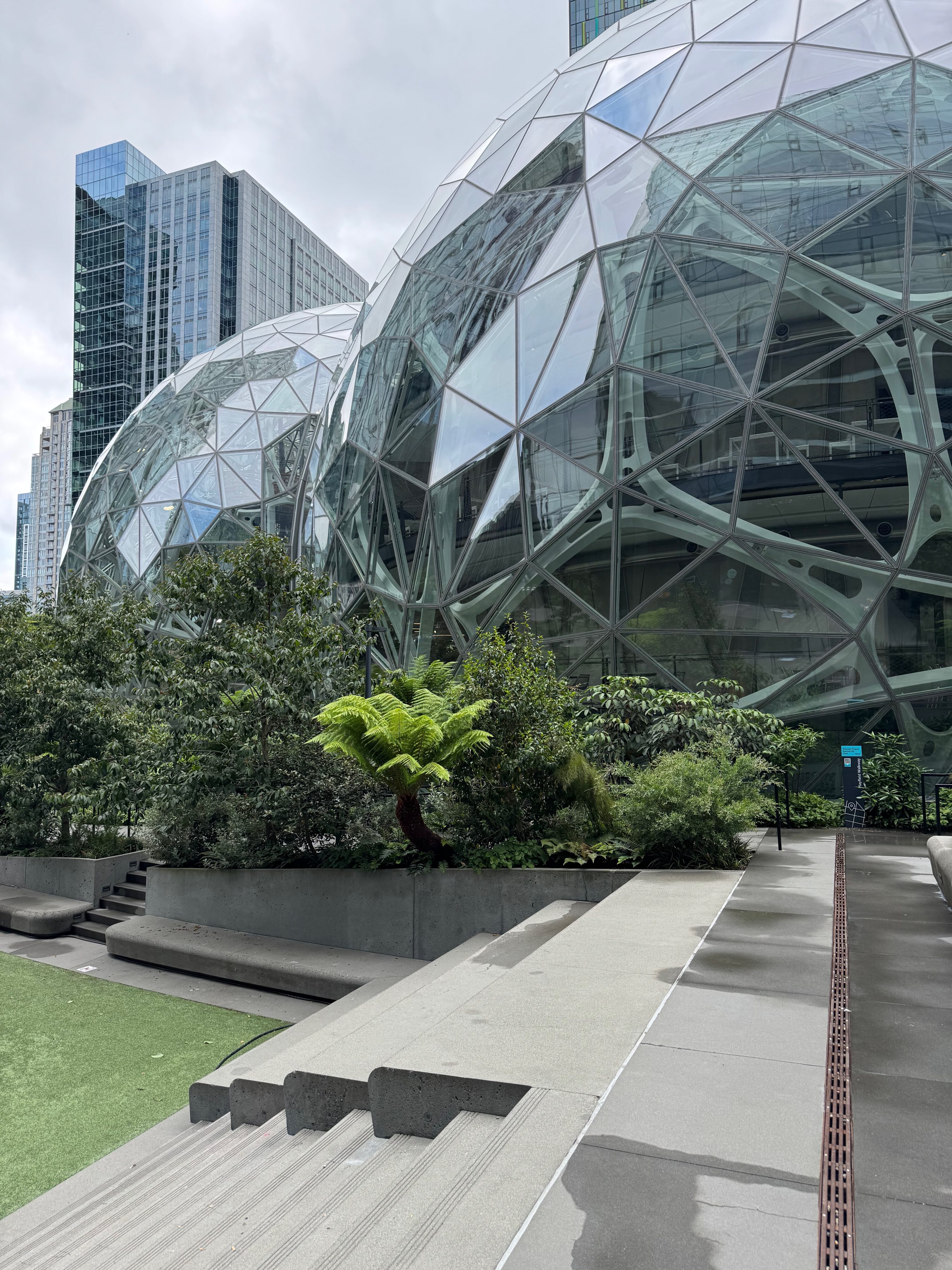
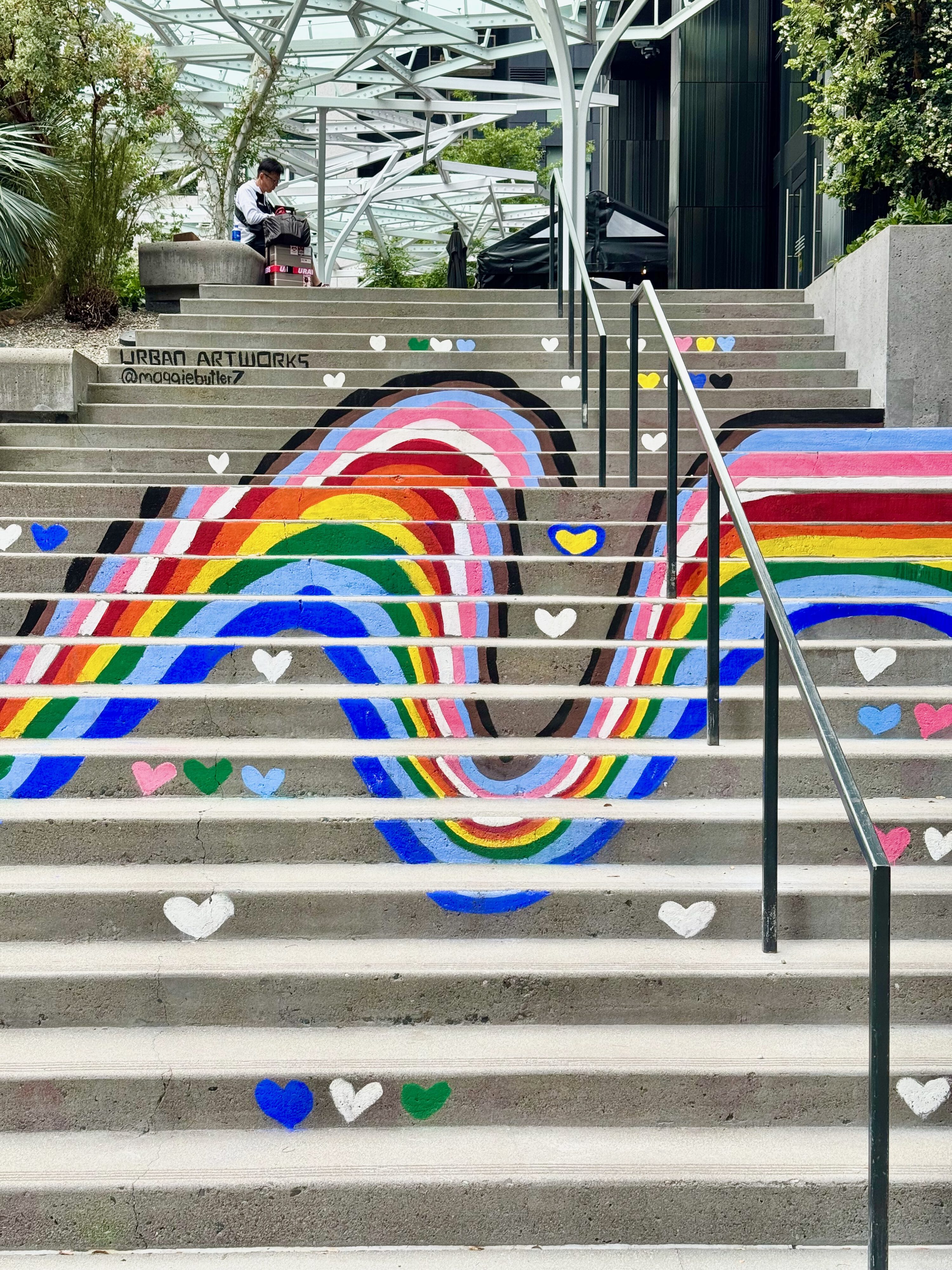
Scenic Cruising: Endicott Arm & Dawes Glacier
Endicott Arm and Dawes Glacier are some of the most spectacular natural wonders in Alaska’s Inside Passage.
What is Endicott Arm? A fjord: a long, narrow inlet carved by glaciers, about 30 miles long and lined with granite cliffs as high as 3,000 feet. Filled with floating icebergs, waterfalls, and abundant wildlife, with Dawes Glacier located at the end of Endicott Arm.
Endicott Arm is famous for its Epic Scenery and Wildlife Encounters:
- Sheer granite cliffs, waterfalls tumbling from hanging valleys, and glacial blue waters create a surreal, almost otherworldly environment.
- Dawes Glacier is one of the few places where you can safely see glacier calving up close — a thunderous, awe-inspiring experience.
Common sightings include: harbor seals resting on icebergs, bald eagles, bears, mountain goats, whales and porpoises in nearby waters.
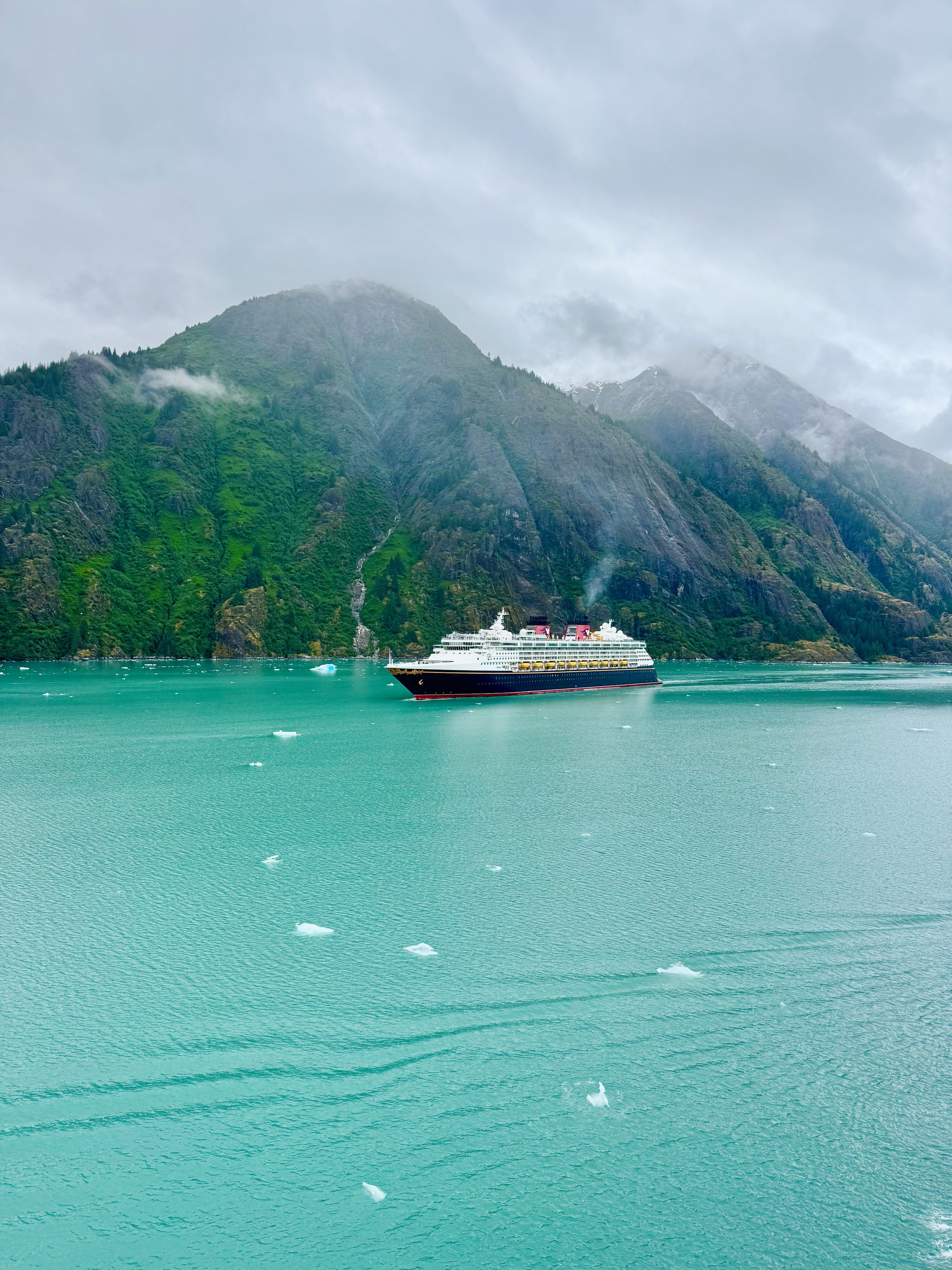
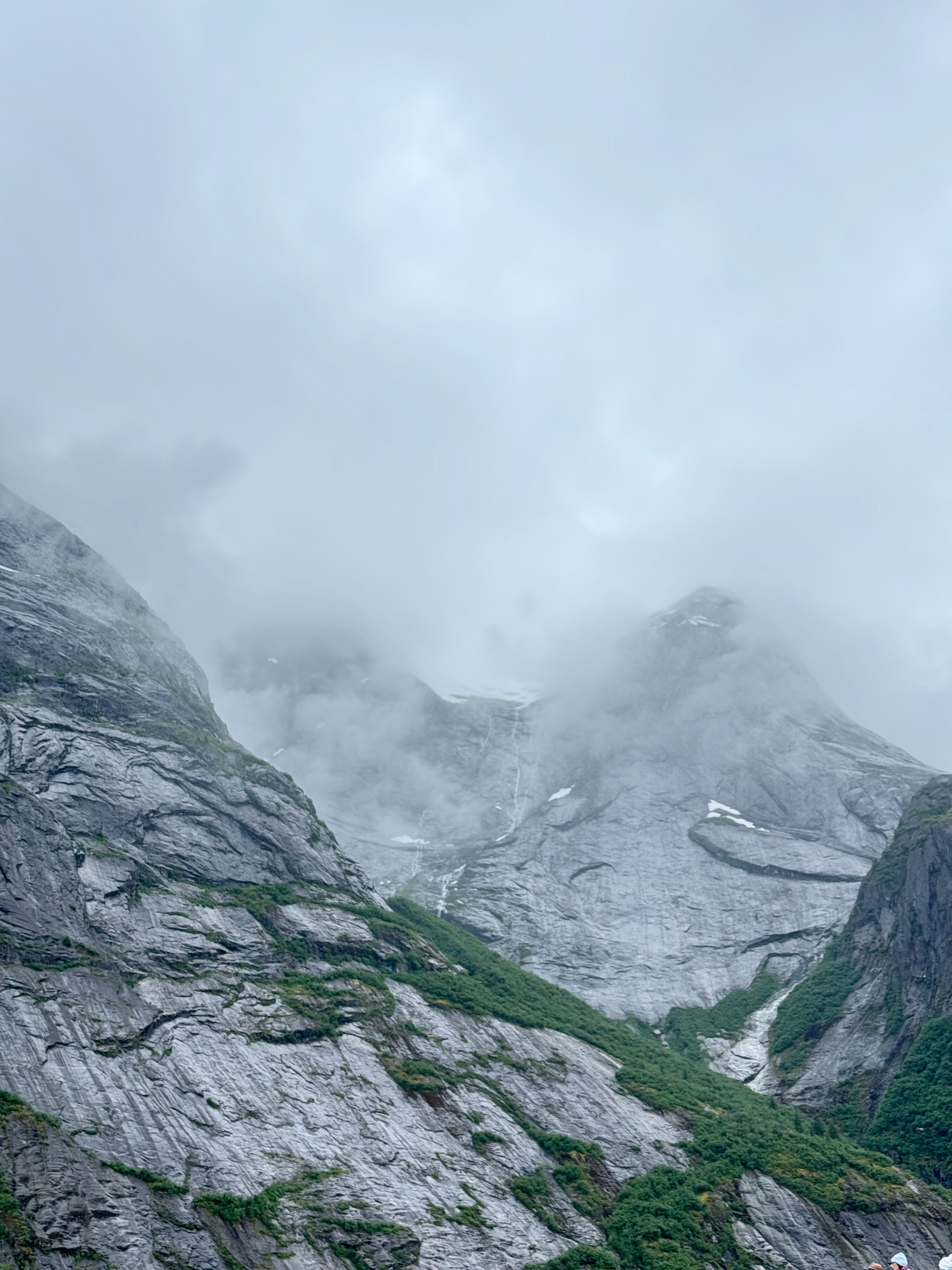
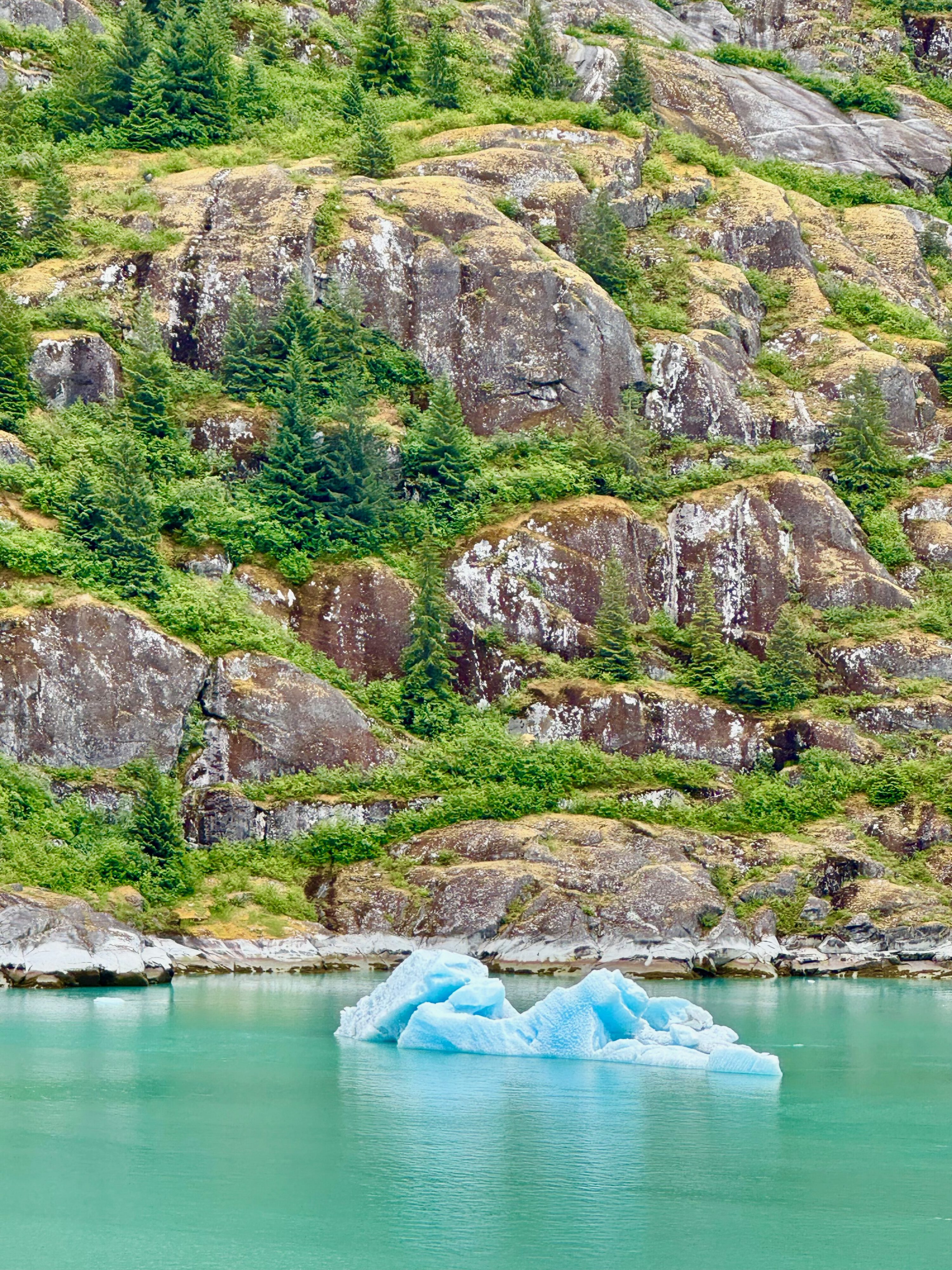
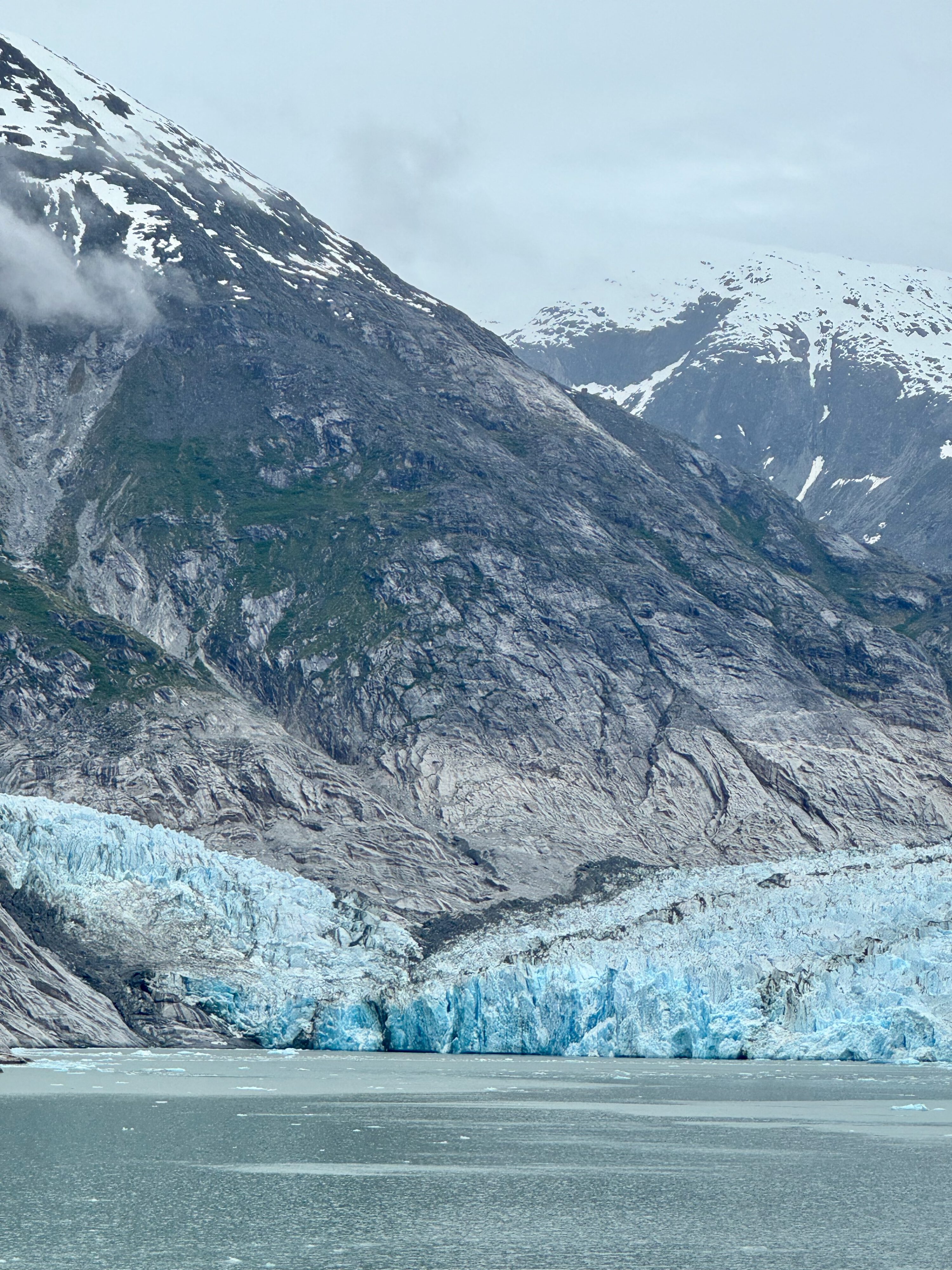
First Port of Call: Hoonah & Icy Strait Point
Hoonah and Icy Strait Point are hidden gems on Chichagof Island in southeast Alaska. While small in size, they pack a rich combination of Native Tlingit culture, wildlife encounters, and authentic Alaskan experiences that make them a memorable and worthwhile stop—especially for cruise travelers.
Hoonah is home to the Huna Tlingit, who have lived in the area for centuries. Icy Strait Point is owned by the Huna Totem Corporation, meaning tourism profits go back to the local Tlingit shareholders. It’s a rare example of community-led tourism in Alaska—guests can feel good knowing they’re supporting local jobs and culture
Visitors can experience:
- Traditional Tlingit dance performances
- Local carving demonstrations
- Guided cultural tours with real community members
- A rare chance to see a Native village that’s still active—not just a preserved site
- The waters and forests around Icy Strait Point are some of the richest for wildlife in Alaska:
- Whale watching: one of the best places in Alaska to see humpback whales, often breaching or bubble-net feeding
- Bears: Chichagof Island has one of the highest densities of brown bears in the world
- Bald eagles, sea lions, otters, and deer also roam nearby
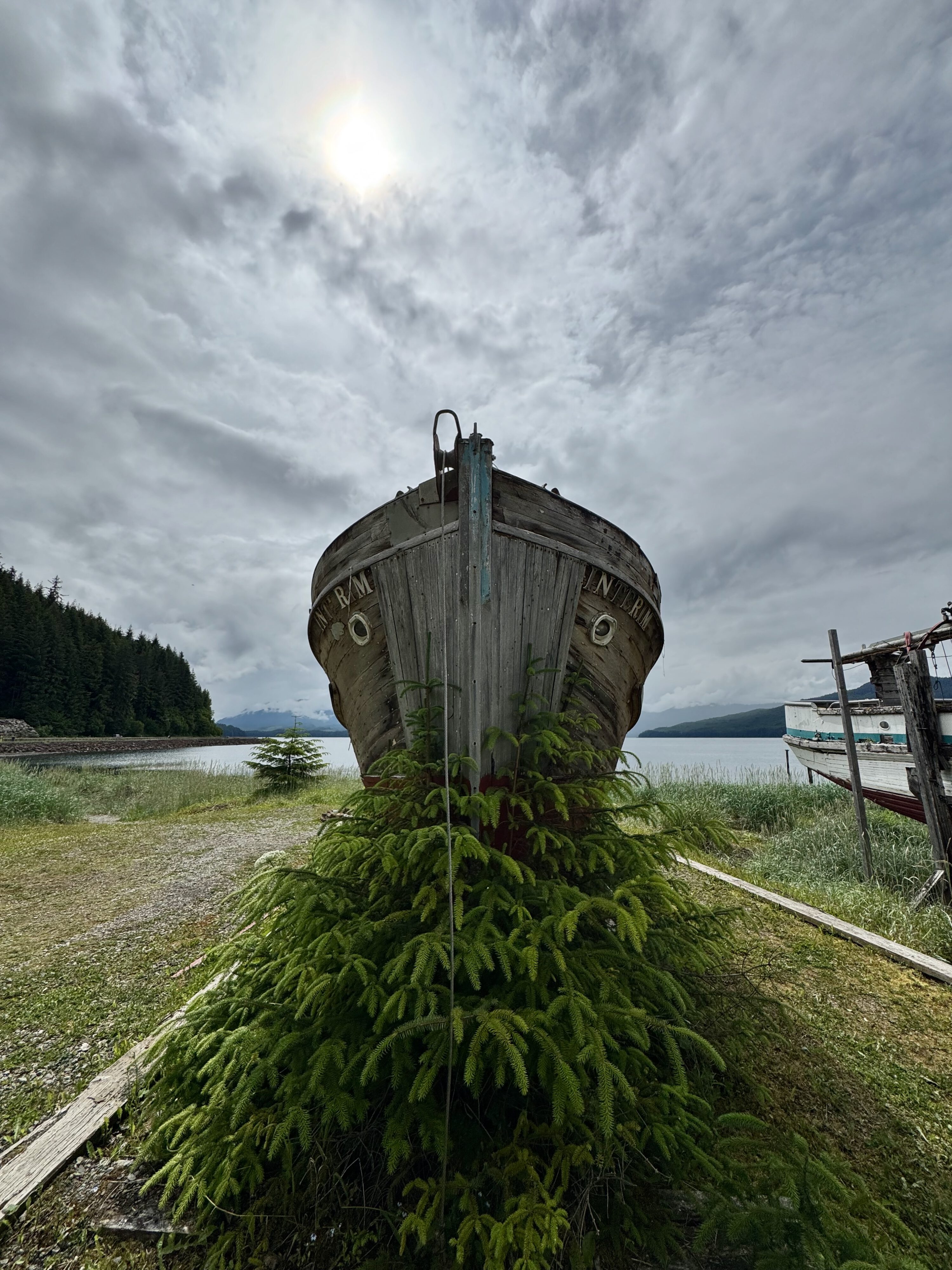
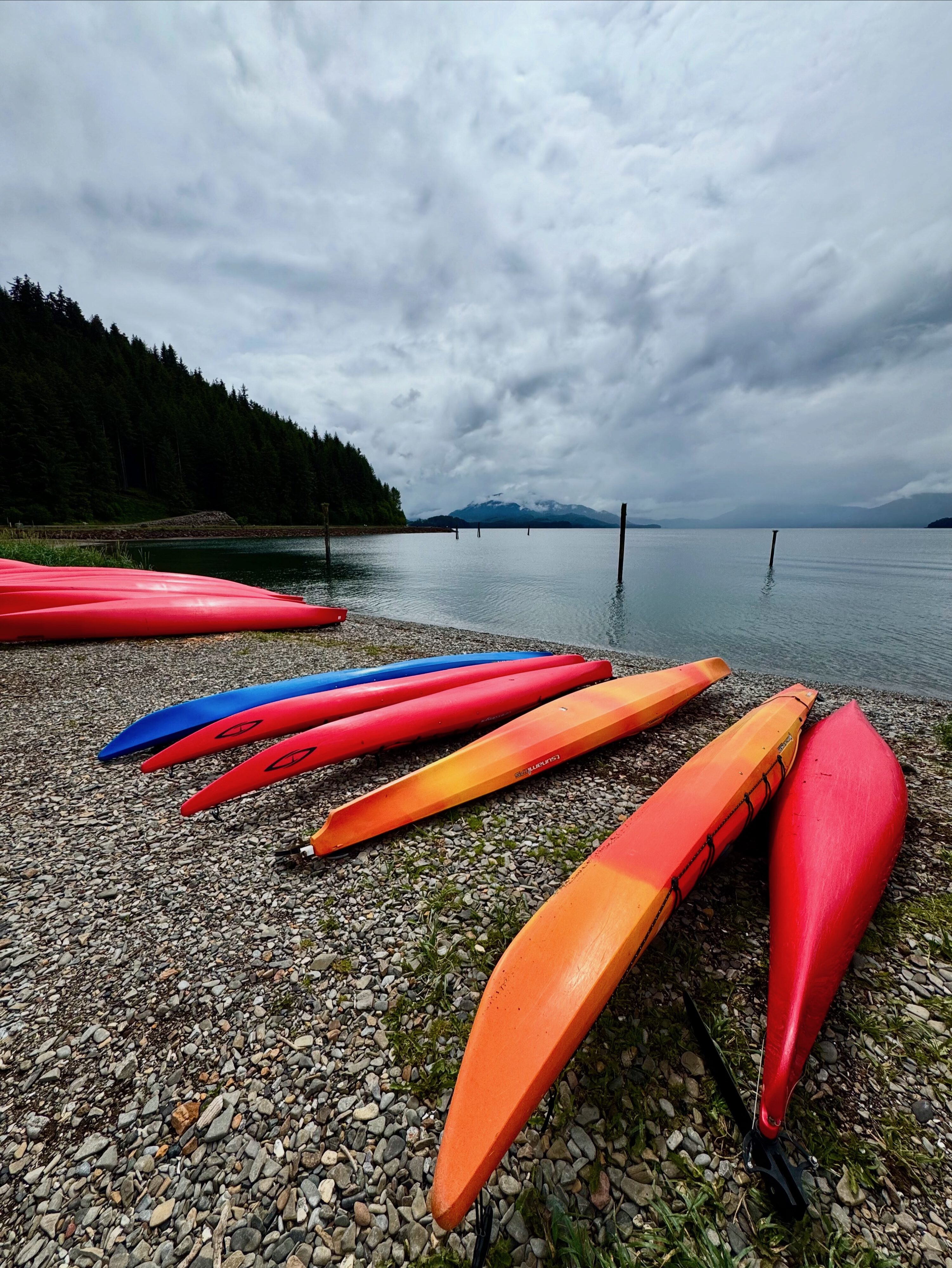
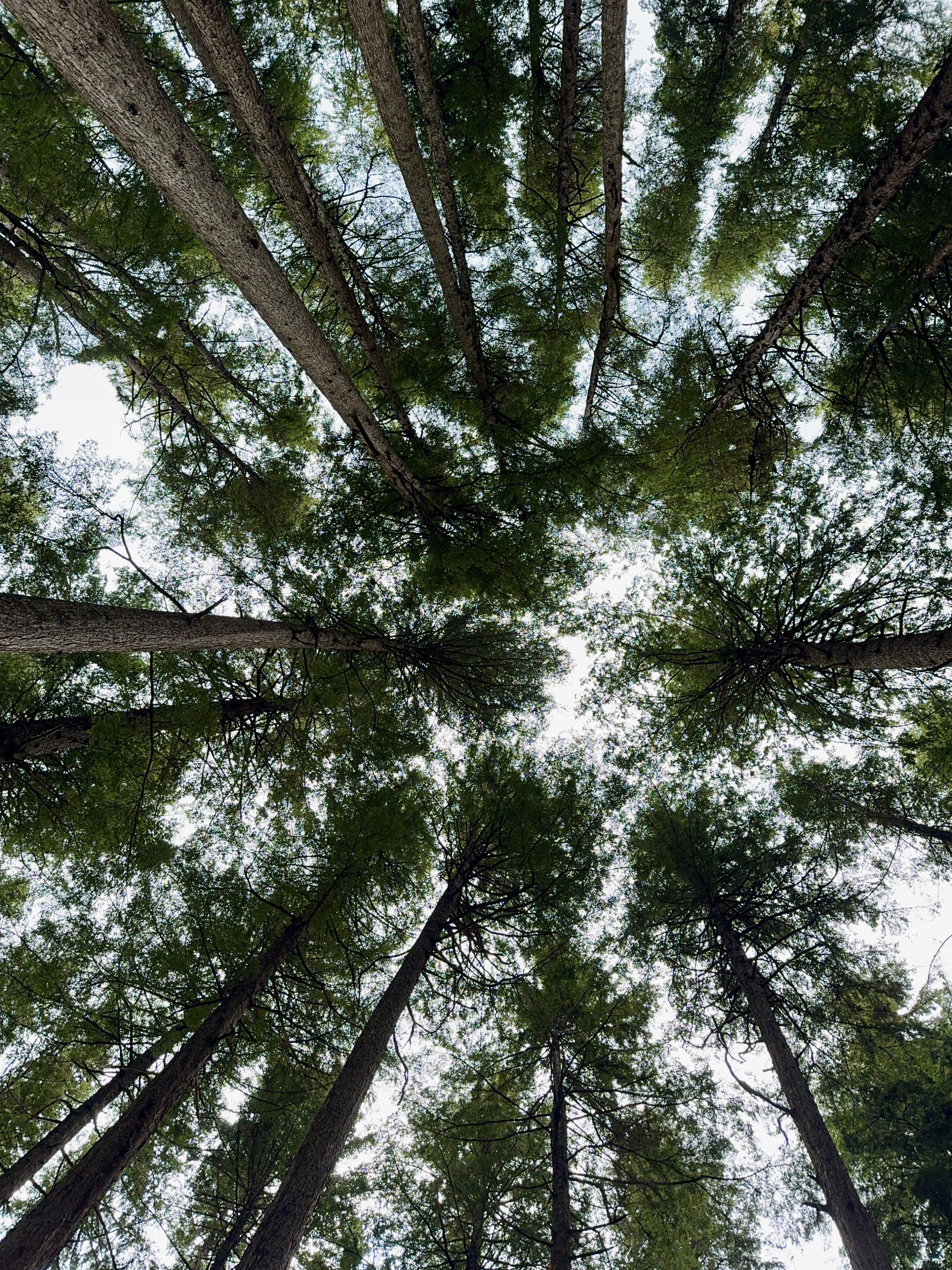
Second Port of Call: Juneau
Juneau, the capital of Alaska, is a truly unique place: it’s remote (no roads connect it to the outside world), culturally rich, and surrounded by some of the most awe-inspiring wilderness in North America.
What Is Juneau Known For?
Totem poles: They are not religious symbols — they are storytelling monuments carved from cedar that record clan lineage, myths, history, and important events.
Russian Orthodox Church St. Nicholas Church: built in 1894, this little white church with a blue onion dome is one of the oldest standing buildings in Juneau. It represents the Russian influence in Alaska before the U.S. purchase in 1867. Despite being small, it’s still active and reflects the fusion of Russian and Tlingit spirituality—many Native Alaskans adopted Orthodoxy.
Mount Roberts Tramway: one of the top attractions in Juneau: a scenic cable car that takes you from downtown to about 1,800 feet up the mountain in ~6 minutes.
Once at the Top: Hiking trails with stunning views of the Gastineau Channel, Juneau, and nearby islands, as well as lush temperate rainforest filled with wildflowers, moss-covered trees, and eagles.
The Juneau Icefield is a massive, 1,500-square-mile field of interconnected glaciers spanning from Juneau into British Columbia. It includes famous glaciers like Mendenhall, Taku, and Norris.
Taking a helicopter or small plane from Juneau and flying over jagged peaks, deep blue crevasses, and snow-covered valleys is a great experience.
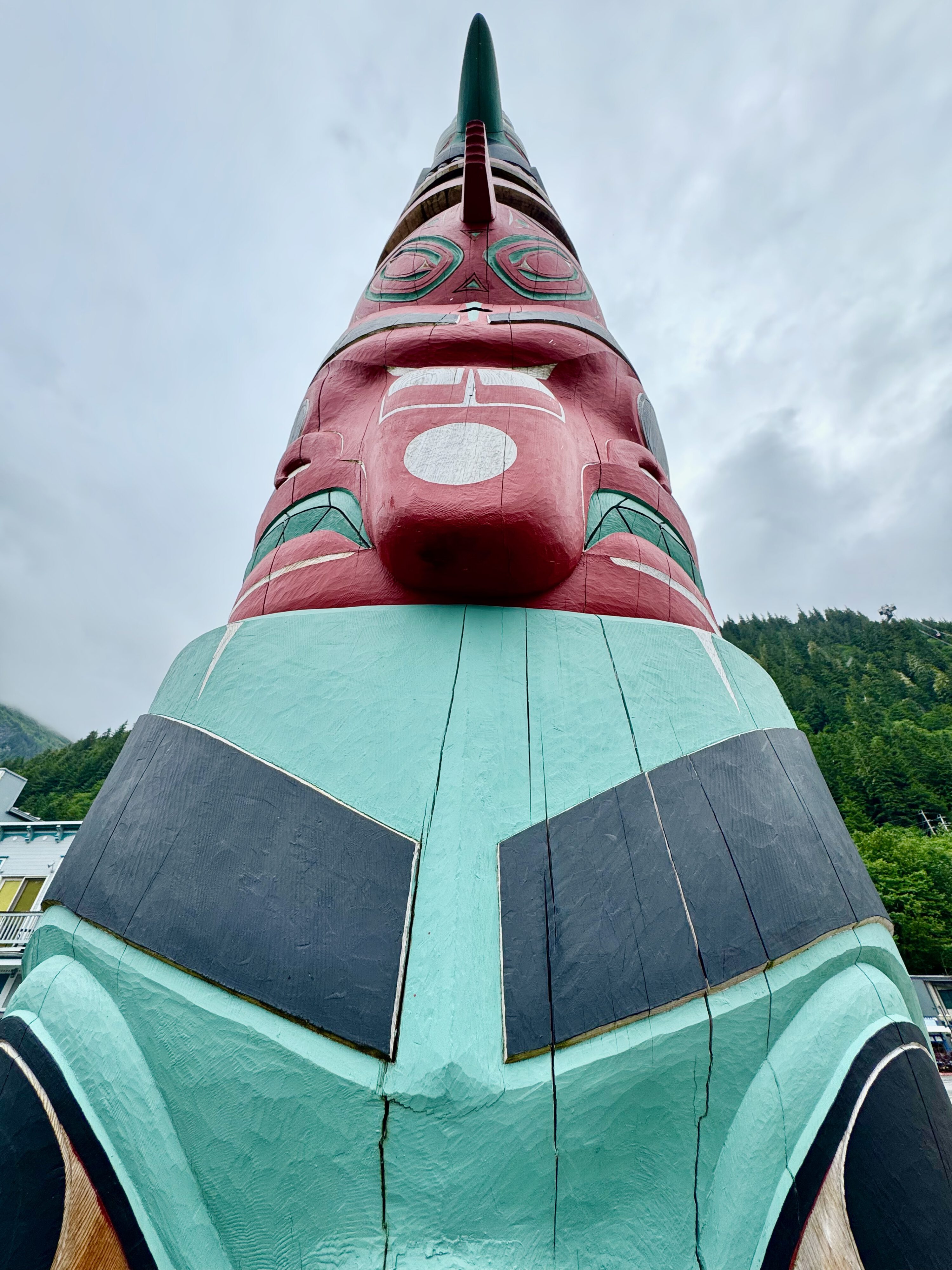
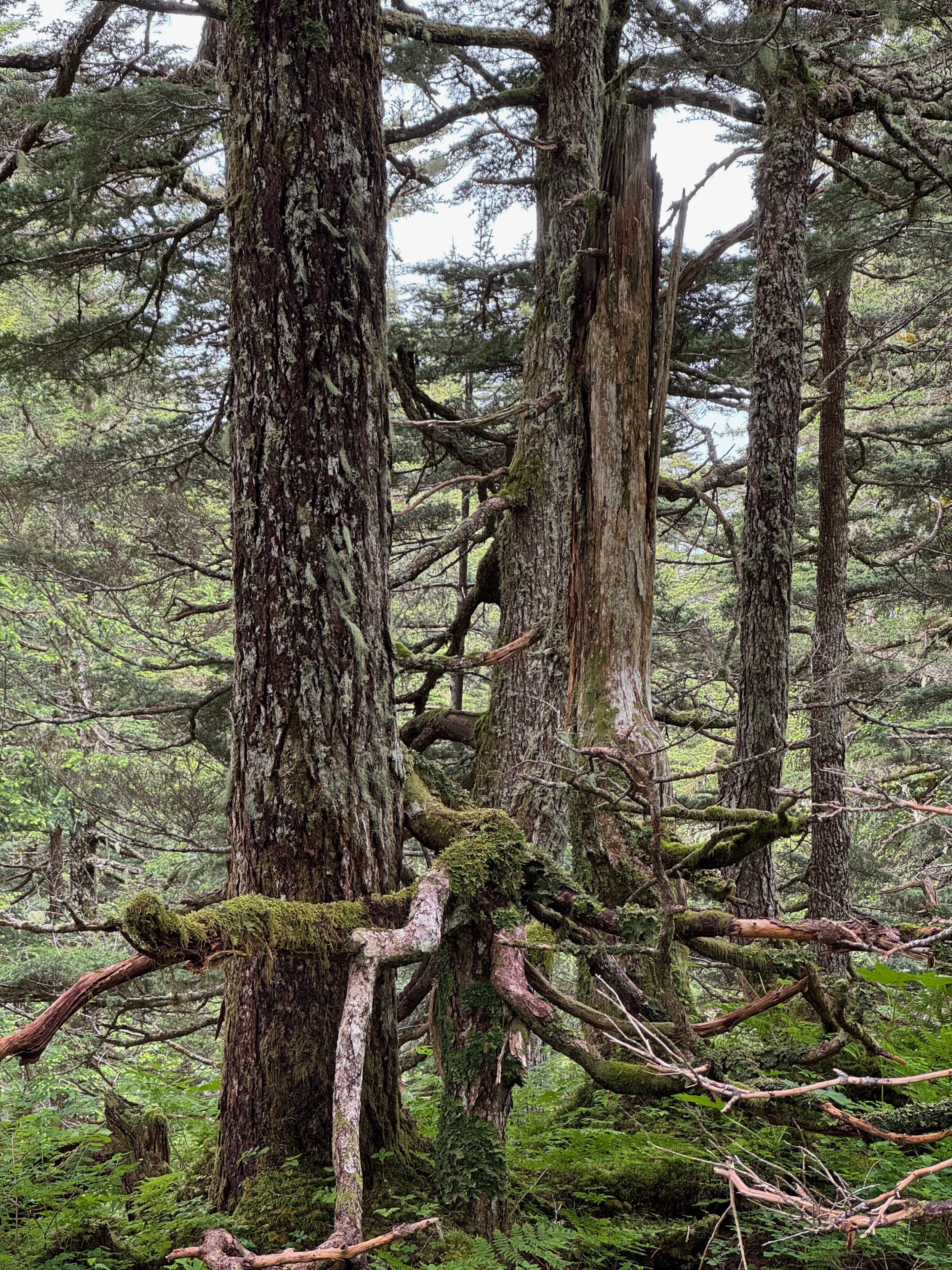
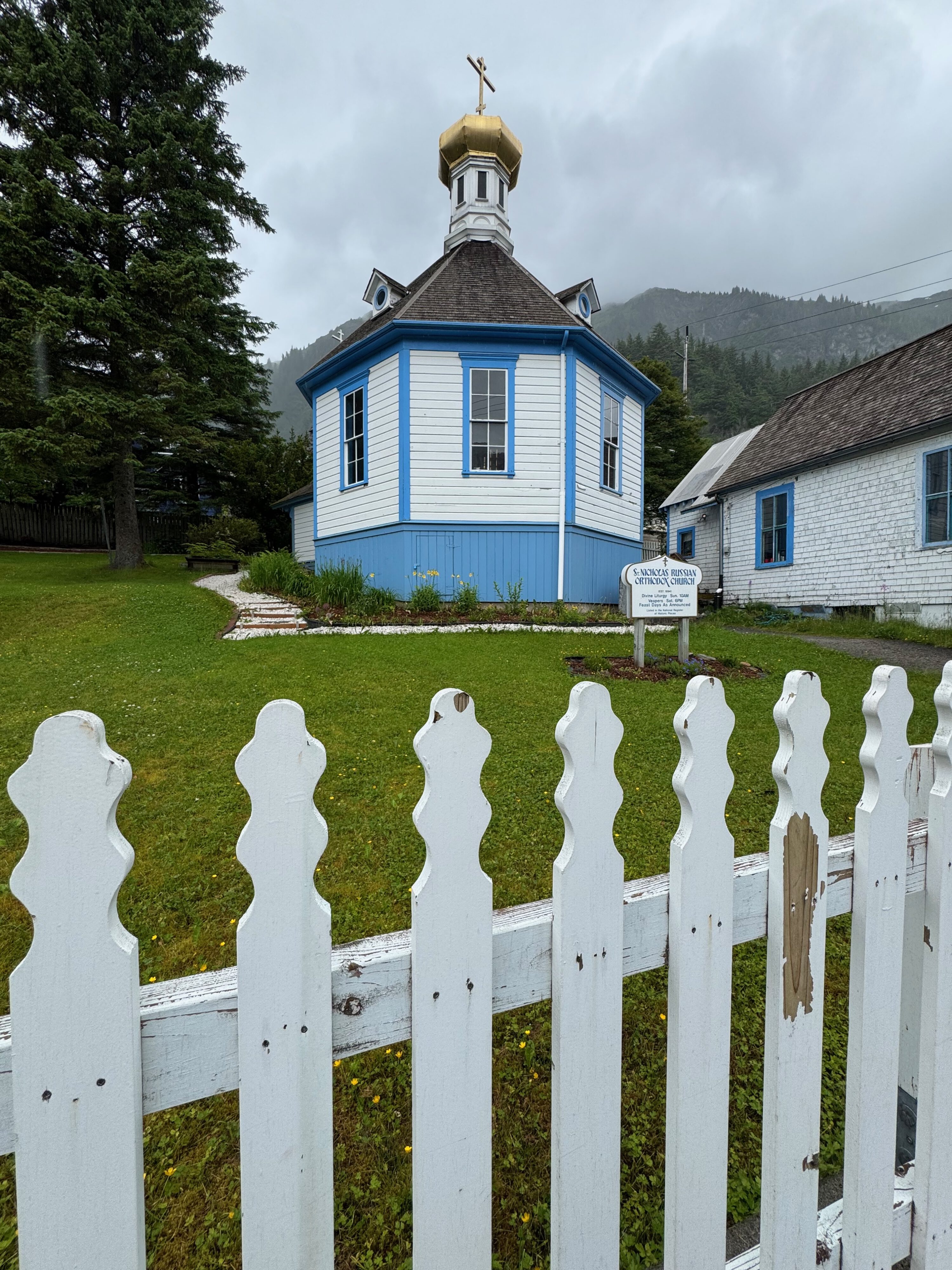

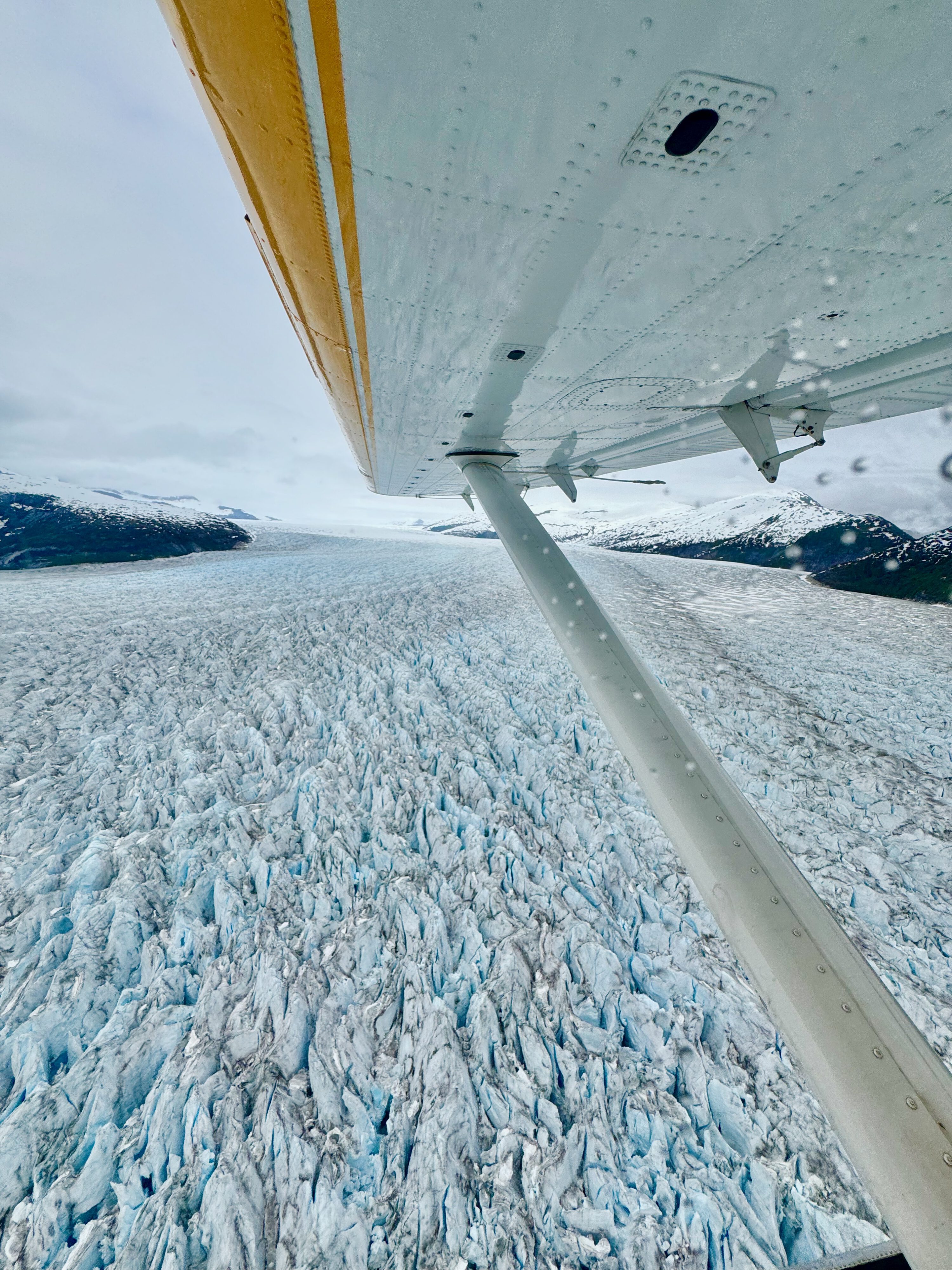
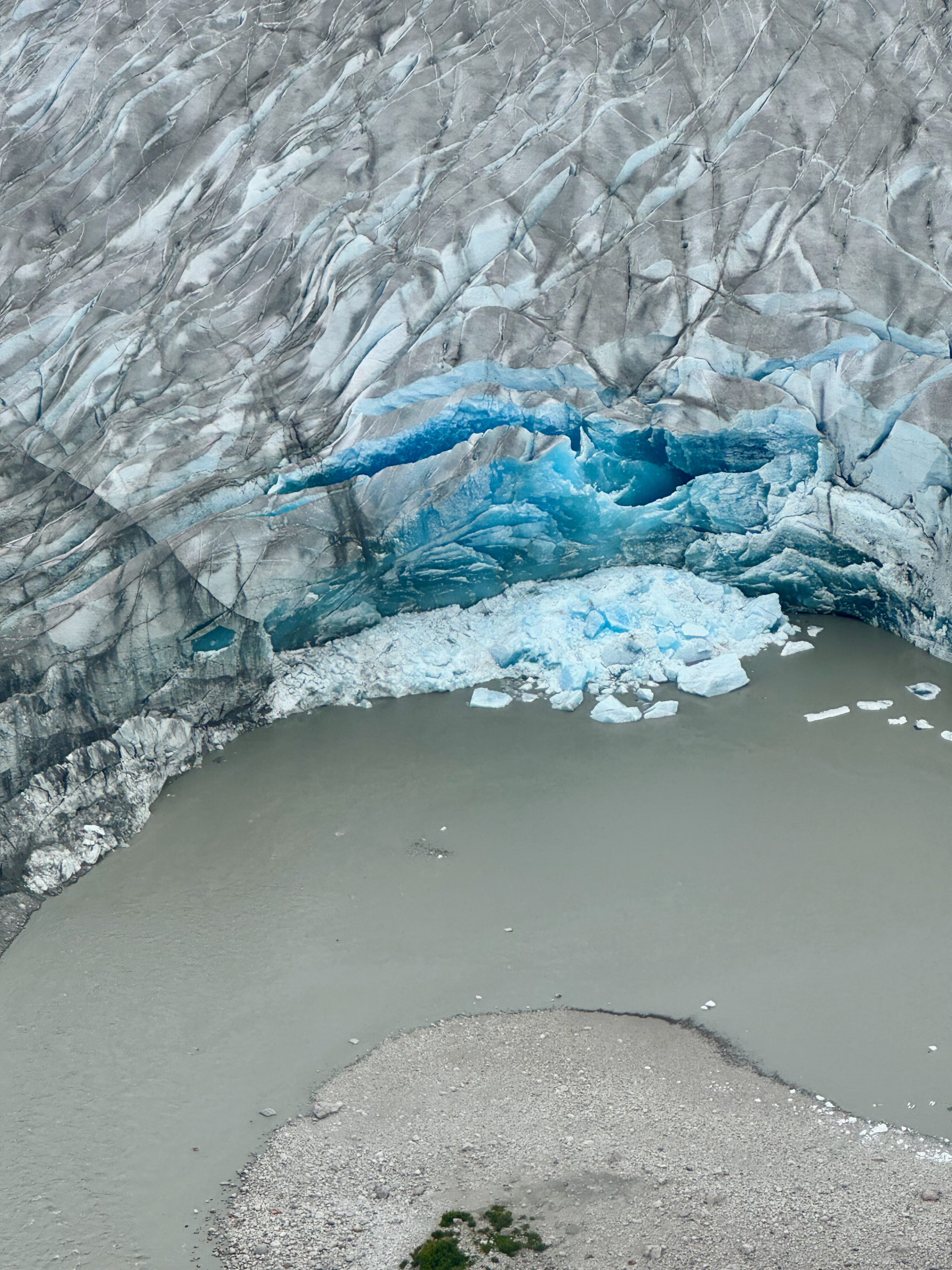
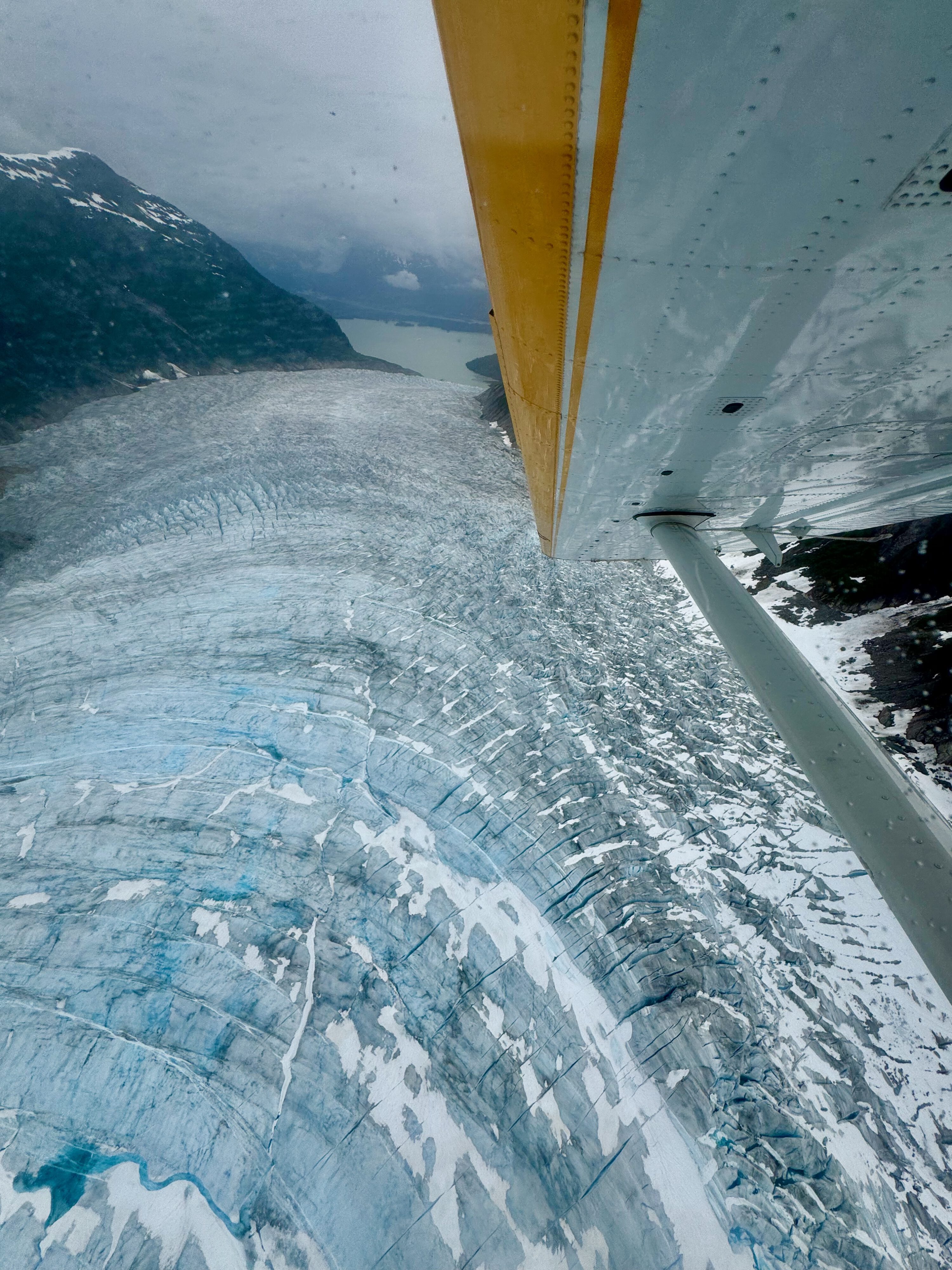
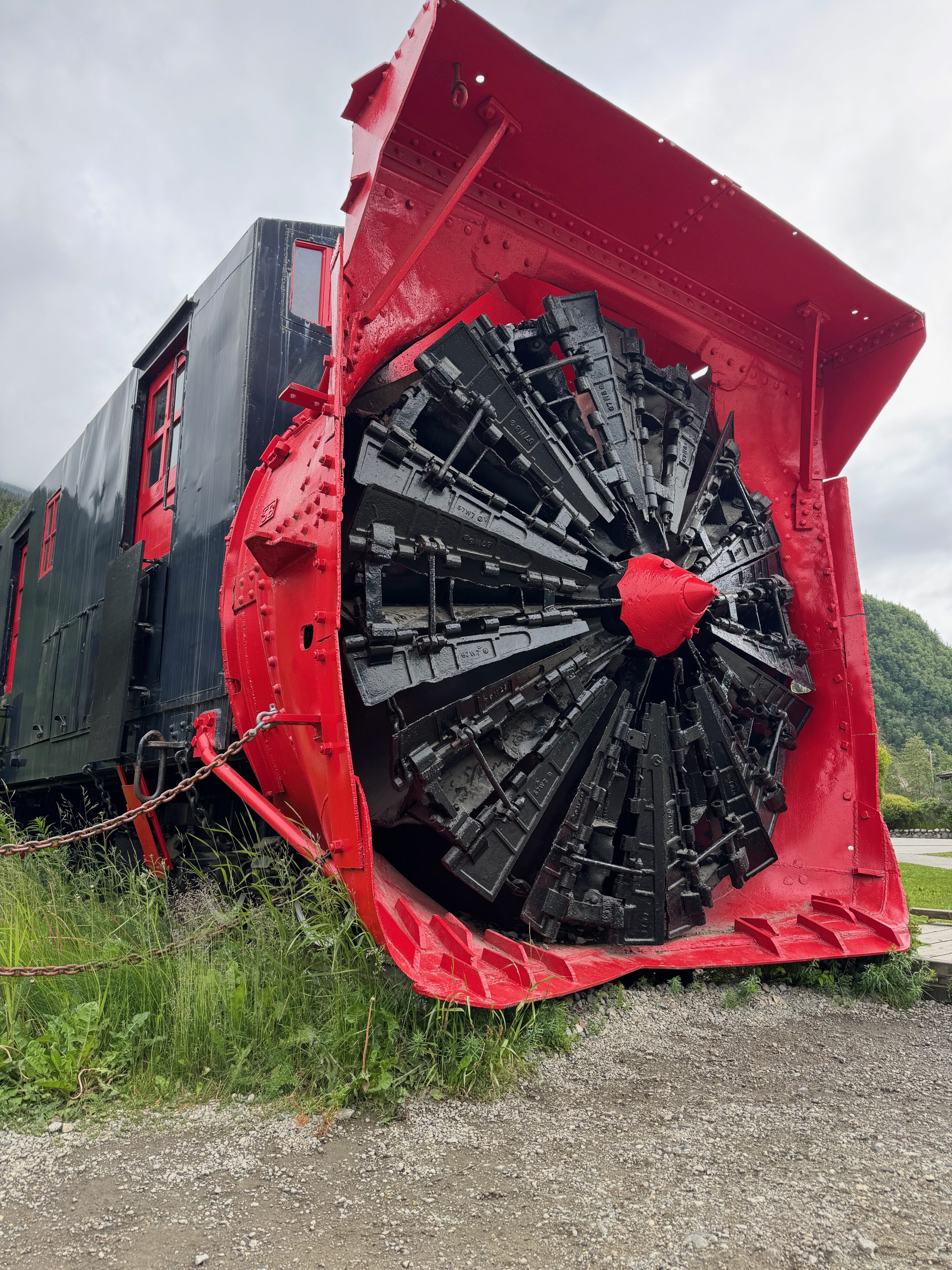
Third Port of Call: Skagway and Whitepass & Yukon Railway
The White Pass & Yukon Route Railway is one of the most iconic and scenic experiences in all of Alaska and the Yukon. Starting in Skagway, this narrow-gauge railroad climbs dramatically into the mountains, offering a blend of stunning natural beauty, engineering marvels, and gold rush history.
Whether you’re a history buff, a nature lover, or just someone looking for an unforgettable ride, it’s one of the top reasons to visit Skagway.
Klondike Gold Rush (1896–1899)
Thousands of gold seekers (nicknamed “stampeders”) poured into Skagway on their way to the gold fields of the Yukon.
The route from Skagway to Dawson City was rugged and dangerous, involving steep climbs over White Pass or Chilkoot Pass.
Built during the Klondike Gold Rush (1898), the White Pass & Yukon Railway covers about 110 miles from Skagway to Whitehorse, though most tourists ride the 20-mile segment to White Pass Summit (or slightly beyond). When completed in 1900, the gold rush was just fading.
Crossing trestle bridges and passing by glacial rivers, the tour boasts with scenic beauty and offers the chance for jaw-dropping photography, as the classic vintage railcars offer open-air platforms for viewing.
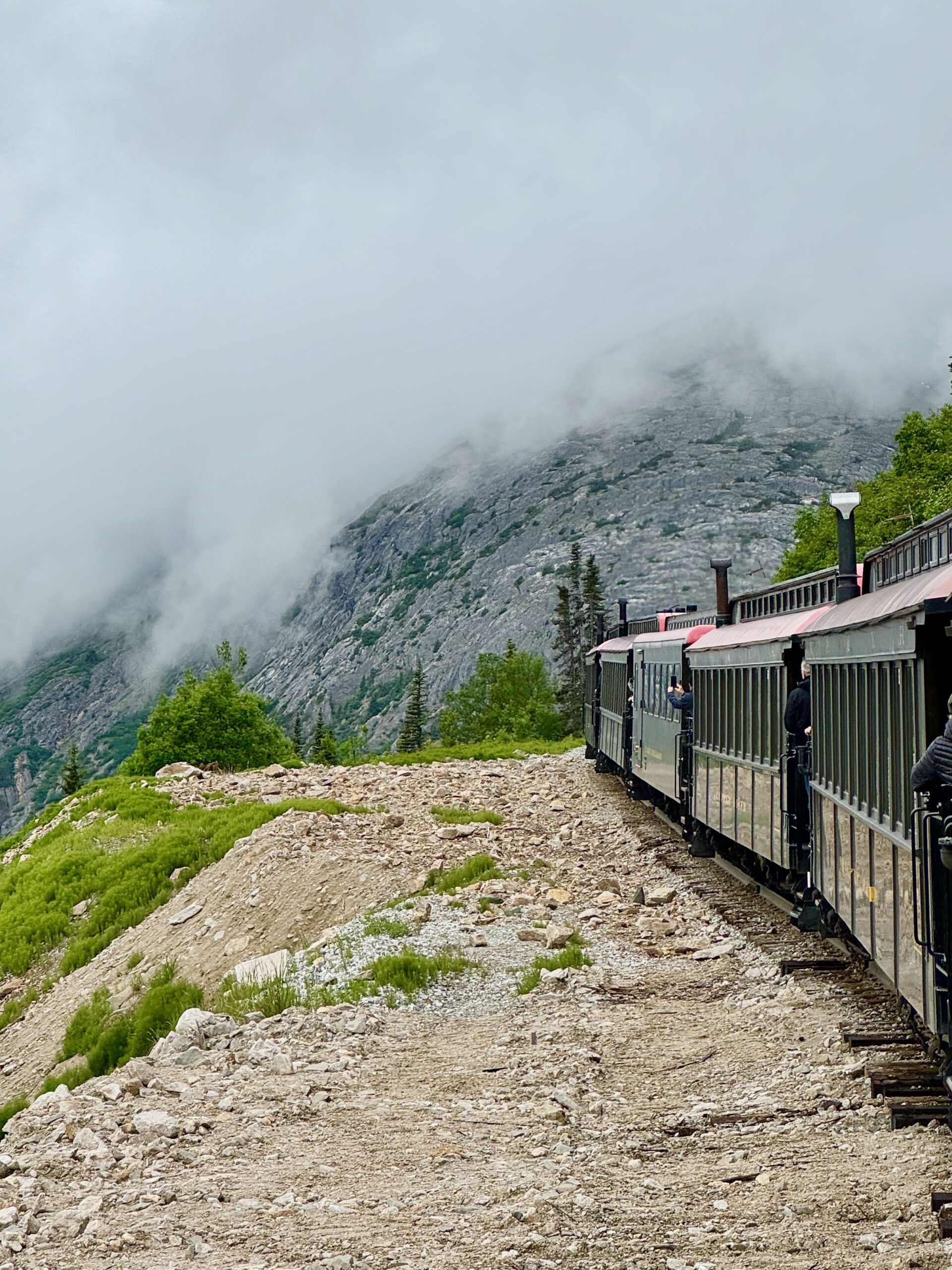
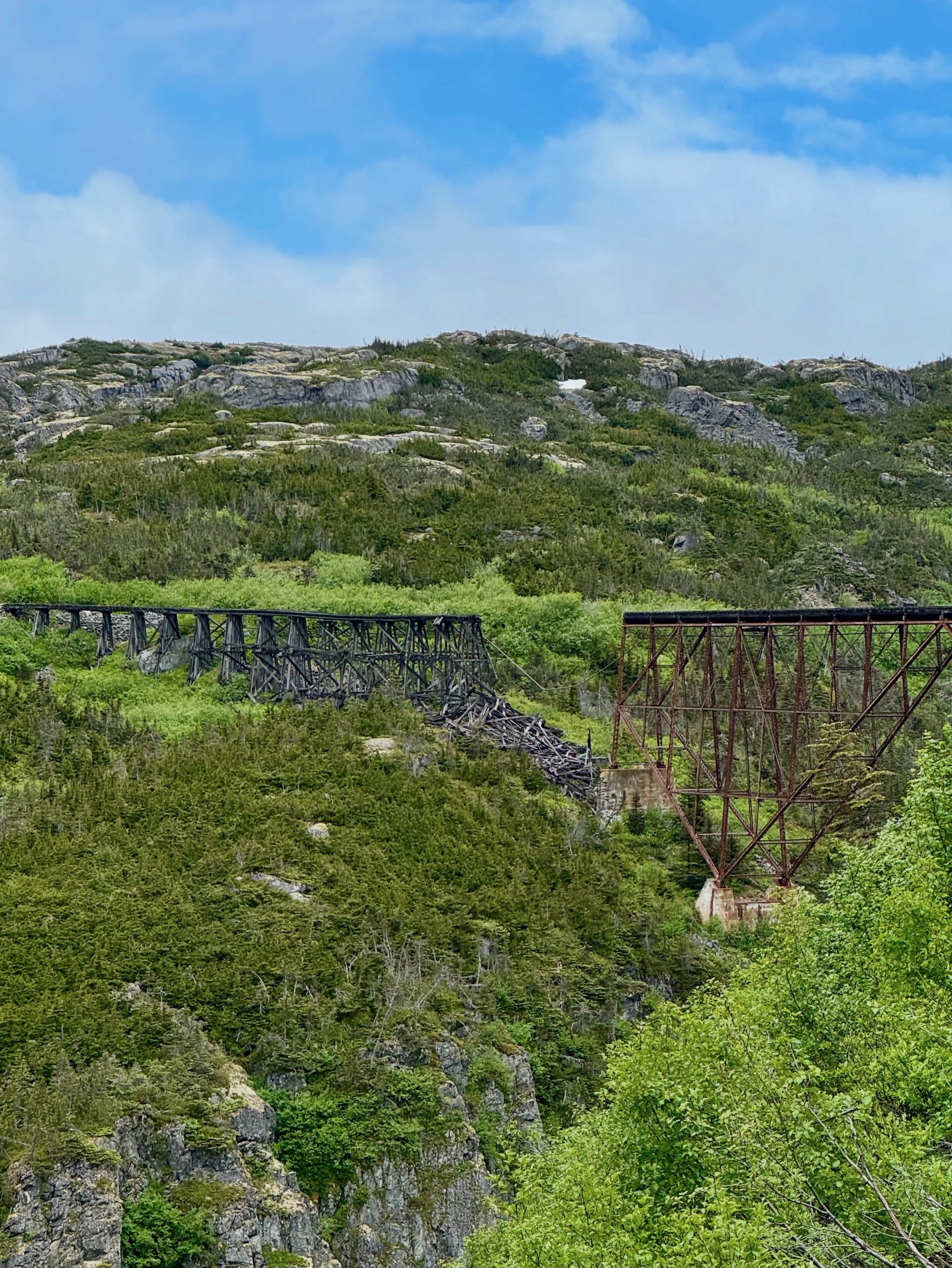
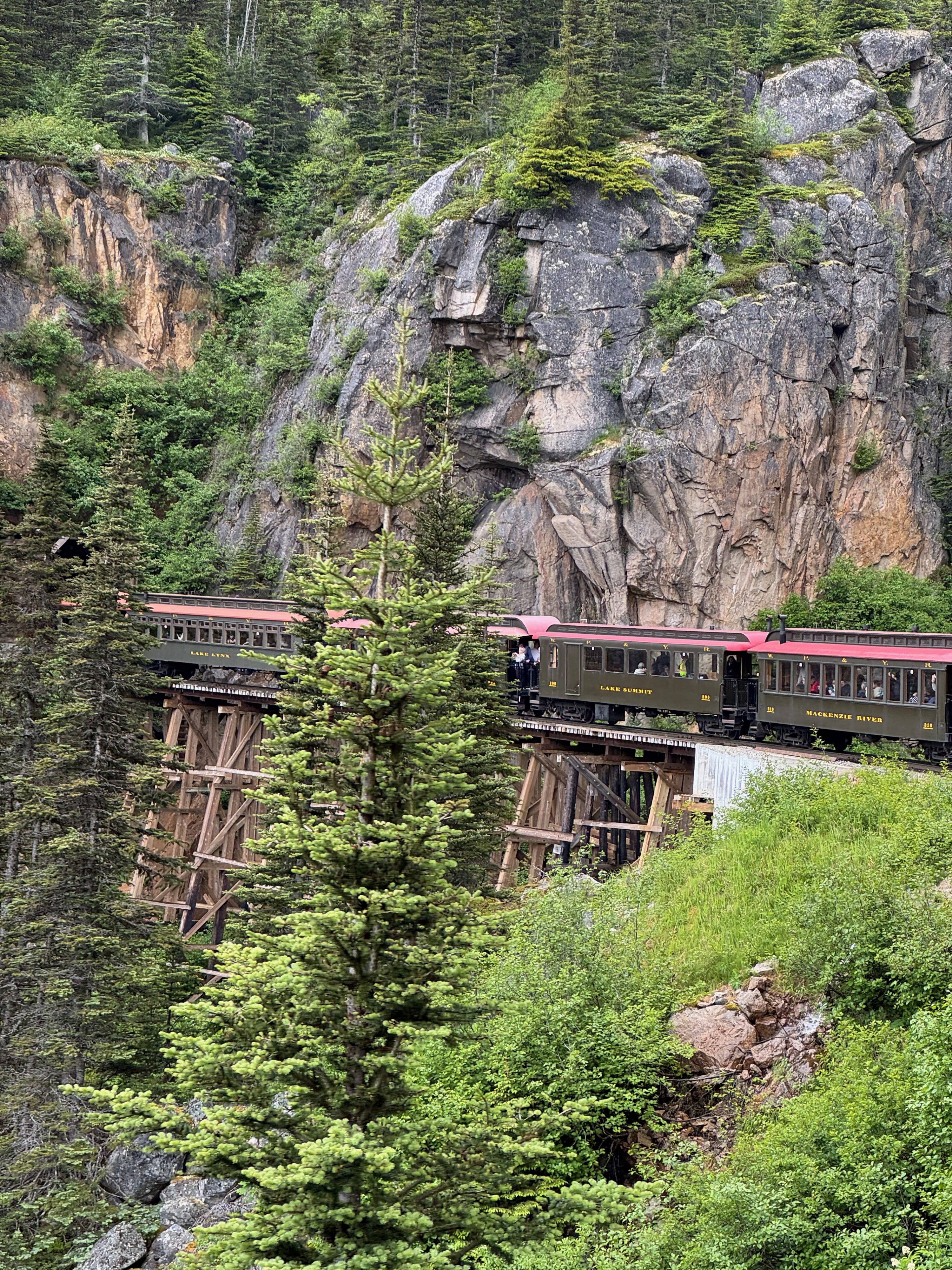
Ghosts & Goodtime Girls Historical Walking Tour
The Ghosts & Goodtime Girls Historical Walking Tour in Skagway is a unique, lively blend of history, theater, and a touch of the supernatural—making it a winning choice for visitors seeking something memorable and fun.
Costumed “Madam” guides lead you through Skagway’s back alleys and former red-light districts, vividly recalling women like Klondike Kate, Diamond Lil, and other infamous “working girls” of the Gold Rush era.
A storytelling mix of humor, double entendres, and real hardship, balancing entertaining with emotionally meaningful moments .
Tour guide Shirley Wood is energetic, funny, and knowledgeable, bringing the history of the saloon and the Klondike Gold Rush era to life. Visitors recommend taking the tour she leads and specifically requesting her…
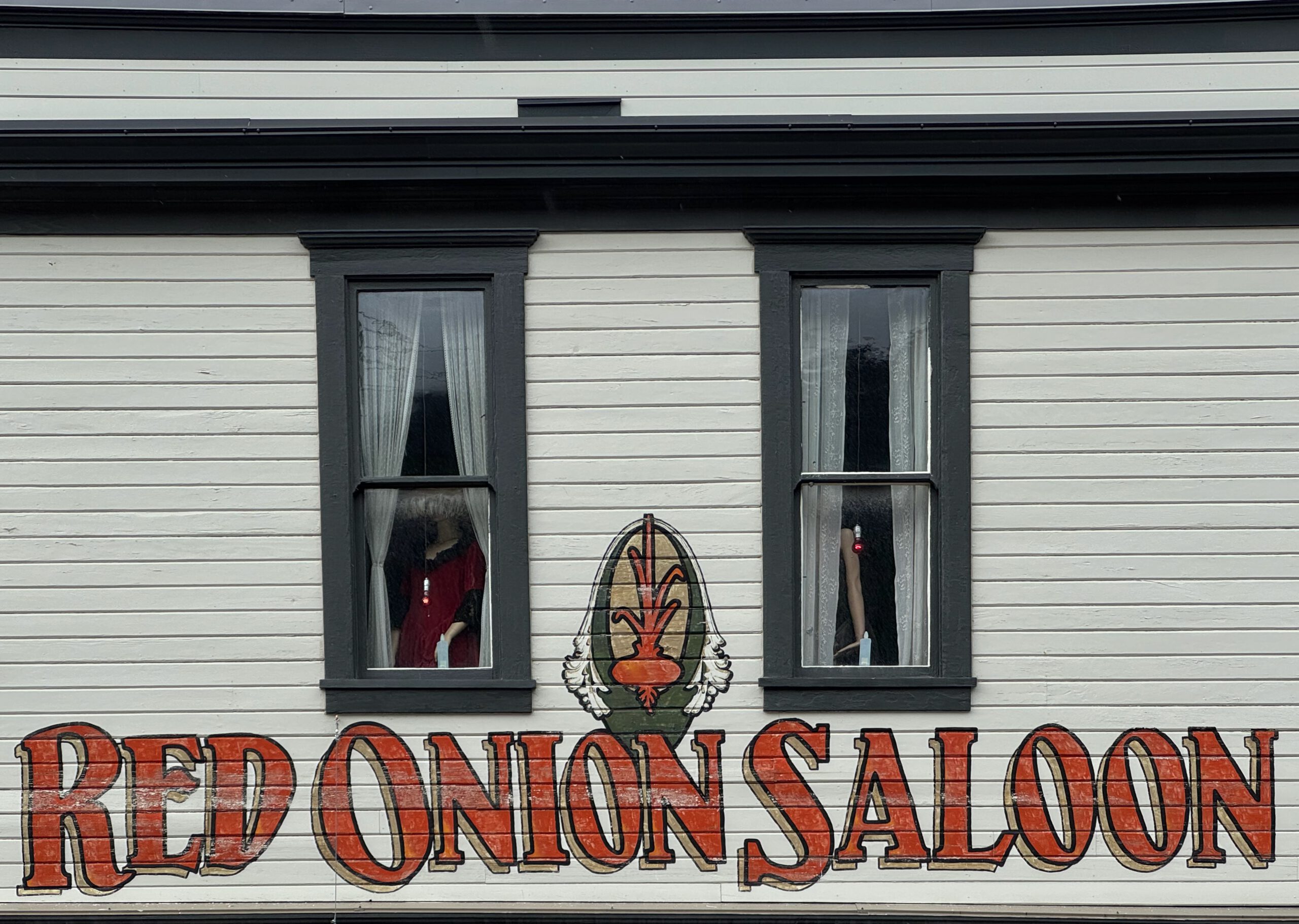
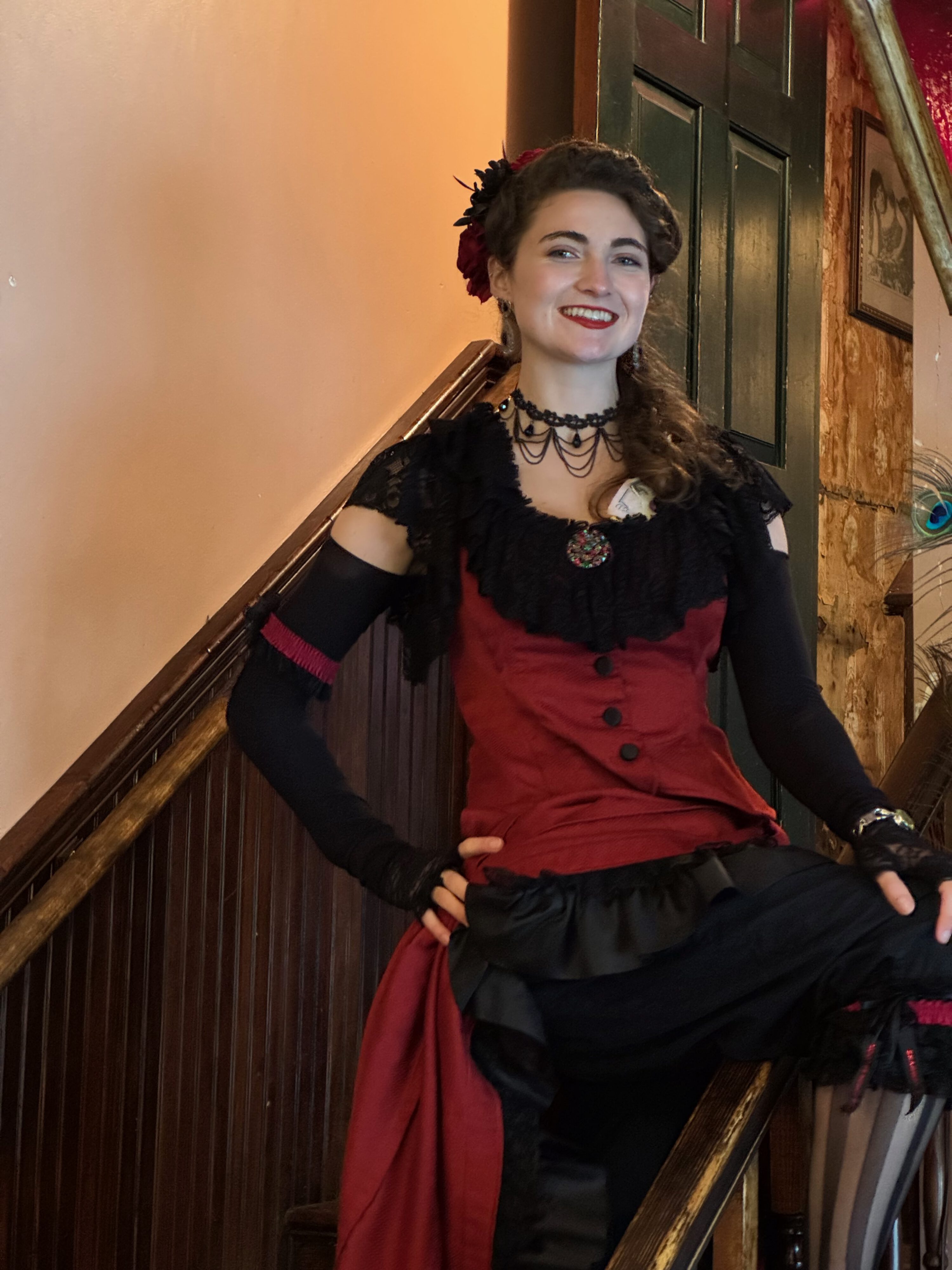
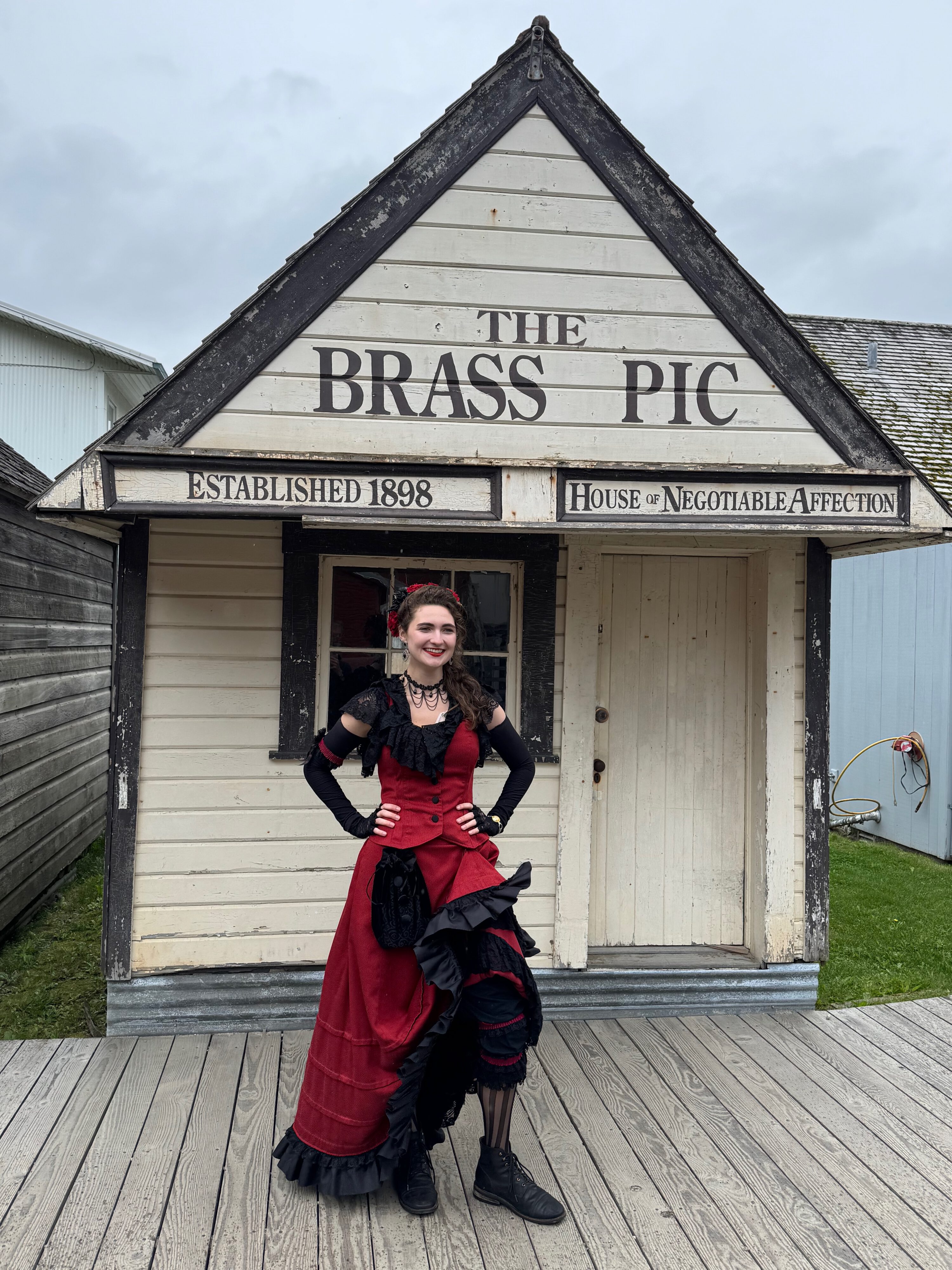
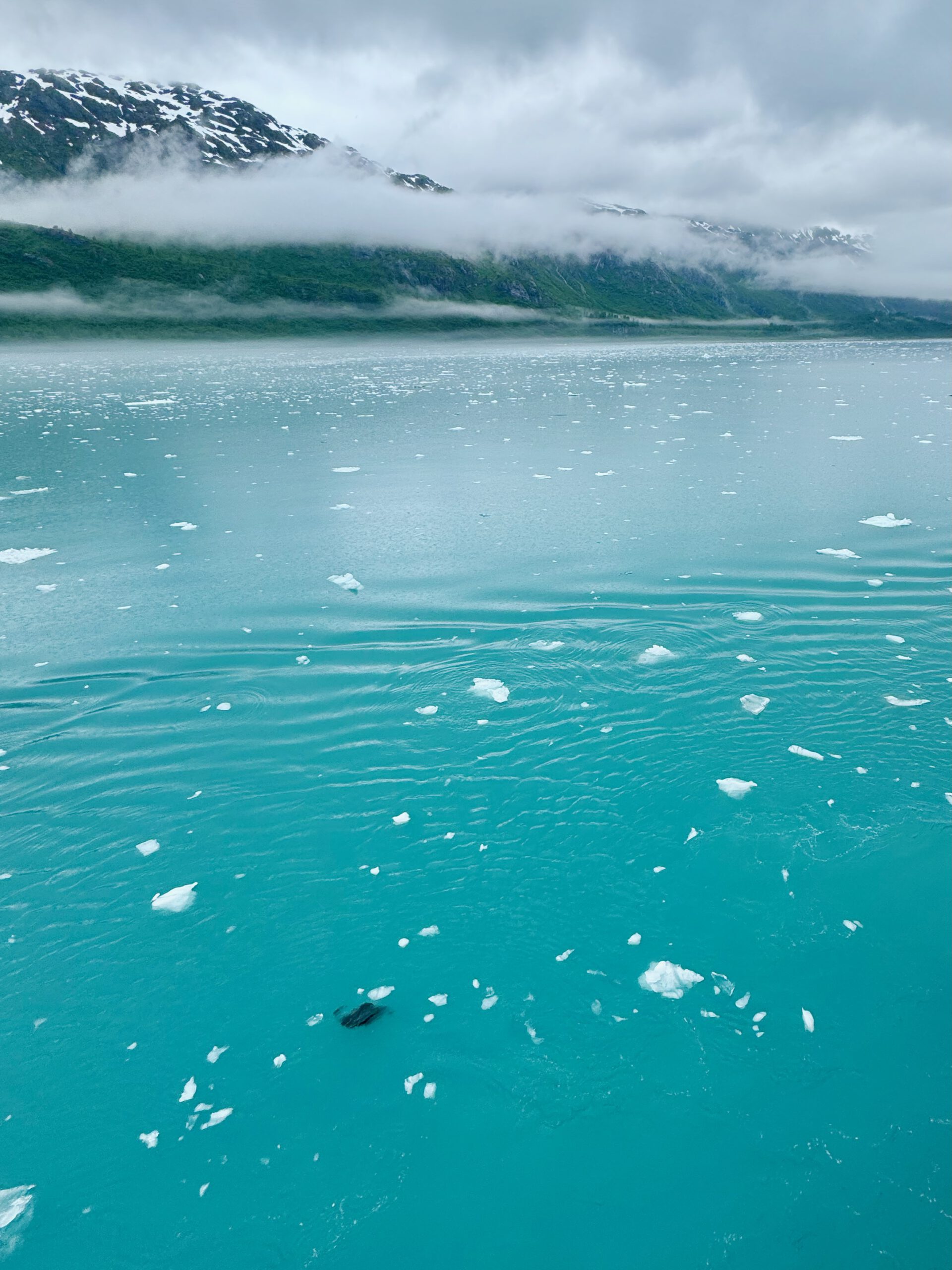
Scenic Cruising: Glacier Bay
Glacier Bay is one of the crown jewels of any Alaska cruise—if not the highlight. Located in southeast Alaska, Glacier Bay National Park and Preserve is a UNESCO World Heritage Site and one of the most pristine, remote, and awe-inspiring natural areas in North America. If you’re cruising Alaska and your itinerary includes Glacier Bay: don’t miss it. Here’s why:
Live, Active Glaciers
Unlike most places, here you can sail right up to massive glaciers like:
Margerie Glacier – often active and known for calving (when chunks of ice break off and crash into the water). Grand Pacific Glacier – wide, dramatic, and surrounded by ice-sculpted mountains. When a glacier calves, it creates a thunderous sound known as “white thunder.” Witnessing this live is powerful and unforgettable.
Spectacular Scenery
Towering snowcapped mountains, steep fjords, floating icebergs, and waterfalls plunging from cliffs. The light and color variations—blue ice, emerald forests, white peaks—are mesmerizing, especially in early morning or evening sun.
Wildlife Galore
You’re almost guaranteed to see humpback whales, sea otters, and Steller sea lions, bald eagles and puffins overhead,brown and black bears, moose, and mountain goats along the shore, harbor seals resting on ice floes.
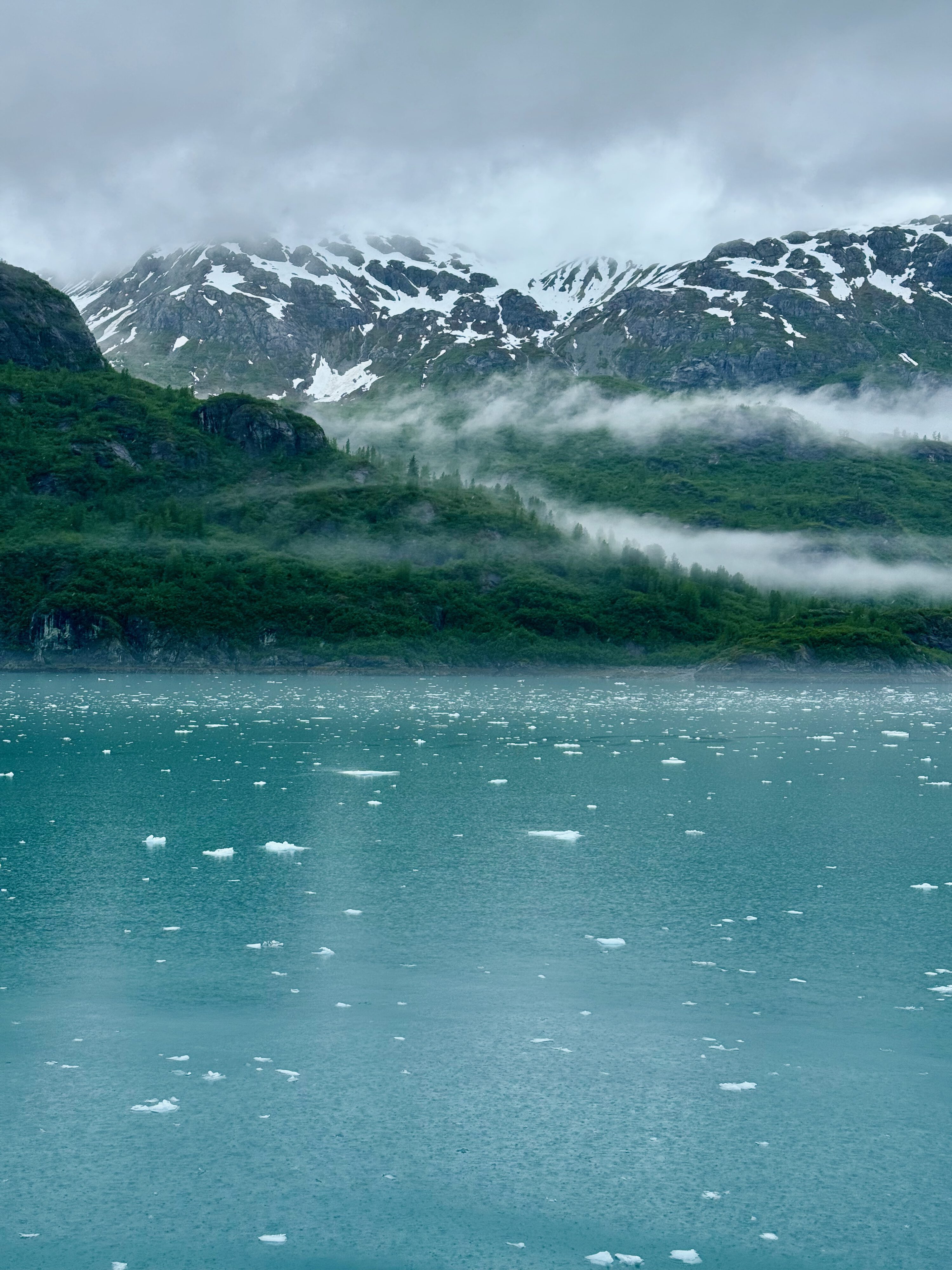
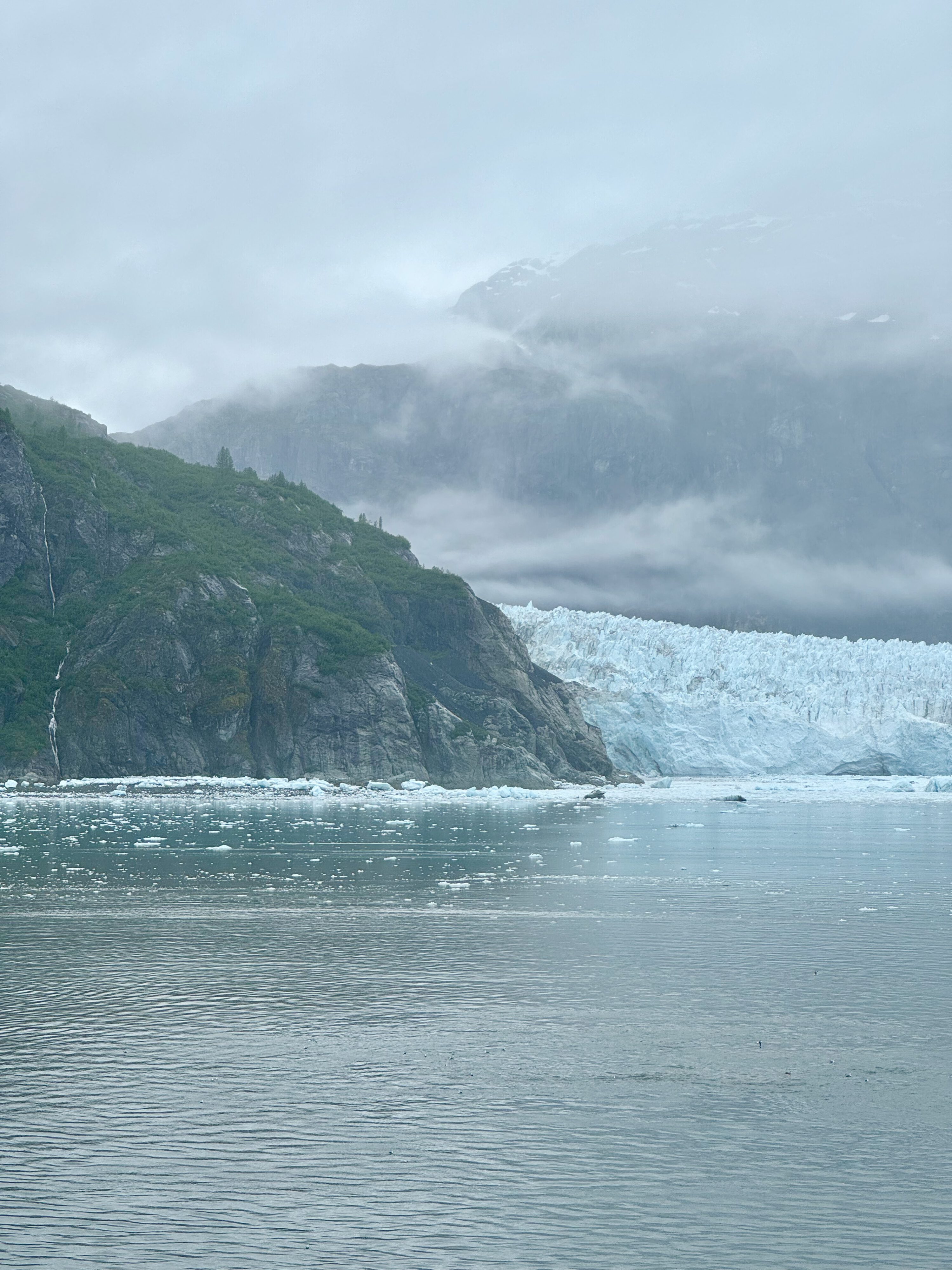
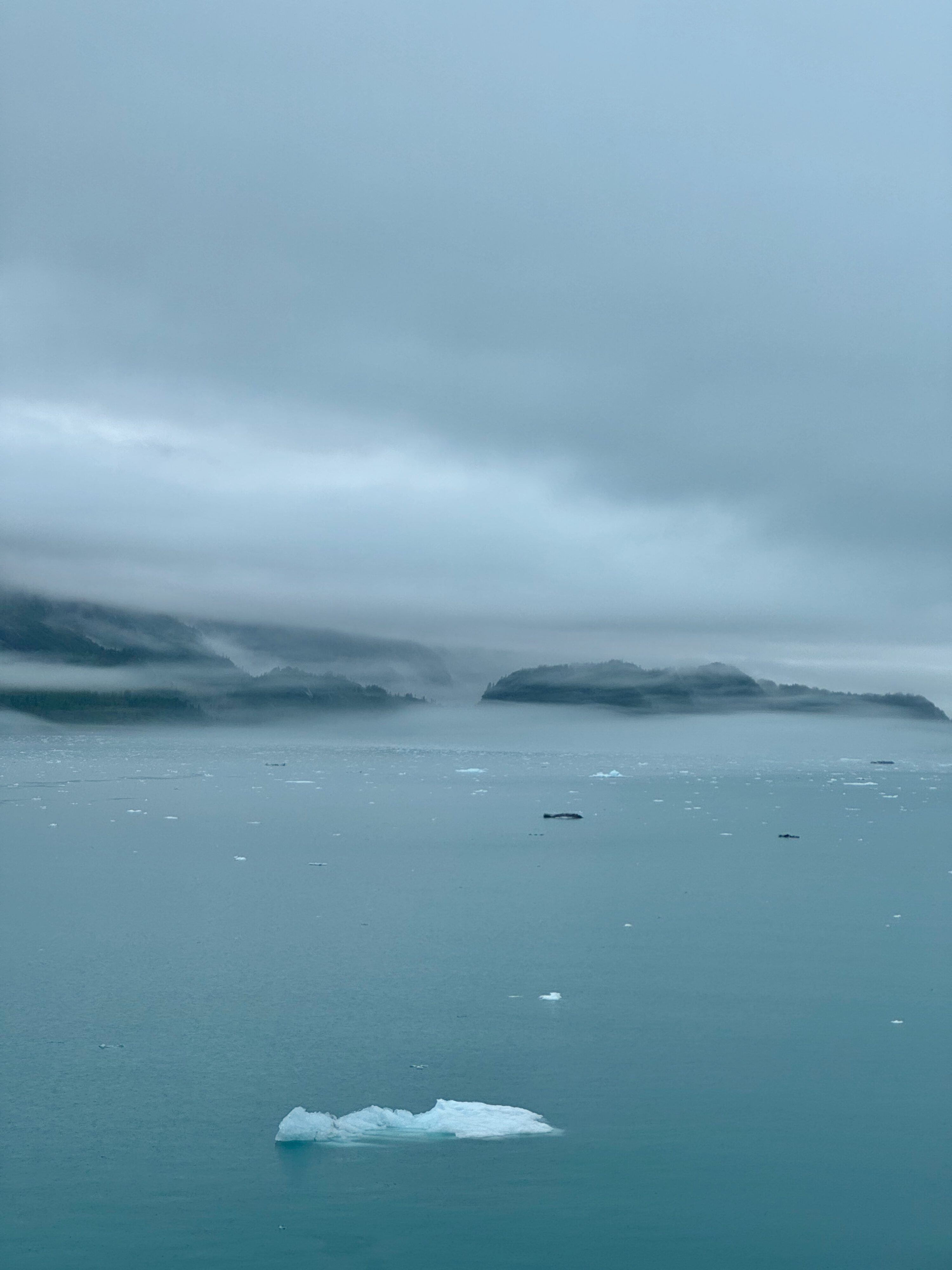
4th Port of Call: Ketchikan
Ketchikan, often called “Alaska’s First City” (because it’s the first port of call for many cruises heading north), is one of the most colorful, culturally rich, and naturally beautiful towns in Southeast Alaska. It blends Native heritage, Gold Rush history, quirky charm, and jaw-dropping scenery—making it an essential stop on any Alaska itinerary.
Located on the southern tip of Alaska’s Inside Passage, Ketchikan sits on Revillagigedo Island, nestled between steep mountains and the Tongass Narrows. It’s accessible only by boat or plane, which gives it a unique, frontier-like feel.
Creek Street is one of Ketchikan’s most iconic attractions—a scenic wooden boardwalk perched on stilts above Ketchikan Creek, steeped in Gold Rush-era history, colorful architecture, and lively storytelling. It’s part historic site, part shopping district, and part outdoor museum—all rolled into one atmospheric riverside setting.
A historic district built in the early 1900s, Creek Street was Ketchikan’s red-light district during the Gold Rush. Rather than a “street” in the usual sense, it’s a winding wooden boardwalk along the creek’s edge—originally built to keep the houses above the tidal waters. At its peak, it was home to more than 30 “cribs” (small rooms used for prostitution).
The most famous resident was Dolly Arthur, a savvy businesswoman and one of Ketchikan’s best-known madams.
Her former home, Dolly’s House Museum, is now a restored and furnished brothel open for tours.
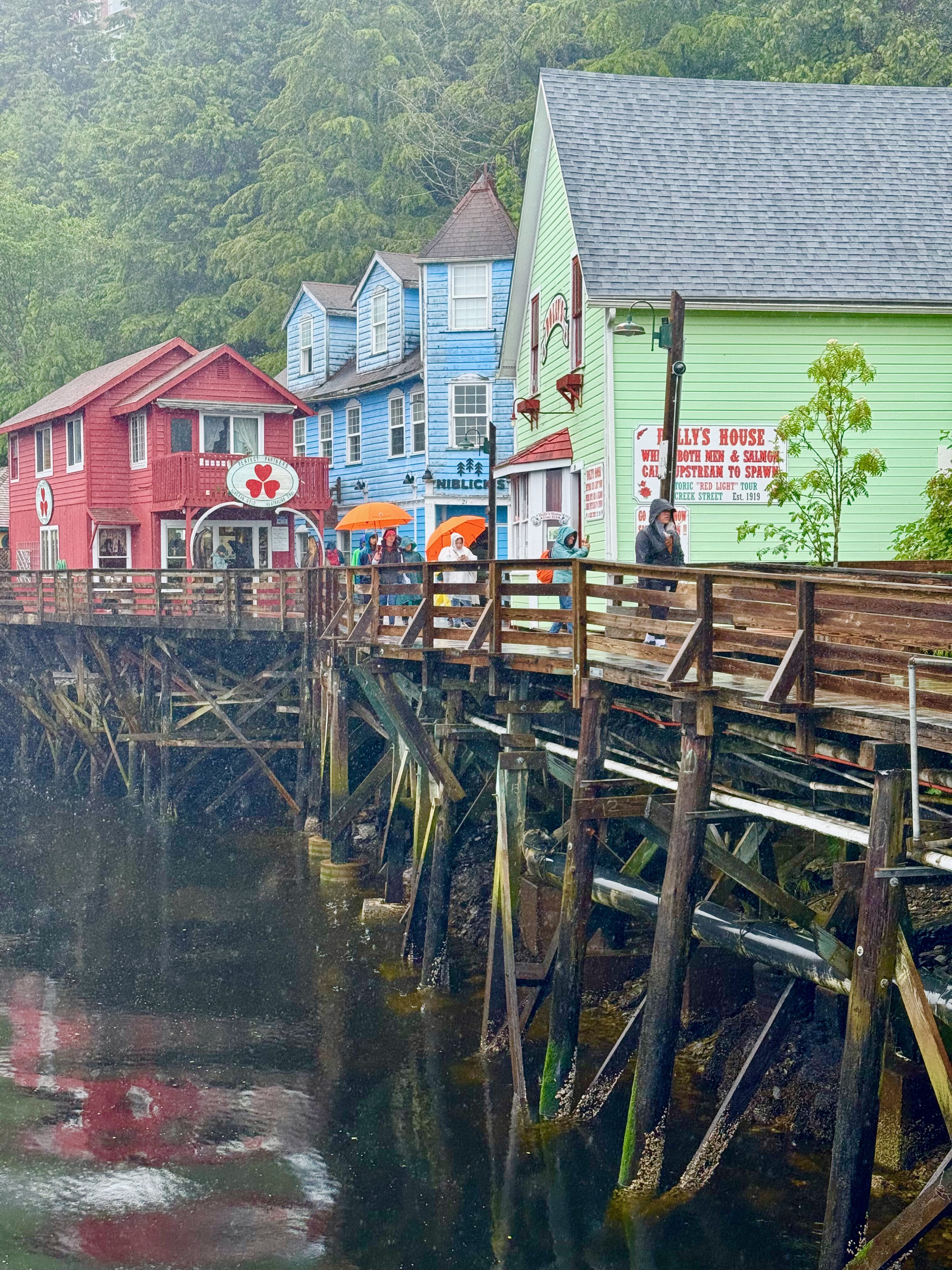
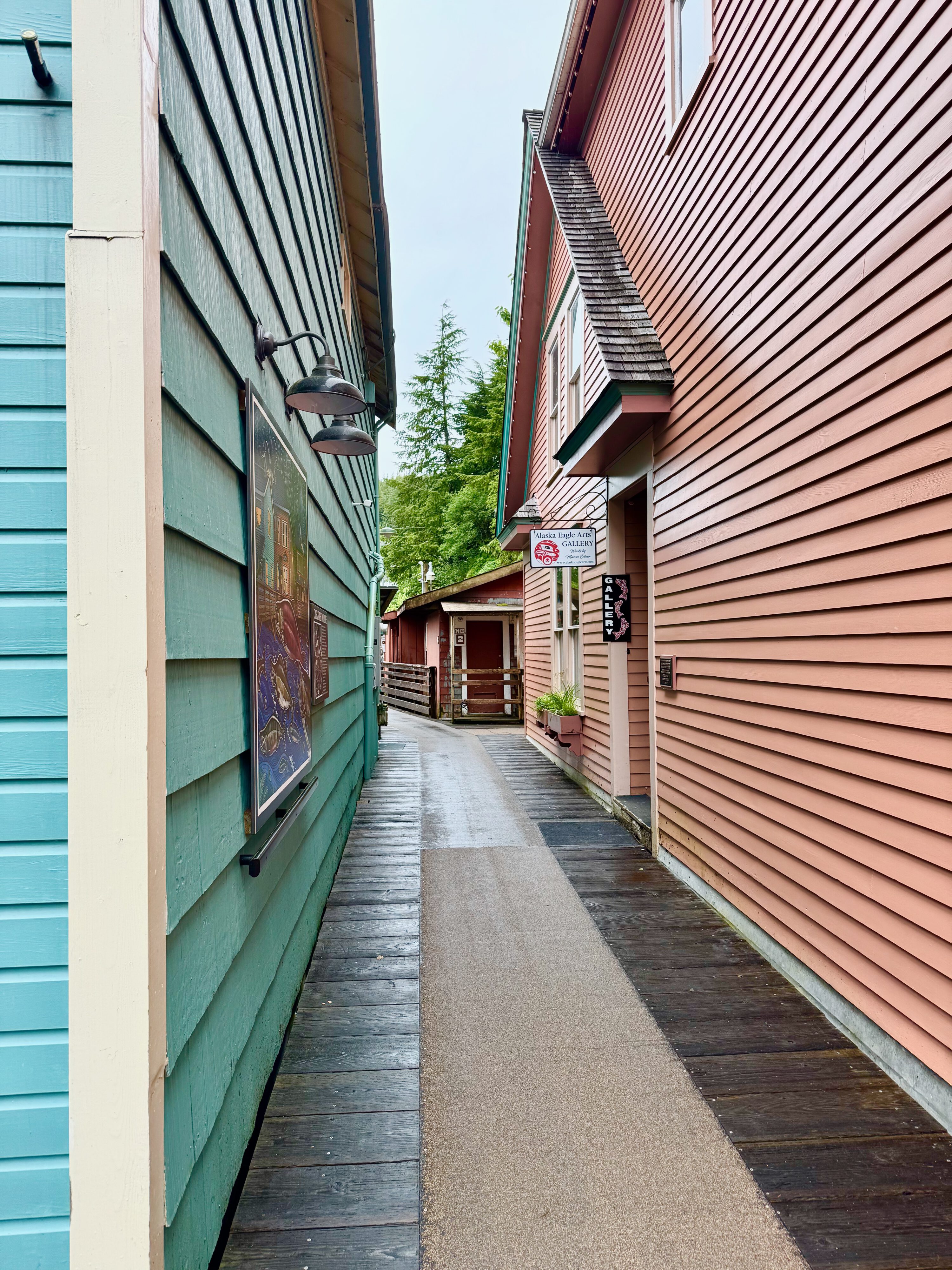
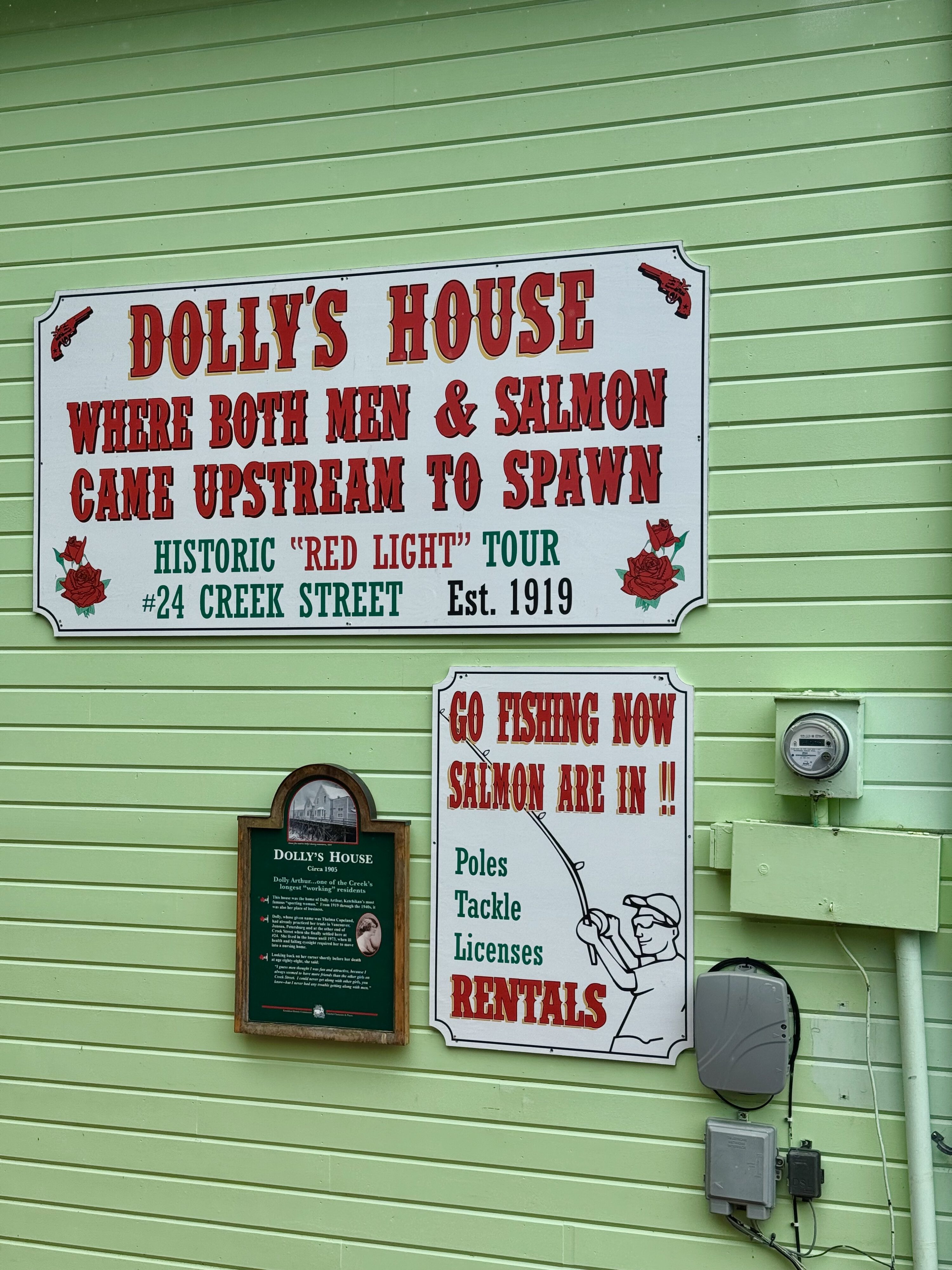
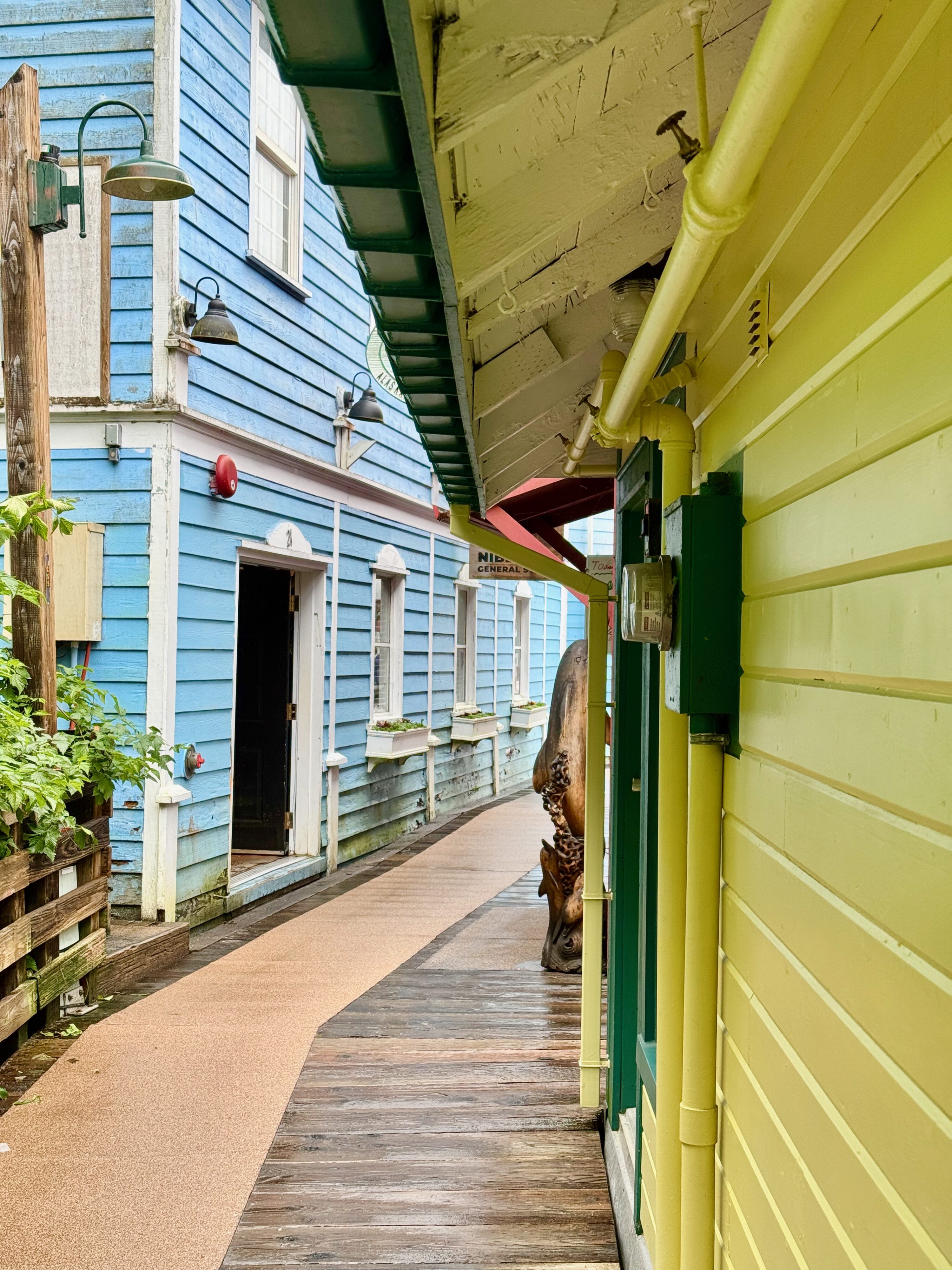
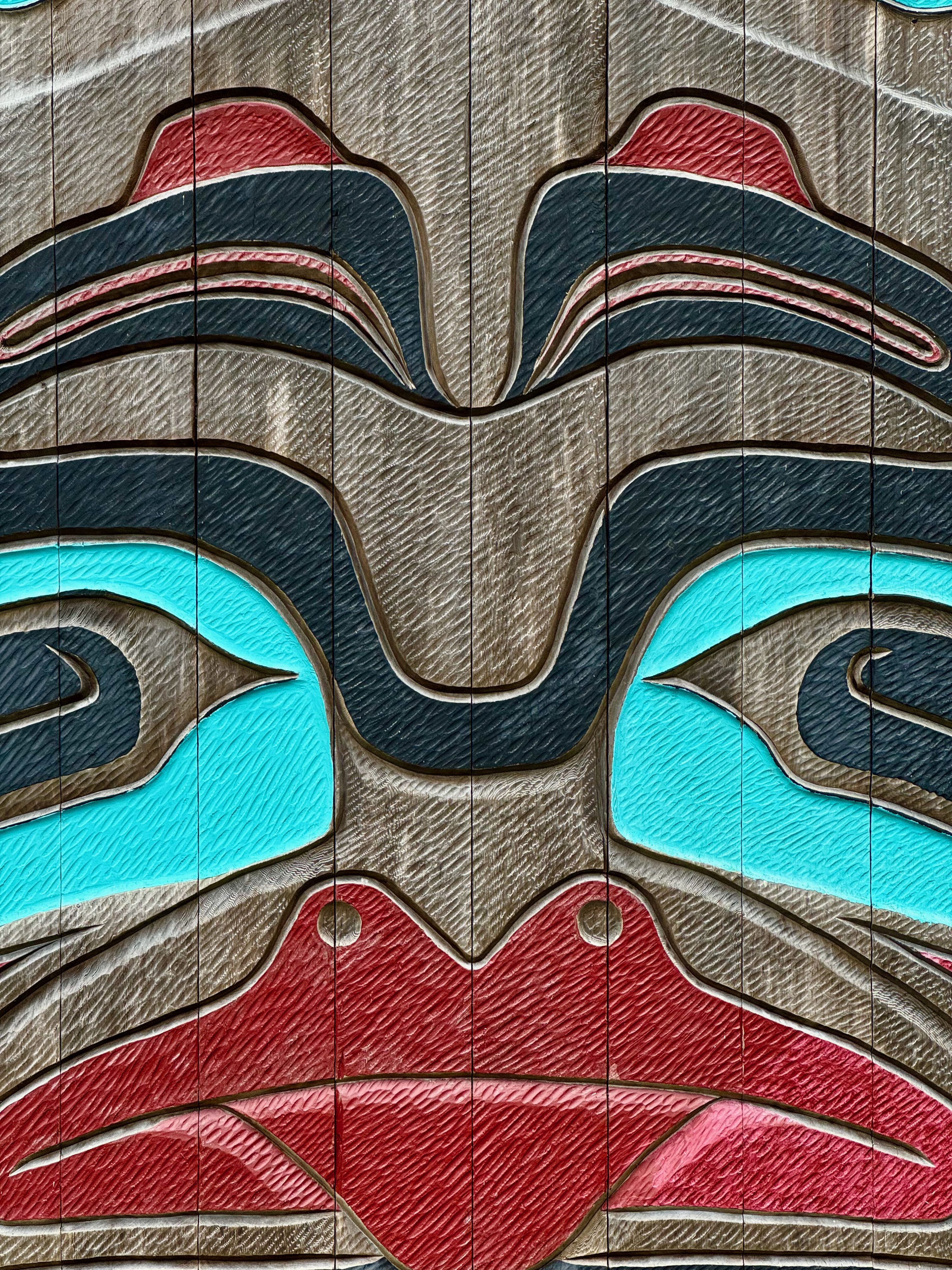
Potlatch Totem Park
Potlatch Totem Park (often called Potlatch Park), just north of Ketchikan, is a delightful blend of Tlingit cultural immersion and a charming vintage car collection—all set in a lush, scenic setting next to Totem Bight State Park. It’s a hidden gem that’s absolutely worth visiting. Here’s why:
Cultural & Historic Highlights
- Recreated Native Village: Explore a main clan house and several tribal dwellings featuring lifelike dioramas that transport you back to 19th-century Tlingit life usa-artmuseum.worldorgs.com+12potlatchpark.net+12potlatchpark.net+12.
- Master Carvers at Work: Watch artisans hand-carving totem poles in the carving shed—no power tools, just traditional skills and stunning craftsmanship reddit.com+13potlatchpark.net+13lonelyplanet.com+13.
- Totem Poles Galore: See around a dozen totem poles, including an impressive 42-foot Raven pole, each with rich clan and mythological symbolism explained by staff.
- Vintage Car Collection
- Tucked into a sheltered pavilion, there is a small but fascinating Antique Car Museum featuring rare vehicles like a 1934 Ford Coupe and a 1924 Stanley Steamer, among other. The cars are kept in excellent condition, offering a delightful peek into early automotive history.
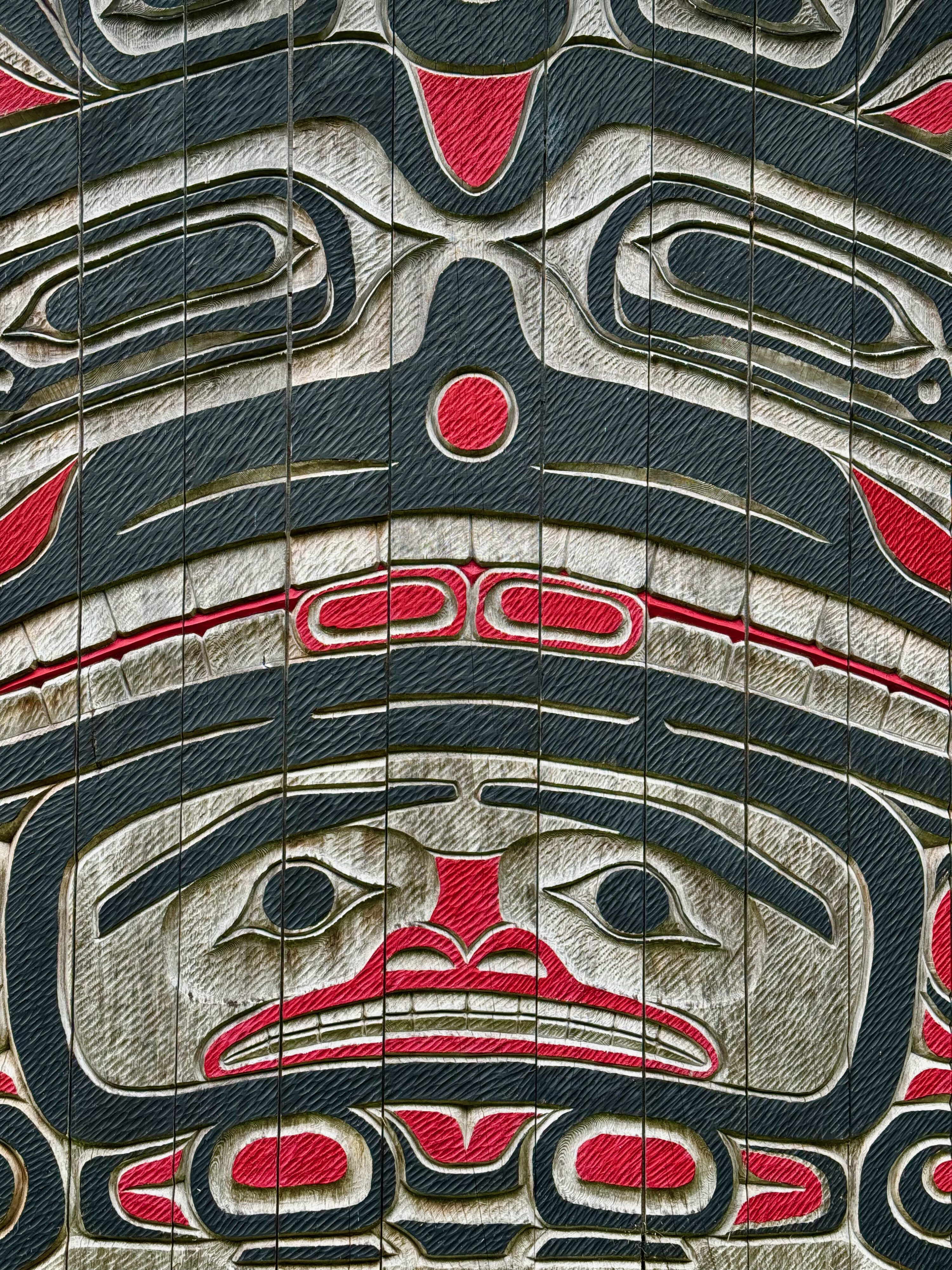
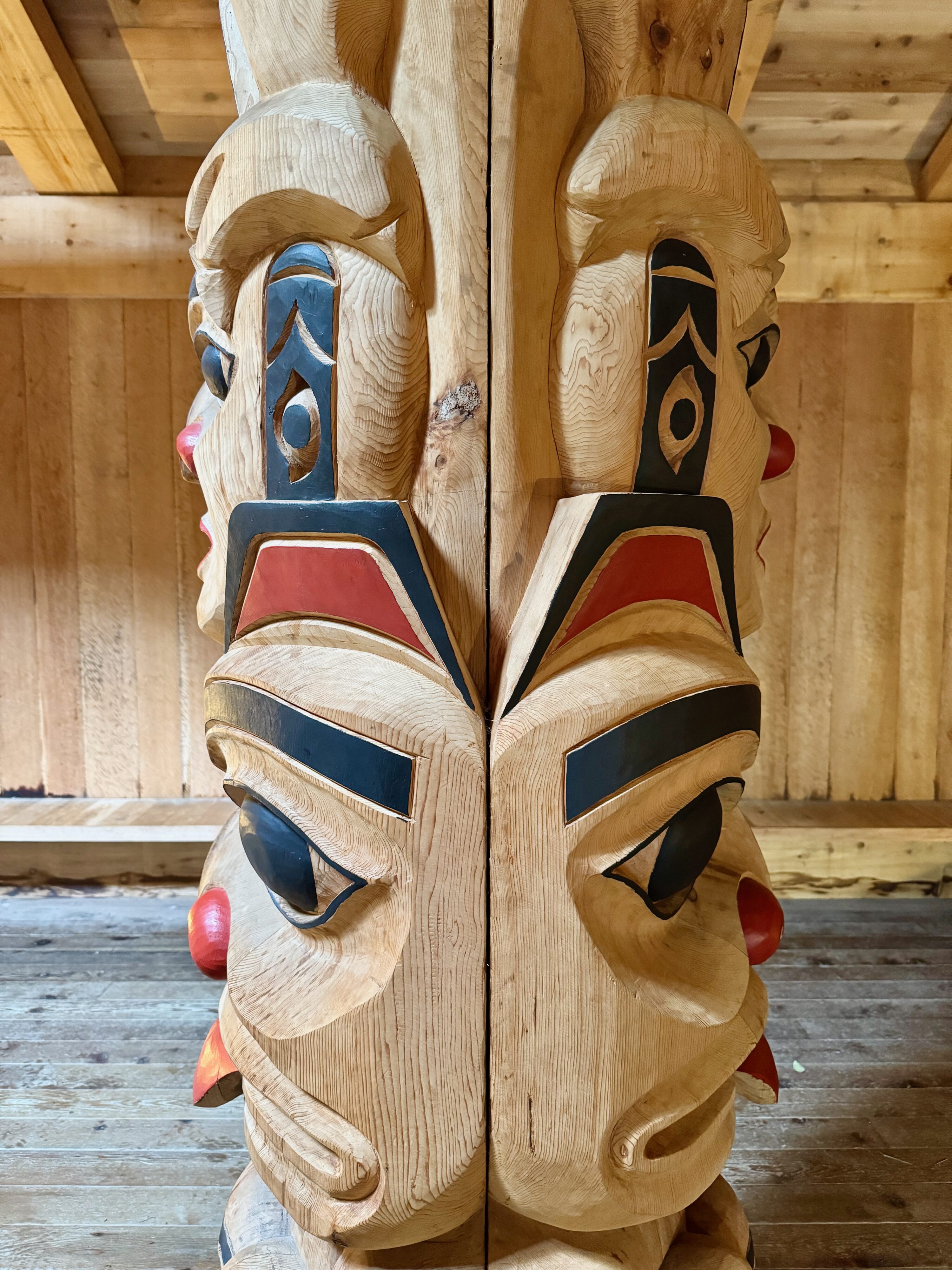
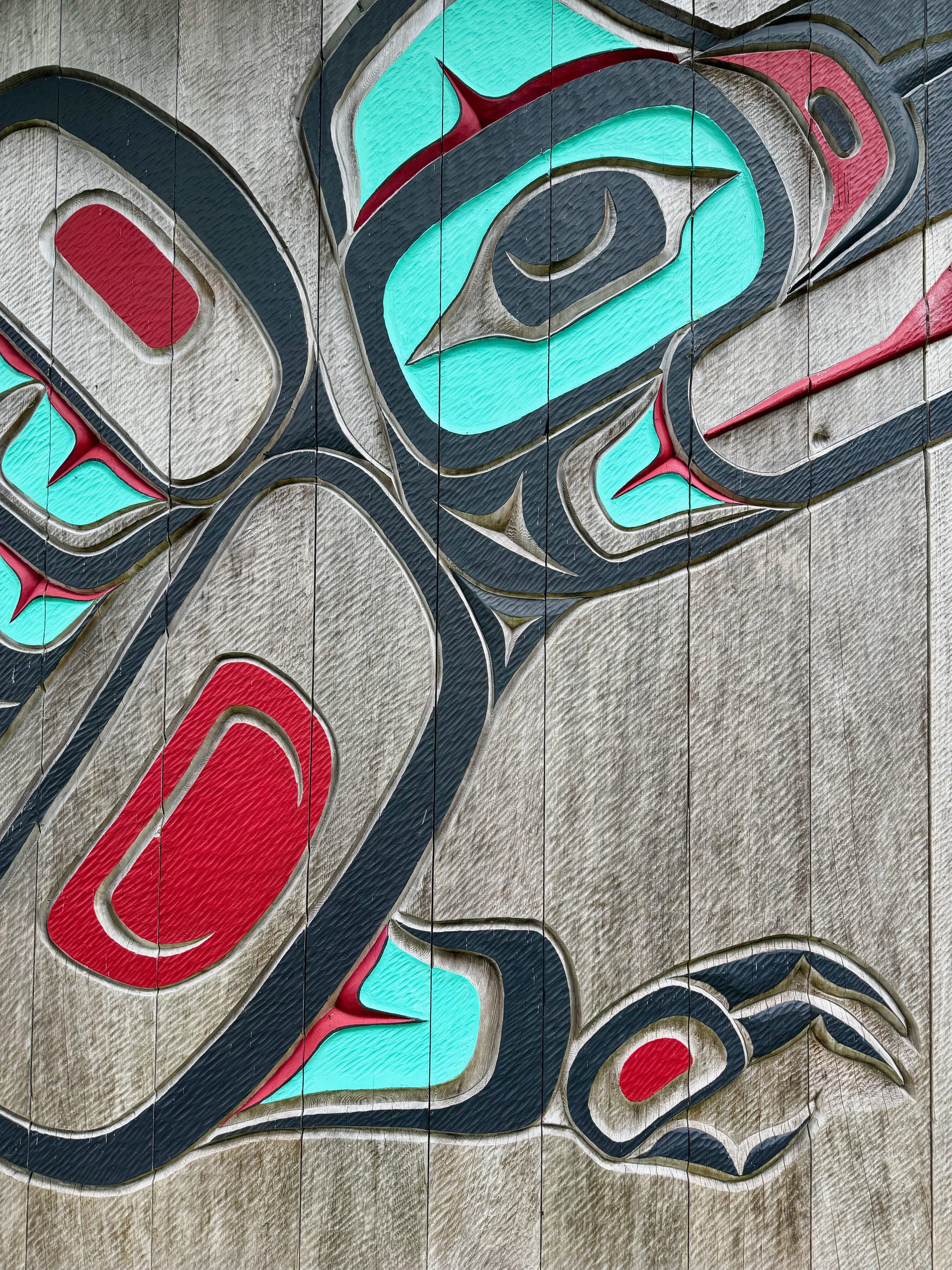
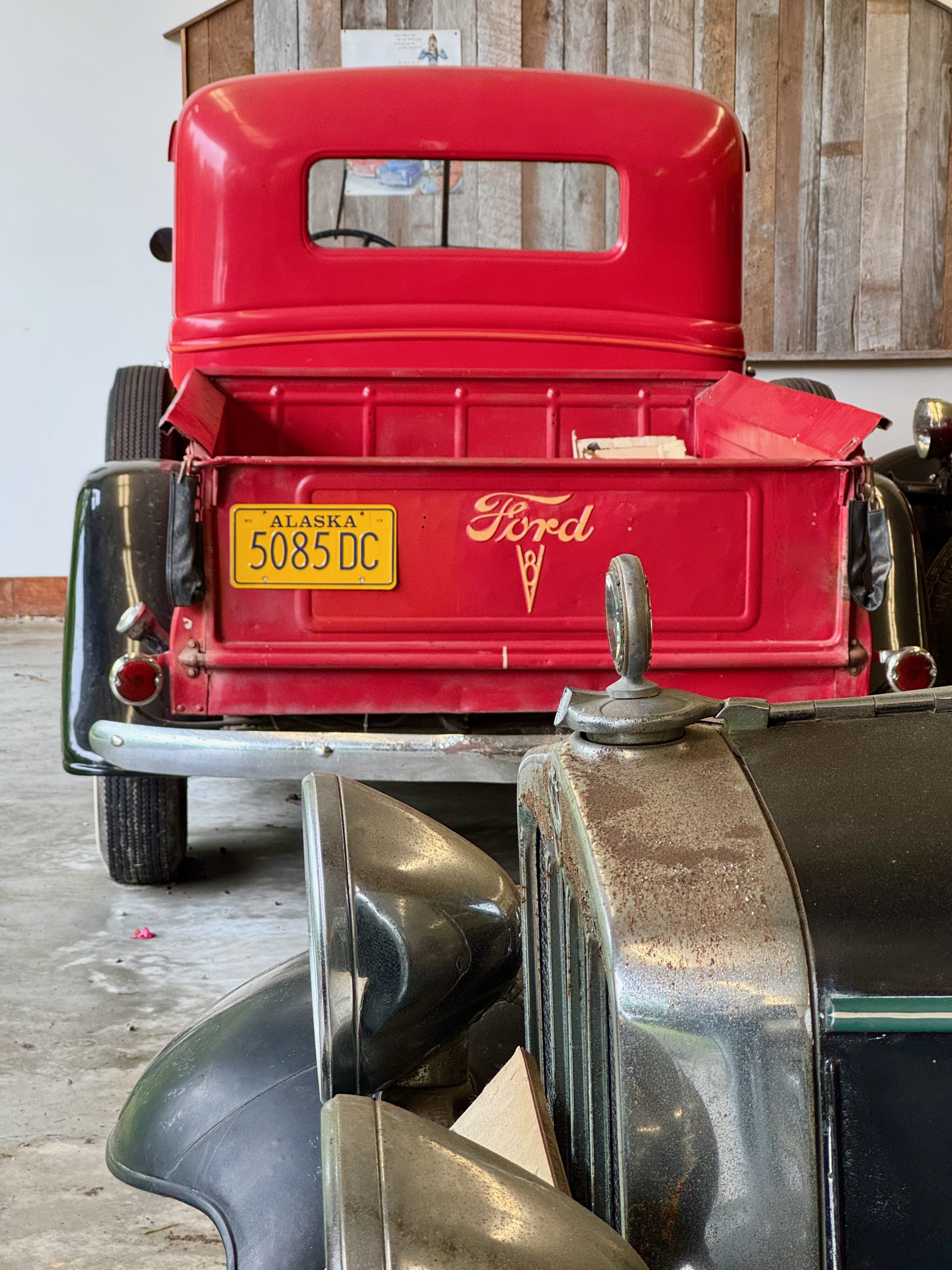
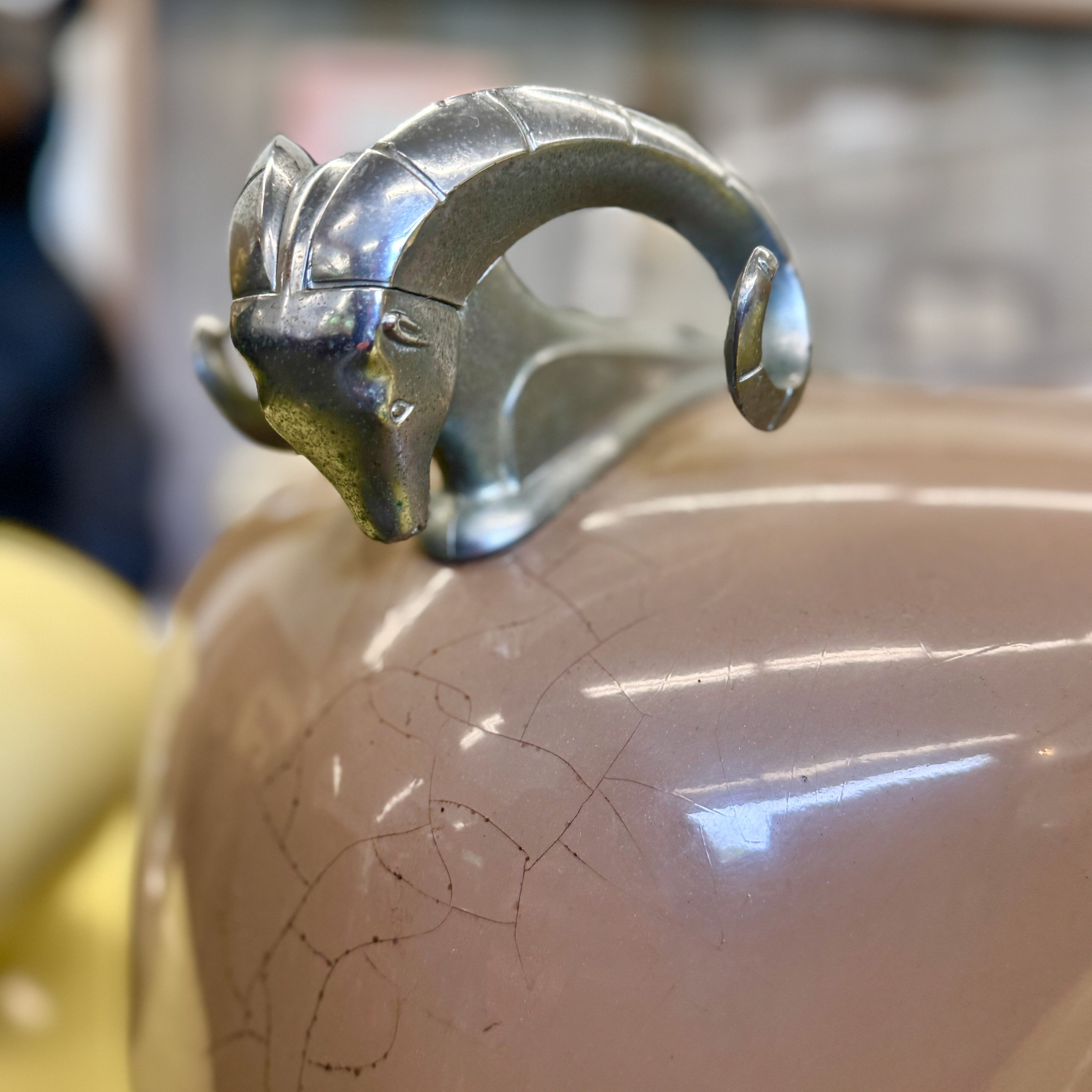
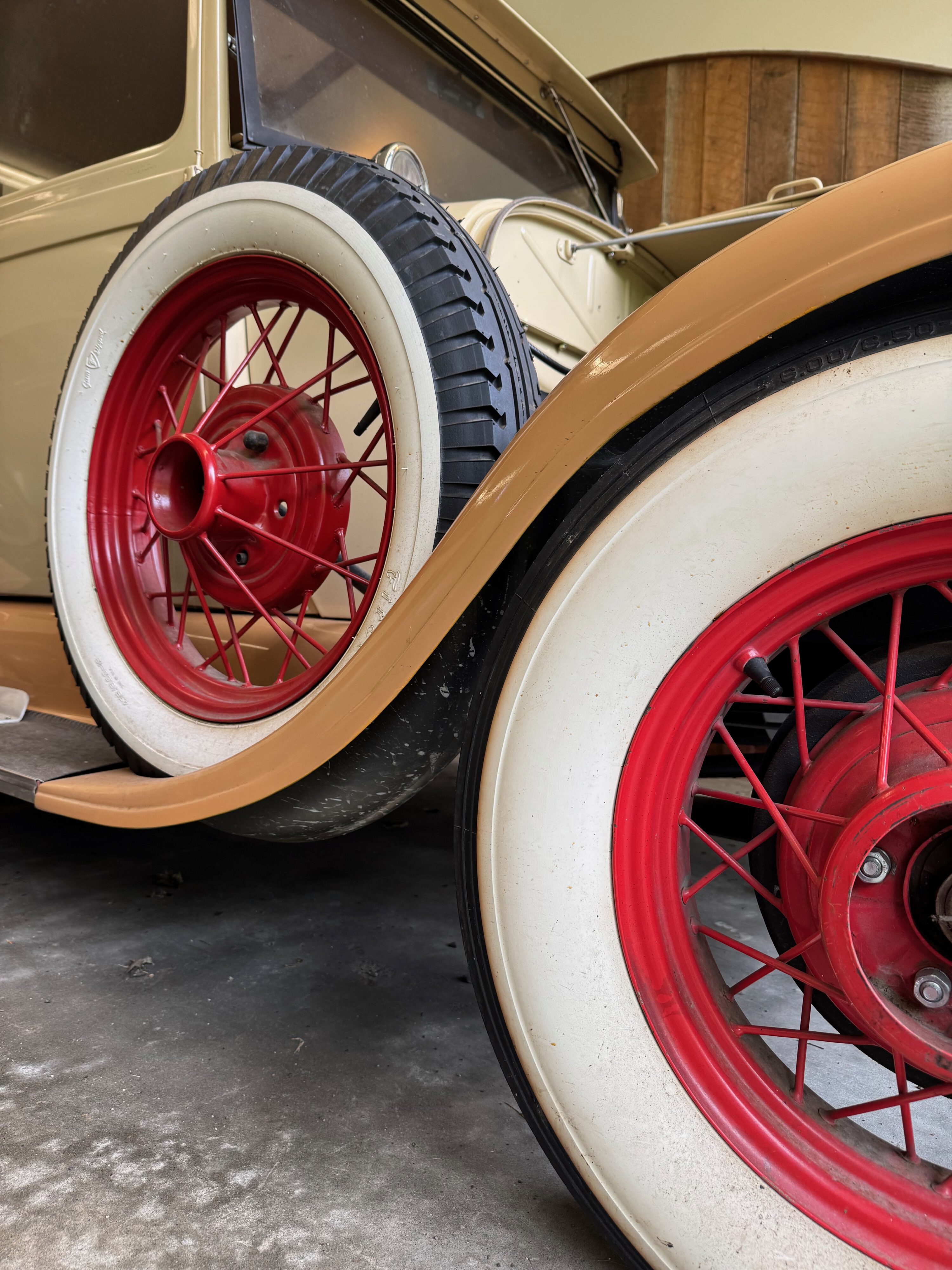
Queen Elizabeth
Cunard’s Queen Elizabeth is a ship that elegantly blends the glamour of ocean liners past with the comfort and refinement of modern cruising. It’s one of Cunard’s three Queen-class ships (alongside Queen Mary 2 and Queen Victoria) and carries forward the traditions of British luxury, formality, and high style.
Queen Elizabeth channels the Golden Age of Ocean Travel with sweeping staircases, wood paneling, chandeliers, and art deco flourishes. Her design draws inspiration from Cunard’s earlier liners (including the original Queen Elizabeth from 1938) and wraps them in a sophisticated, modern package.
Gleaming brass and rich carpeting evoke 1930s glamour. Grand Lobby with a central staircase and art-deco mural. Library with a spiral staircase and over 6,000 books.
Formal Nights: A Step Back in Time
Cunard is one of the few cruise lines that still honors traditional formal nights—and they do it exceptionally well. These are not just dress-up nights—they’re events, central to Cunard’s identity.
Queen Elizabeth isn’t about thrills or flashy gimmicks—it’s about understated elegance, tradition, and the joy of slowing down in style. Formal nights aren’t obligatory, but embracing them makes you feel like you’ve stepped into a bygone world where travel was as grand as the destination.
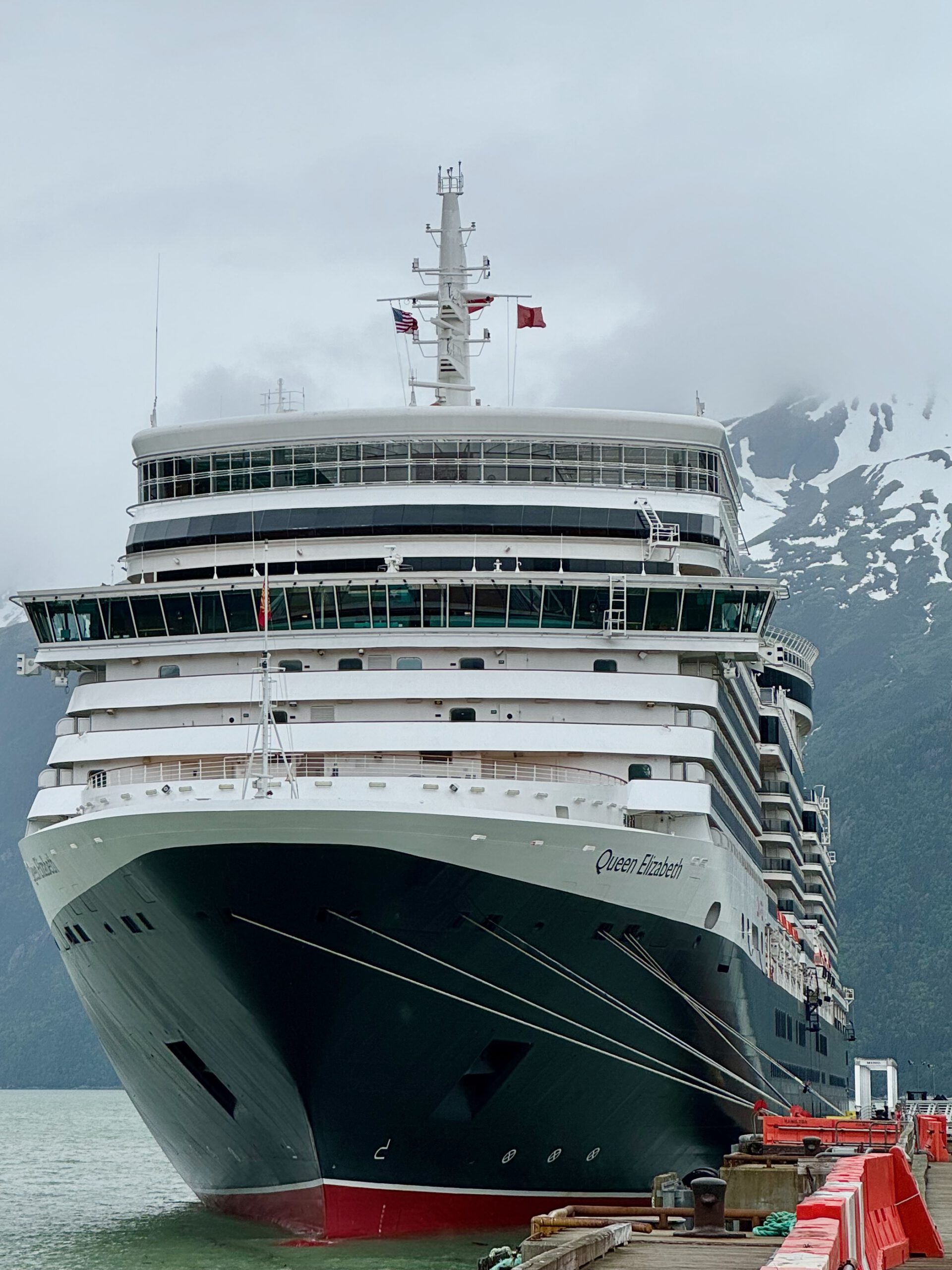
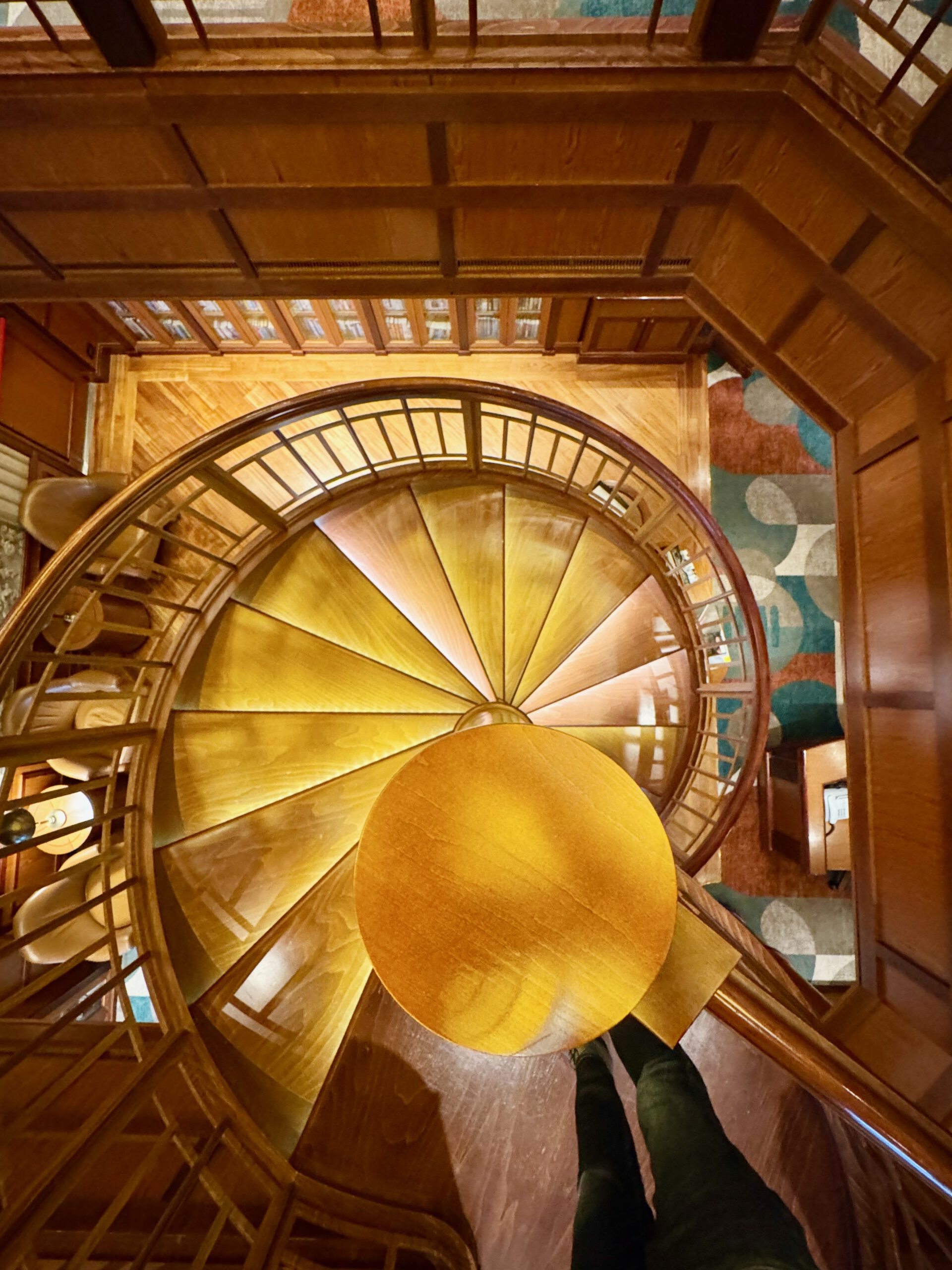
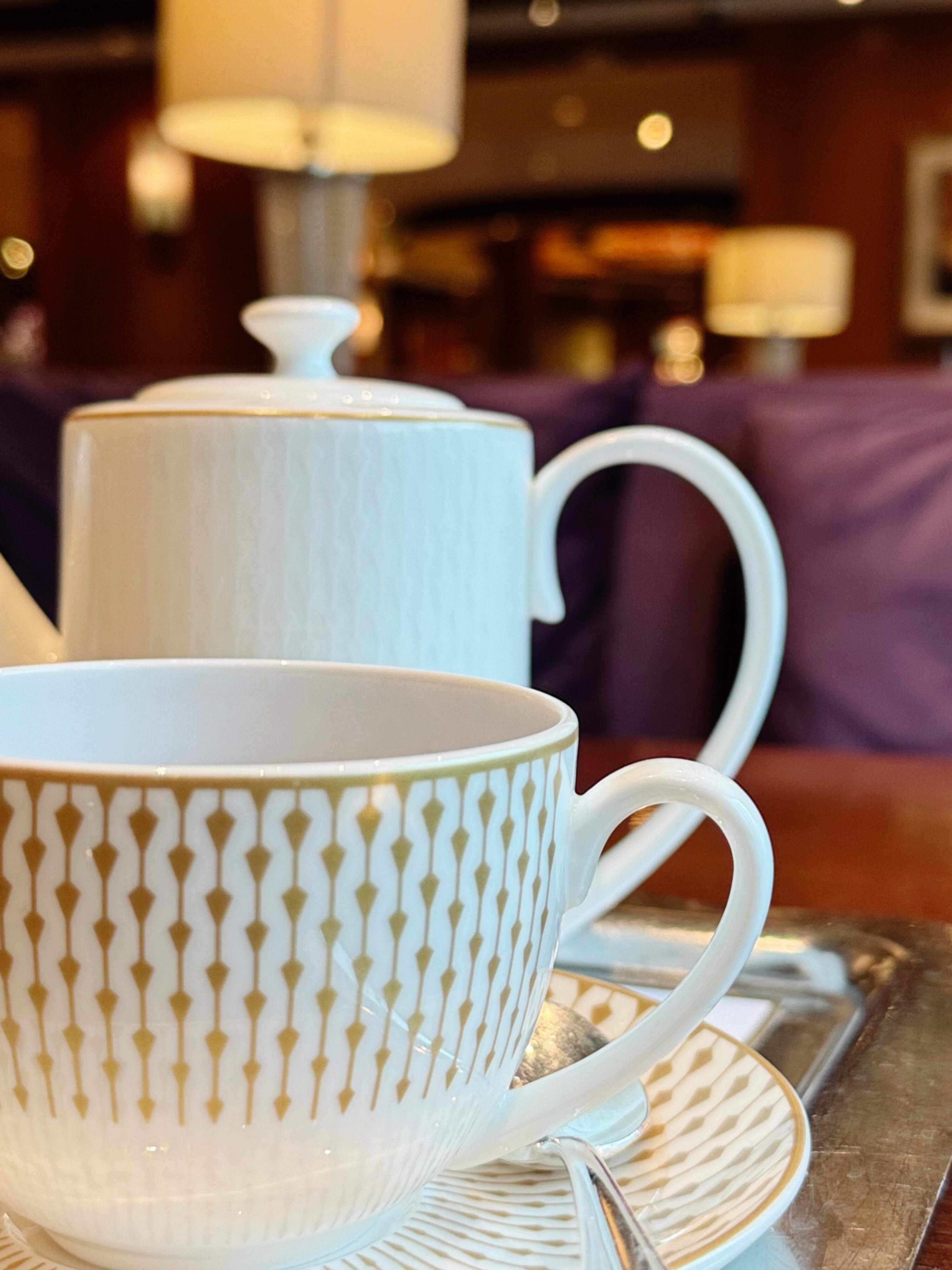
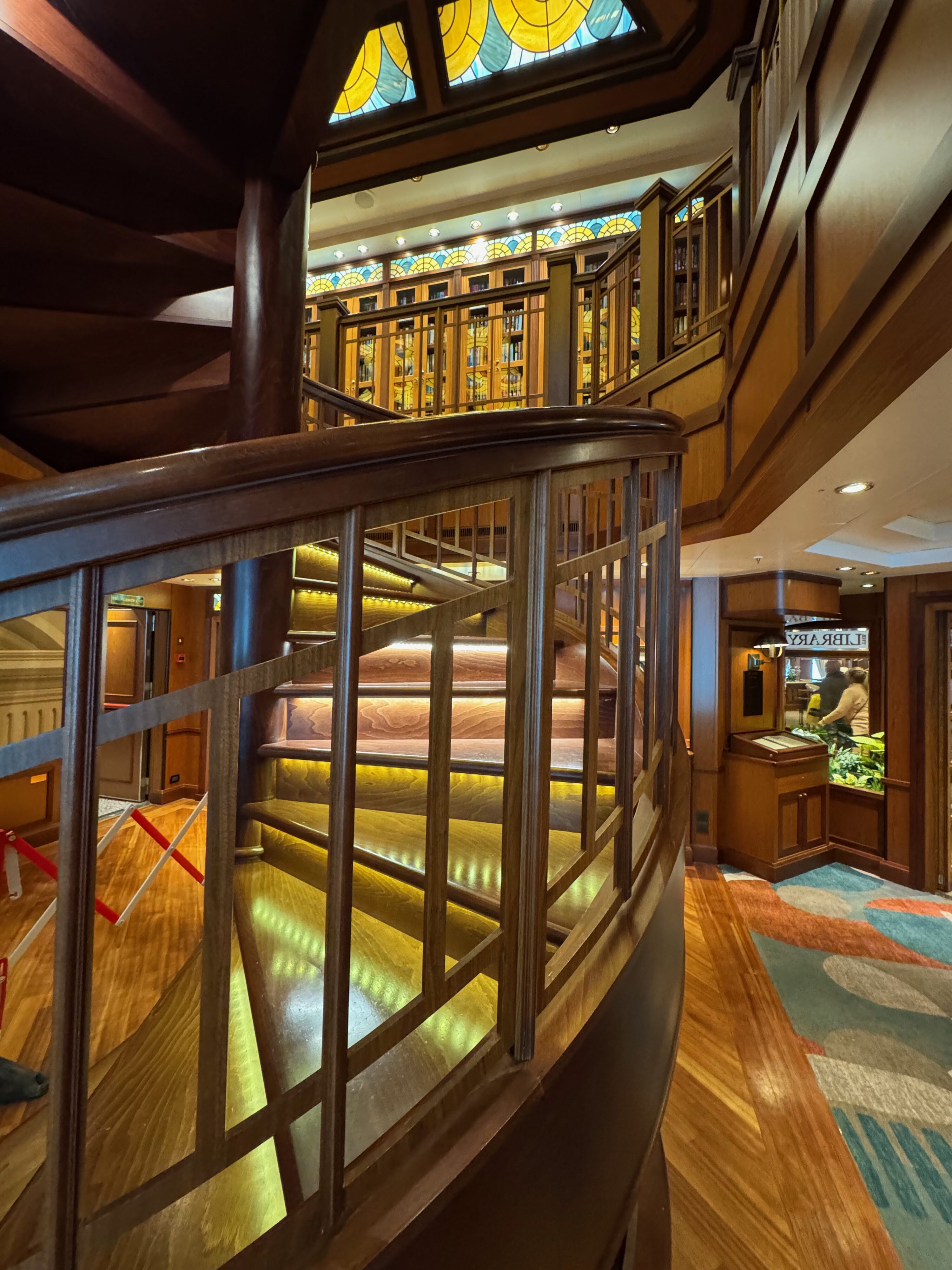
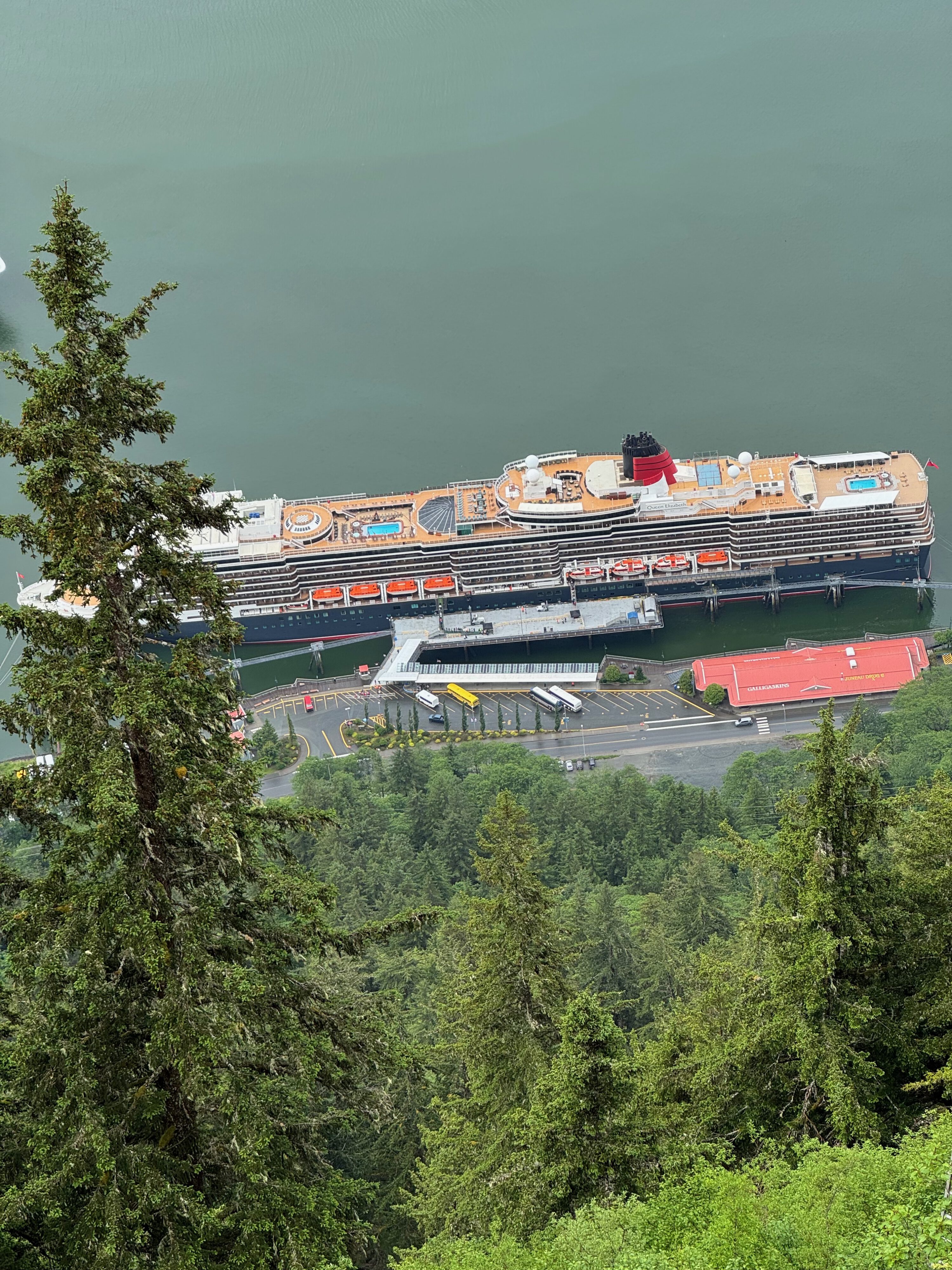
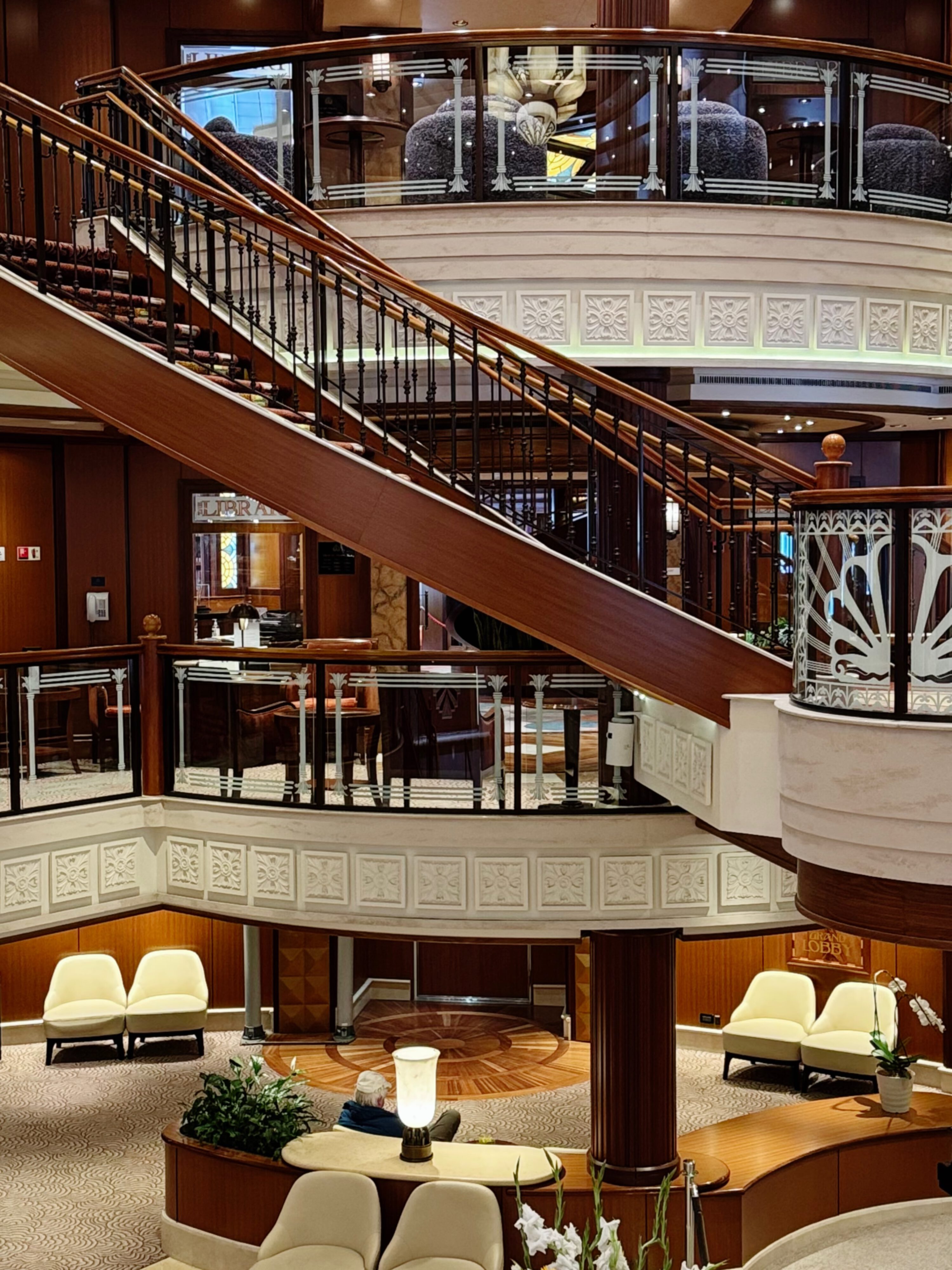
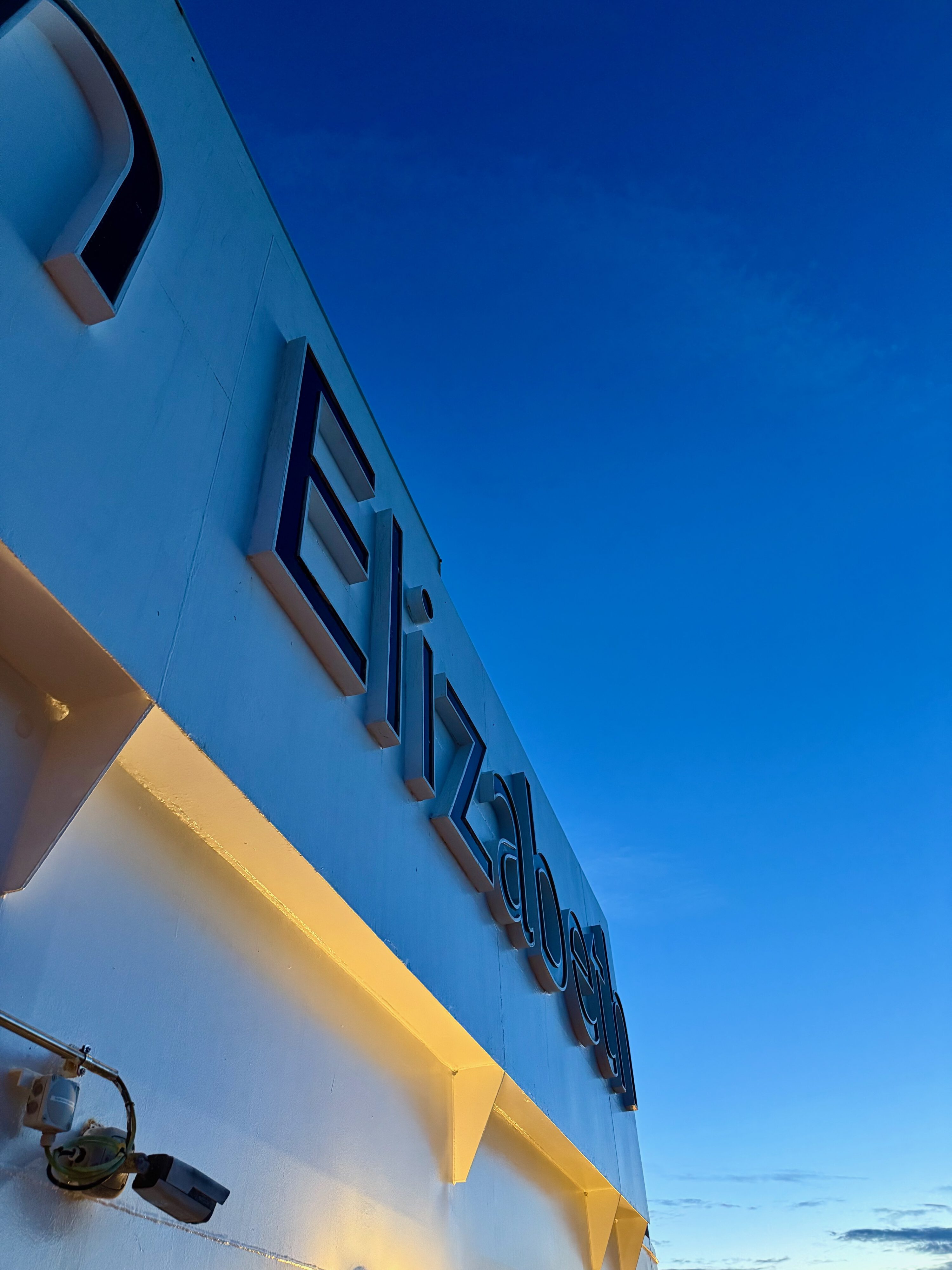
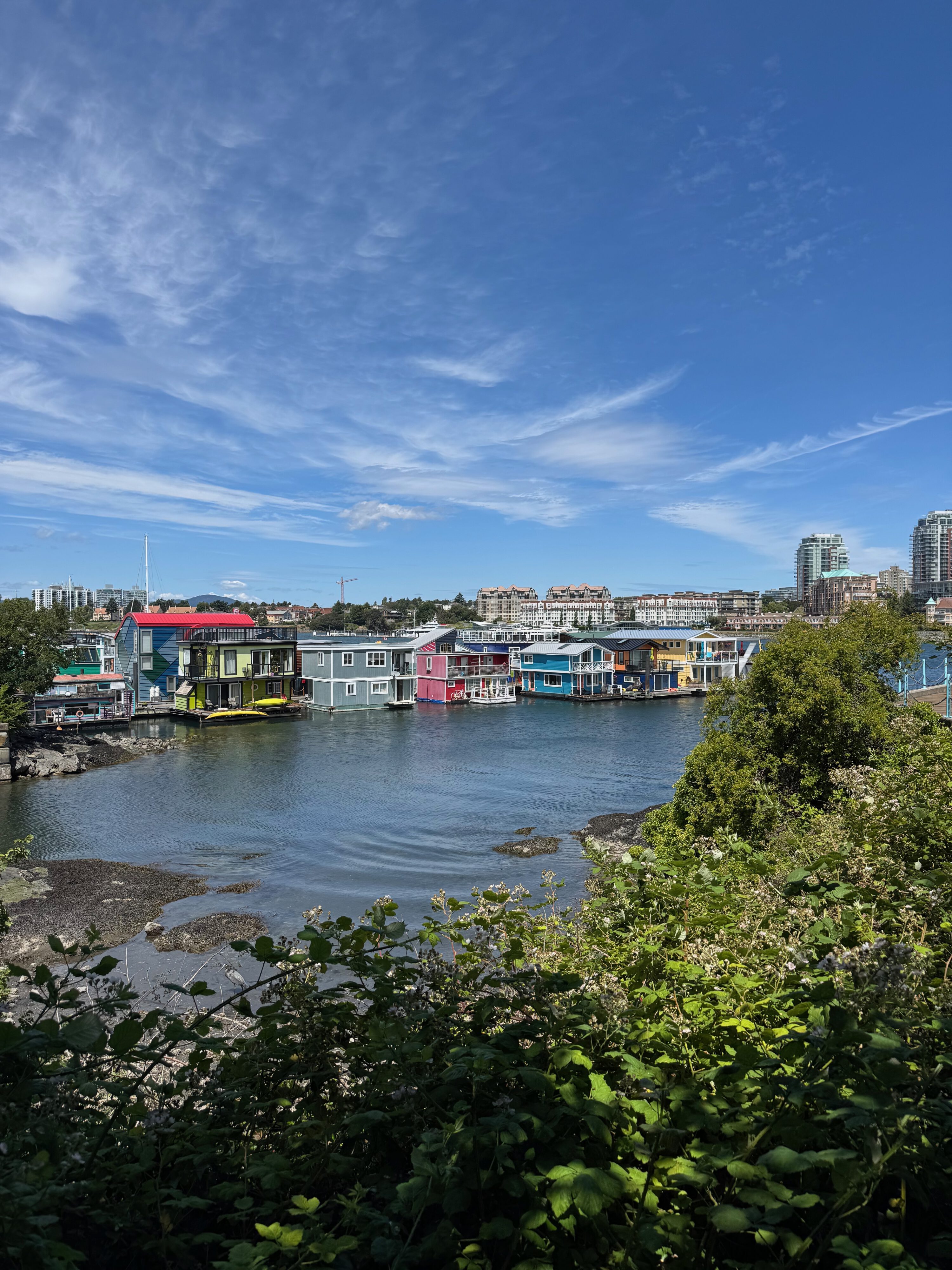
Last Port of Call: Victoria B.C.
Victoria, B.C. is one of the most charming and culturally rich ports of call on any Pacific Northwest or Alaska cruise itinerary. Often a brief evening stop, it still manages to leave a lasting impression thanks to its British colonial flair, lush gardens, walkable waterfront, and quaint, old-world character. Here’s why it’s worth your time—especially Fisherman’s Wharf and Craigdarroch Castle.
Old-World Charm Meets West Coast Beauty
Victoria blends English elegance with Pacific coastal vibrancy. Think: historic buildings and afternoon tea, whale-watching and floating homes, horse-drawn carriages, double-decker buses, and harbor seals.
Located just a 10–15 minute walk (or water taxi ride) from the Inner Harbour, Fisherman’s Wharf is a floating village of houseboats, eateries, and marine life. It’s not a big attraction—but it’s a delightful, photogenic, and immersive little detour.
Seafood with a View: Grab fresh fish & chips, tacos, or oysters and eat dockside.
harbor seals & otters: Friendly seals often pop up near the docks, hoping for fish scraps (feeding is discouraged but they’re curious).
People-Watching & Chill Vibes: Fisherman’s Wharf is informal, eclectic, and ideal for relaxing with a cone or camera.
Craigdarroch Castle
Craigdarroch Castle is a Victorian-era mansion built in the 1890s by coal baron Robert Dunsmuir. It’s a stunning example of wealth, ambition, and turn-of-the-century opulence—perched on a hill above the city with views stretching to the ocean and mountains.
You’ll step back into an era of grandeur and ambition—perfect for history lovers, architecture buffs, or Downton Abbey fans.
It’s about 25–30 minutes on foot or 10 minutes by taxi from downtown—also included in many shore excursions.
What Makes It Special
- Architectural Masterpiece: Romanesque Revival style with stone towers, stained glass, and steep gables. Inside, expect:
- Intricately carved wood paneling
- Ornate fireplaces
- A grand oak staircase that rises four floors
- Period Furnishings: Much of the home is filled with authentic late-1800s décor, giving a real sense of Victorian life.
- Panoramic Views: Climb to the turret tower for an incredible 360° view over Victoria.
- Family Drama: The Dunsmuir family history is full of intrigue—wealth, feuds, and scandal.
